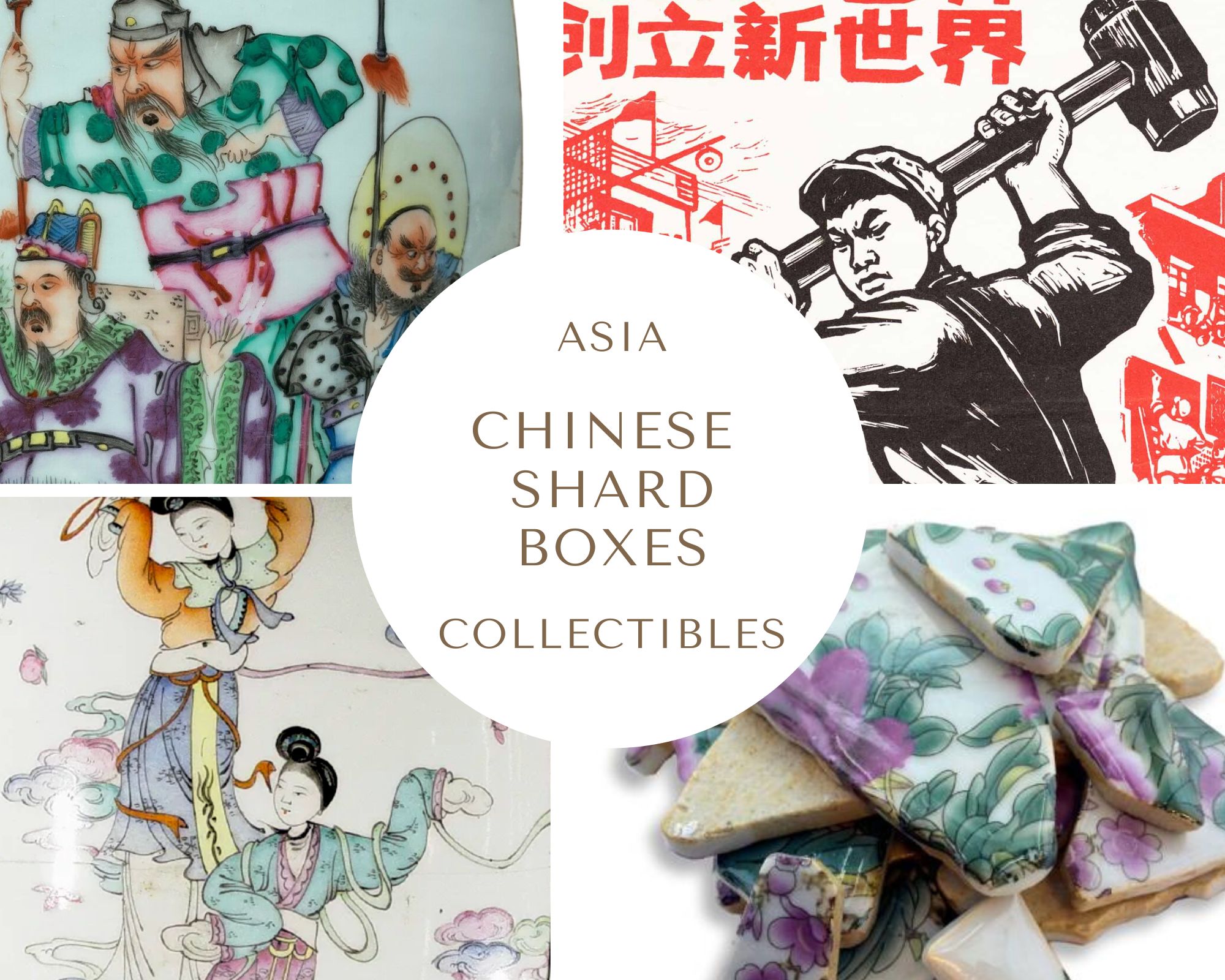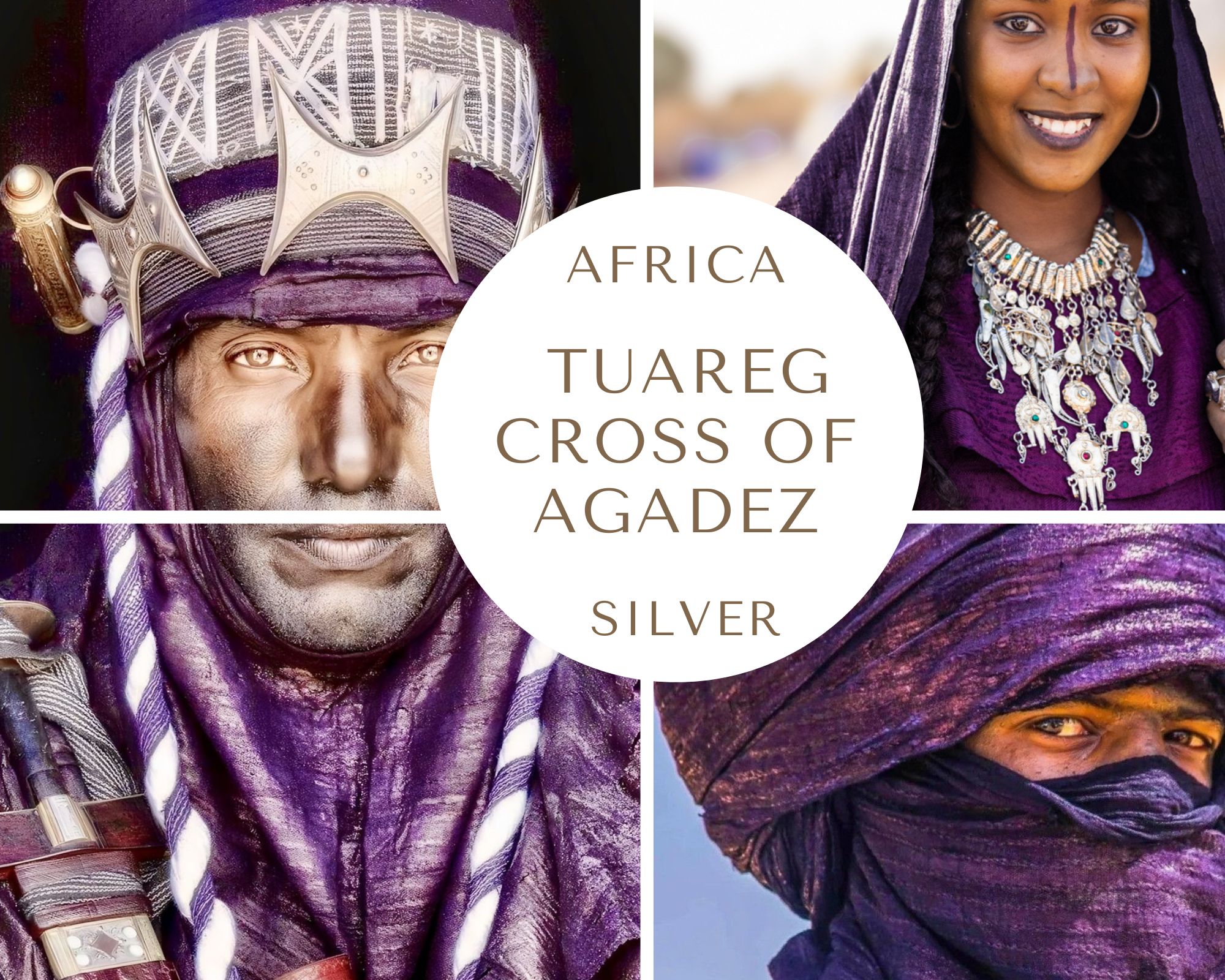NAVAJO CHURRO SHEEP AND WOOL 8
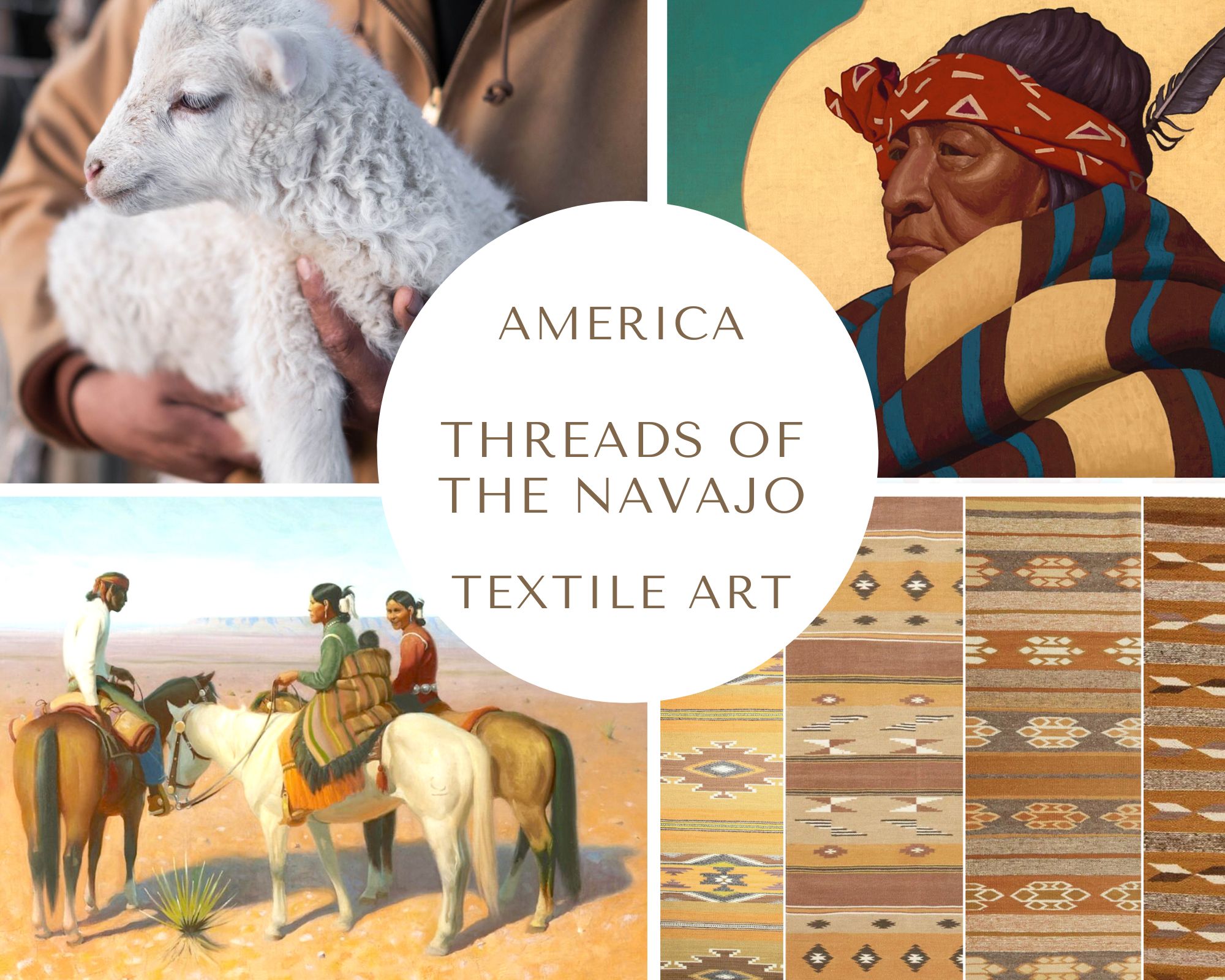
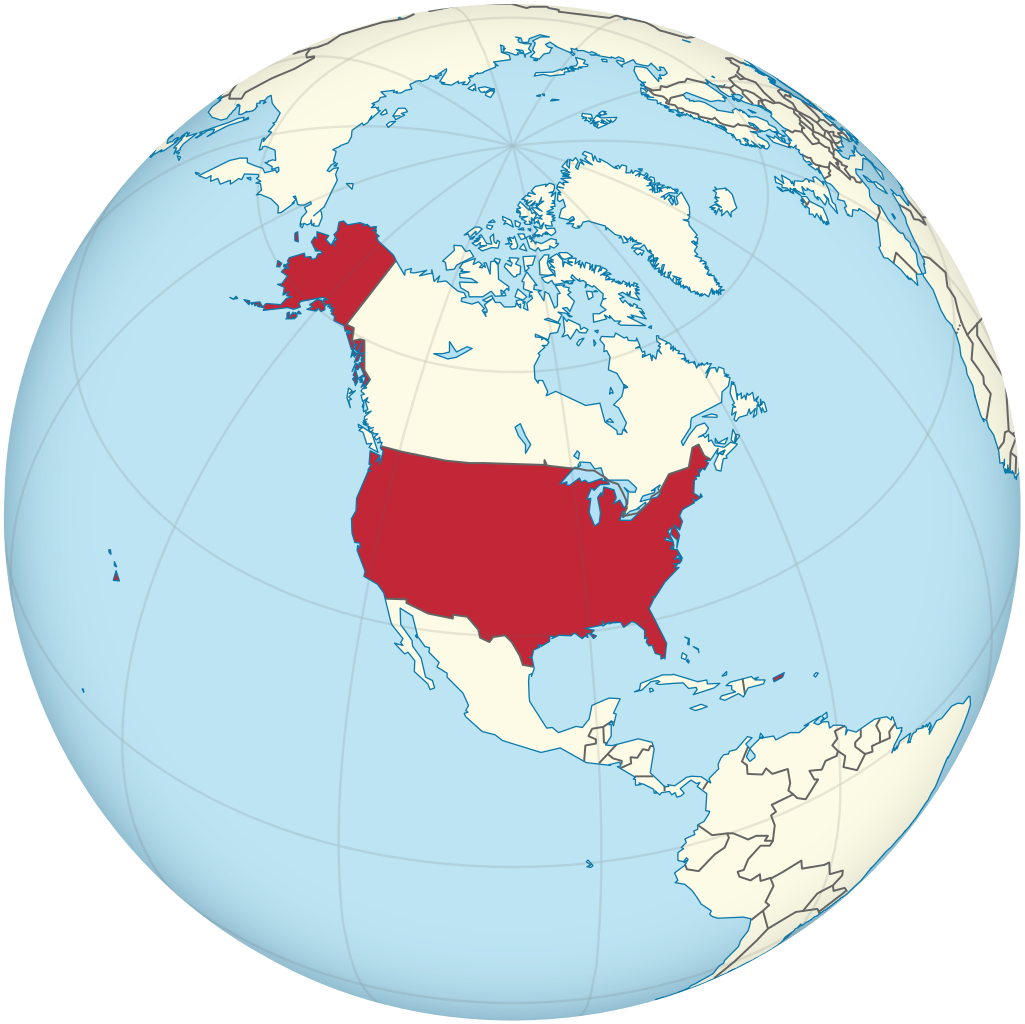
USA on the globe.
Licensed under the Creative Commons Attribution-Share Alike 3.0 Unported.
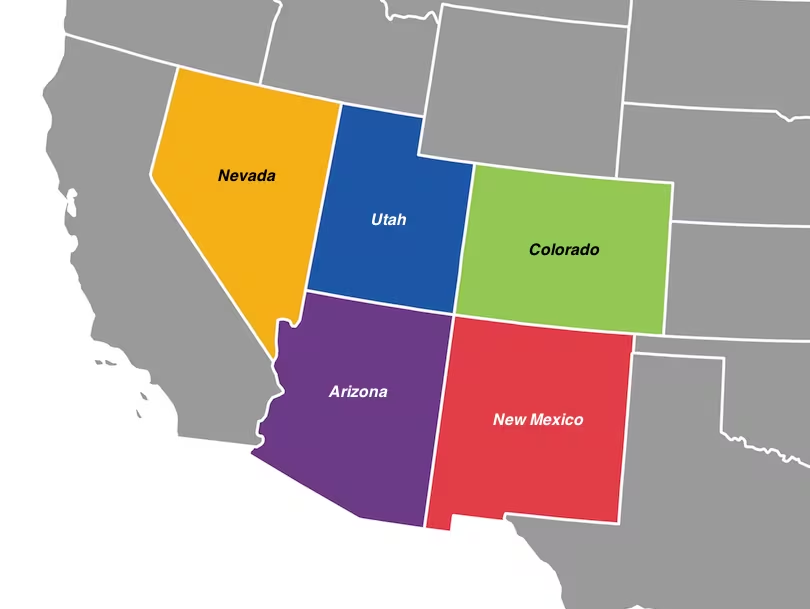
SOUTHWESTERN STATES
CRYSTAL TRADING POST AND CRYSTAL STYLE
The evolution of the distinctive and historically significant Crystal style, one of the most notable regional patterns in Navajo textile art, spans over a century and encompasses three distinct periods, each with unique characteristics.
1. The J.B. Moore Crystal Period (1896–1911)
The J.B. Moore Crystal Period marks one of the most transformative chapters in the history of Navajo weaving—an era defined by innovation, commercialization, and artistic evolution. During this time, foundational design elements emerged that would influence Navajo textile art for generations.
John Bradford Moore, born in Texas in 1855, was an enterprising businessman with extensive experience across the American West. In 1896, he secured trading rights to a remote site at the western end of Narbona Pass (formerly Washington Pass) in the Chuska Mountains near the New Mexico–Arizona border. The location, then used only seasonally for trade, lacked any permanent structures. With vision and determination, Moore harvested timber from the surrounding forests and built a log trading post, naming it “The Crystal Trading Post.” His efforts established a permanent economic and cultural outpost in this secluded region.
To support his enterprise, Moore transported goods from Gallup, the nearest railroad hub, effectively linking this remote area to national markets. His business philosophy was ahead of its time: It is also our mission here to buy any and everything the Navajo has to sell... to sell him in turn... everything, in fact, that he has need for. (Moore, 1911)
This approach positioned the Crystal Trading Post not only as a center of commerce but also as a cultural crossroads.
Situated south of Two Grey Hills, north of Window Rock, and at the western mouth of Narbona Pass, the Crystal Trading Post became the heart of Moore’s growing Navajo rug business until his departure in 1911. Though the original log building has since been lost—reportedly destroyed in recent years—its legacy endures.
BELOW
Winter landscape along the Indian Service Route 134, near Narbona Pass in the Chuska Mountains. Ph.: Brandon N. Sanchez | Independent.
Moore’s most lasting contribution to Navajo weaving was his pioneering marketing strategy. In 1903, he became the first reservation trader to publish a mail-order catalog featuring Navajo rugs. This groundbreaking initiative expanded the audience for Navajo textiles far beyond the Southwest, especially into urban centers on the East Coast. The catalog introduced a wide range of weaving styles, with a particular emphasis on what would become known as the Crystal style—characterized by symmetrical compositions, bordered designs, and the integration of nontraditional motifs.
Encouraged by the success of his first catalog, Moore published a second edition in 1911. Modeled on the booming mail-order businesses of the time—Sears Roebuck and Montgomery Ward among them—his catalogs featured numbered designs labeled with Roman numerals. Customers could select designs by plate and request variations in size, color, and weave quality. This method helped standardize production and broaden appeal, transforming Navajo weaving from a regional tradition into a nationally recognized art form.
The 1911 catalog, a concise 33-page booklet, showcased both standard and customizable designs. For the weavers affiliated with the Crystal Trading Post, these catalog plates served not as rigid templates, but as sources of inspiration—encouraging reinterpretation, adaptation, and artistic variation. This blend of structure and freedom became a hallmark of the Crystal style and set the stage for its evolution throughout the 20th century.
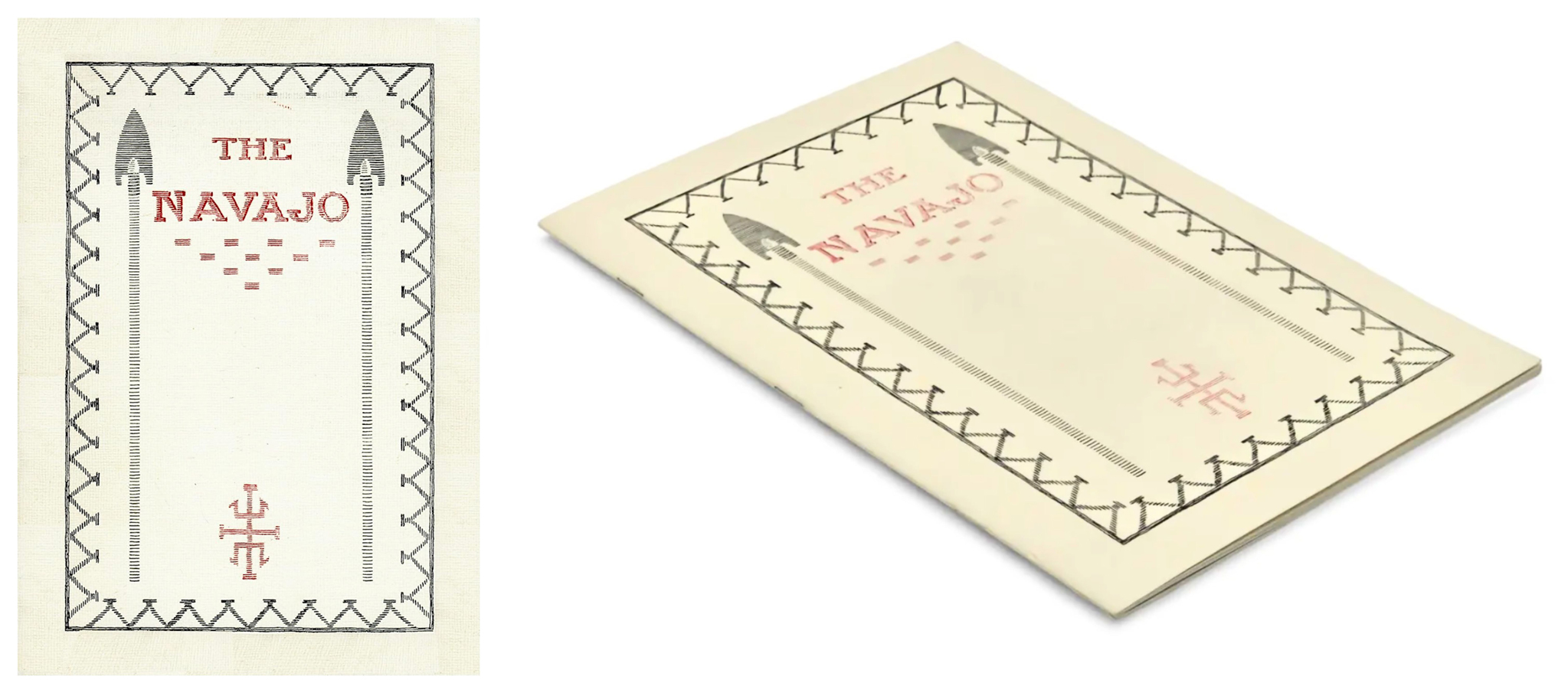
The 1911 J.B. Moore Catalog is a short booklet with only 33 pages. Browse it here.
BELOW
Two double-page spreads from the 1911 catalog with black-and-white illustrations.

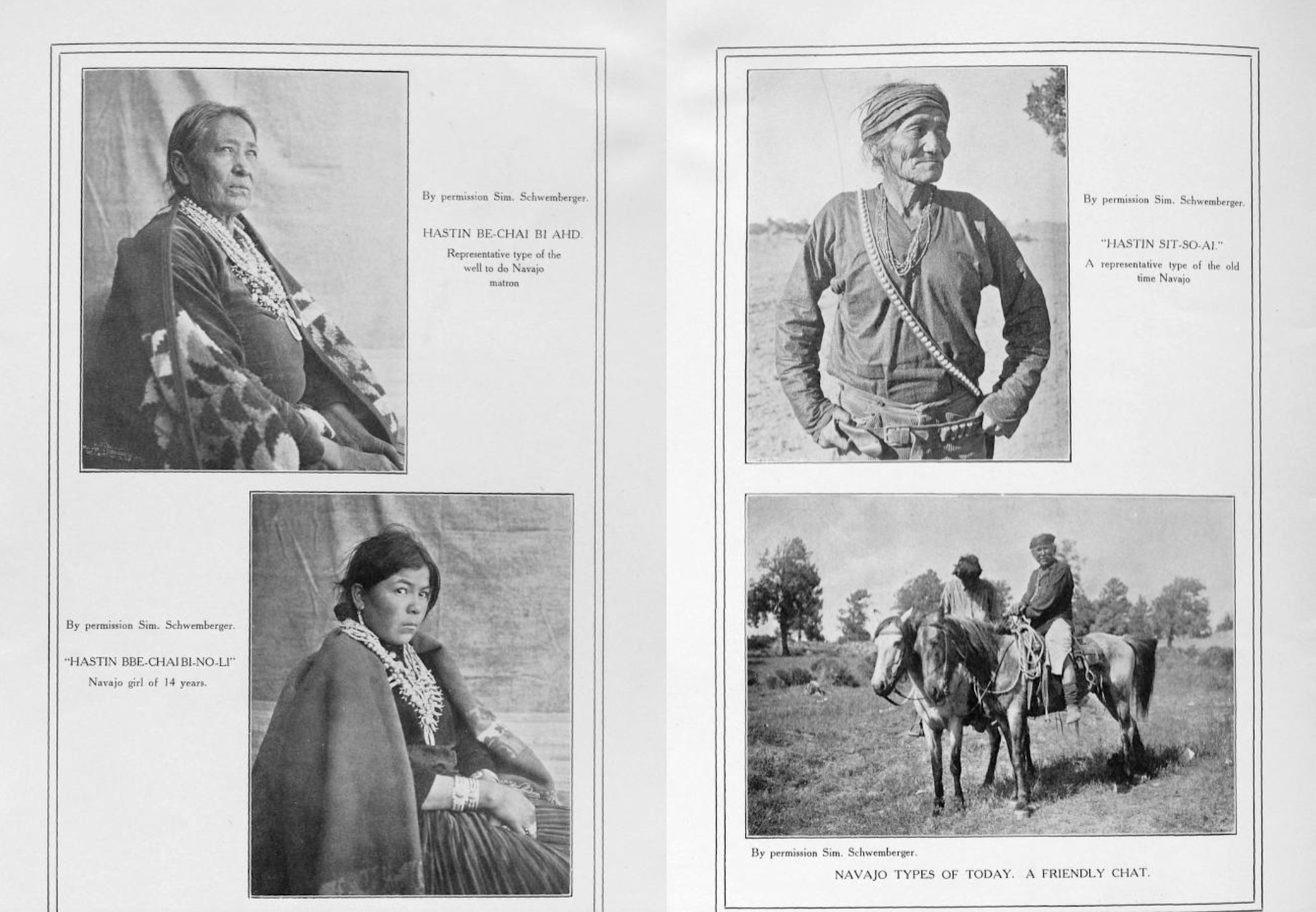
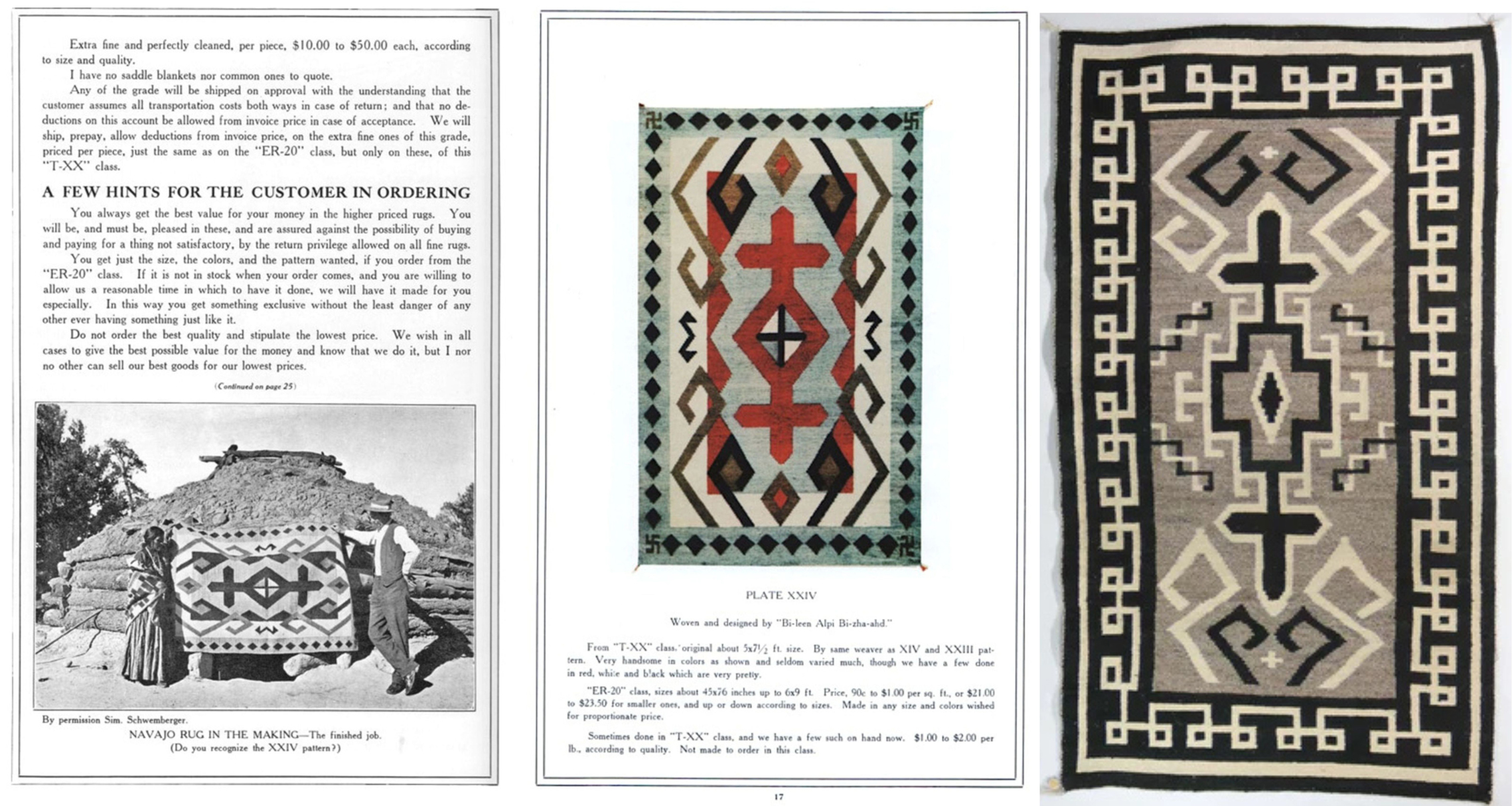
The "Navajo Rug in the Making" pictured in the 1911 catalog is available for purchase and customization in Plate XXIV. On the right is a variant of Plate XXIV: a rug made in the 1920s based on a J.B. Moore design. Clearly, the rugs illustrated in the catalog plates served as sources of inspiration that left room for personal creativity rather than models to be copied slavishly.
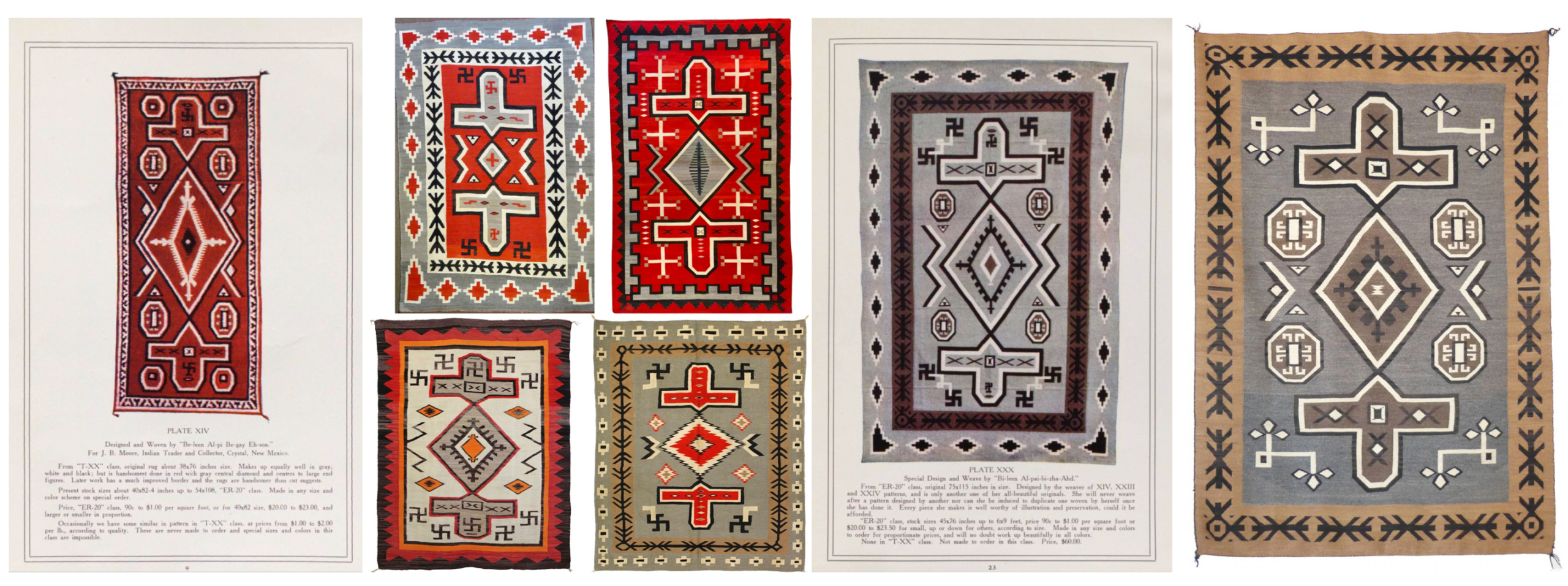
LEFT: Plate XIV (14th) of the 1911 Catalog.
CENTER LEFT, CLOCKWISE, FROM THE LEFT:
1. JB Moore Crystal Navajo Rug, 1910s. Dimensions: 58 x 88 in.; 147.32 × 223.52 cm. Toh-Atin Gallery, Durango, Colorado.
2. JB Moore Crystal Rug. Medium: Hand-carded and hand-spun Navajo Churro wool with aniline dyes. Date: ca. 1915. Dimensions: 55 x 91 in.; 139.7 x 231.14 cm. Sage Gallery, Wickenburg, AZ.
3. Variant of J.B. Moore’s Plate XXX Rug,1910-1920. Medium: Navajo Churro wool and pigment. Dimensions: 98 x 82 in.; 248.92 x 208.28 cm. Bowers Museum, Santa Ana, CA.
4. Variant of J.B. Moore’s Plate XXX Rug, ca. 1920. Medium: Medium: wool and pigment. Dimensions: 69 1/2 × 54 in.; 176.53 × 137.16 cm. Bowers Museum Santa Ana, CA.
CENTER RIGHT: Plate XXX (30th) of the 1911 Catalog.
RIGHT: Navajo J. B. Moore Plate XXX Rug, 1910s. Medium: handspun wool in natural ivory, tan, brown, gray and over-dyed black. Dimensions: 87 x 59 in.; 220.98 x 149.86 cm. Shiprock, Santa Fe, NM. «Known as one of the most decorative designs from JB Moore’s famed 1911 catalog, this is a spectacular example of Plate XXX with an extremely fine weave. The central design features elaborate geometric designs in ivory, brown and black all on a gray field. The field is bordered by a broad band of tan with black barbed wire motif along the interior.» (Shiprock Art Gallery)
After J.B. Moore left Crystal Trading Post in 1911, his partner, Jesse Molohon, took over the business and maintained the stylistic direction Moore had established. However, adherence to the patterns in the 1911 catalog gradually became less strict; many rugs exhibit significant interpretations of the original designs. Rugs made after 1911, especially those from the 1920s and early '30s, feature more complex, rich, and aesthetically interesting variations of the original patterns. In short, they are more beautiful. Here are some examples.
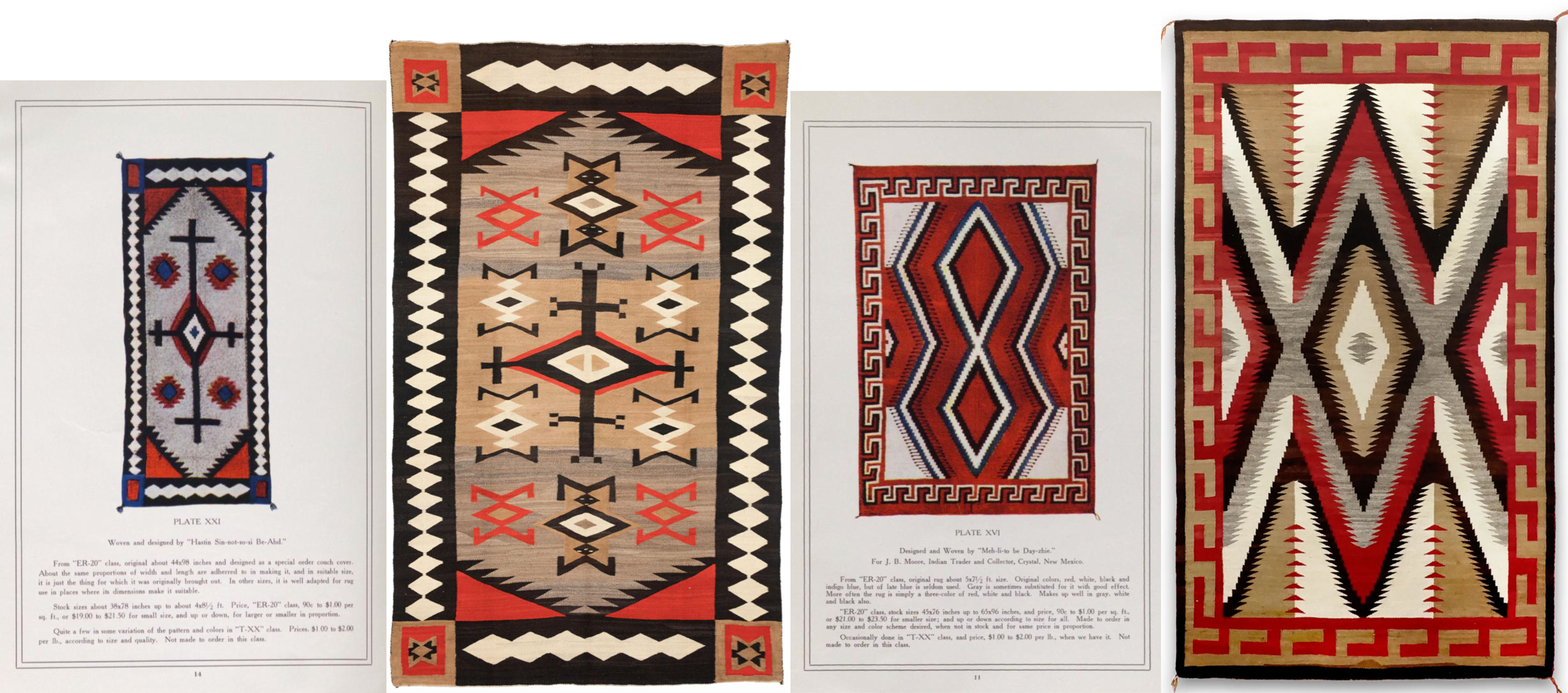
LEFT TO RIGHT
1. Plate XXI (21st) of the 1911 Catalog.
2. Crystal JB Moore Navajo rug. This weaving used Plate XXI as inspiration. It is tightly woven with hand-spun, hand-carded Navajo Churro wool. The variegation in the browns is incredible. The red is aniline dye that was hand-dyed by the weaver. Date: ca. 1920. Dimensions: 116 x 58 in.; 294.64 × 147.32 cm. Photo courtesy: Gail Getzwiller, owner of Nizhoni Ranch Gallery, Sonoita, Arizona.
3. Plate XVI (16th) of the 1911 Catalog.
4. Crystal Rug, ca. 1930. Dimensions: 84 x 48 in.; 213.36 x 121.92 cm. Chimayo Trading del Norte, Ranchos de Taos, NM.
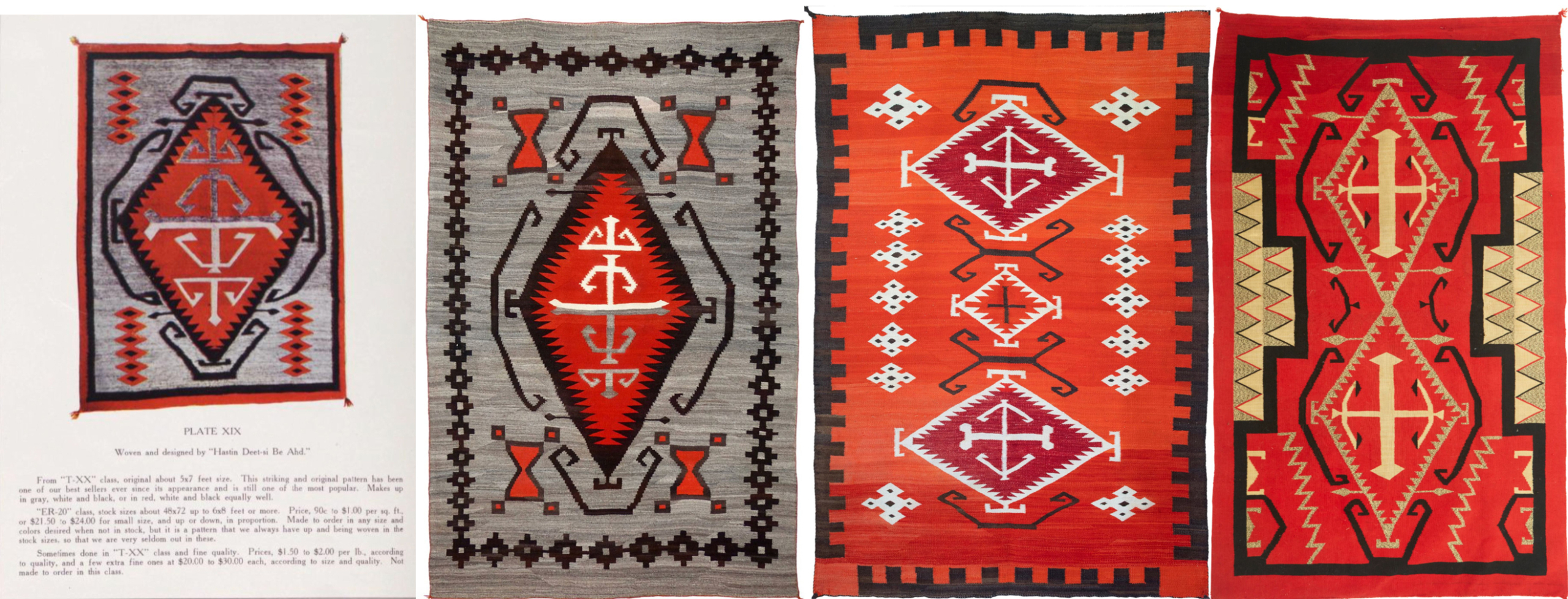
LEFT TO RIGHT
1. Plate XIX (19th), 1911 JB Moore Catalog.
2. J.B. Moore Crystal Rug woven with handspun wool, 1910s. Dimensions: 96 x 62 in.; 243.84 × 157.48 cm. Shiprock, Santa Fe, NM.
3. J.B. Moore Crystal Rug. Very bright and visually striking, featuring natural browns, creamy whites, and hand-dyed reds. Heavy floor weight. Date: ca. 1910. Dimensions: 4'6" x 6'6"; 137.16 x 208.28 cm. 1st DIBS, USA.
3. Early 20th century, Crystal Rug, finely woven in red, salt-and-pepper, black, and cream wool. It features two central sawtooth diamonds surrounded by floating hooked motifs and sawtooth bands on the center edges. The design elements are inspired by Plate XIX from the JB Moore 1911 catalog. Dimensions: 73 x 46.5 in.; 185.42 × 118.11 cm. Auctioned by John Moran Since 1969 in 2024, Monrovia, CA.
As we saw in previous chapters, Moore's legacy is complex. While he undoubtedly increased the visibility and market value of Navajo textiles, his influence on design and production introduced a level of artistic control that some historians and cultural critics consider problematic. He sometimes encouraged or directed weavers, most of whom were Navajo women, to conform to his vision of what would appeal to non-Native buyers. By doing so, he contributed to a broader pattern in which Indigenous art forms were reshaped to meet external market expectations. Thus, Moore’s role in this period is both pioneering and paradoxical. He helped preserve and promote Navajo weaving while participating in the commodification of an Indigenous tradition.
Despite these tensions, the impact of the Crystal Trading Post—and the broader Crystal Period—on the evolution of Navajo weaving is undeniable. Moore's catalogs helped codify and disseminate the Crystal style, establishing it as a recognizable and desirable genre of Navajo textile art that remains influential today.
The Crystal Style: Design Elements and Influences
Moore introduced Navajo weavers to Oriental rug patterns. Rather than encouraging direct copying, however, he allowed the weavers to interpret these new designs through their own cultural sensibilities and personal preferences. This cross-cultural fusion resulted in a distinctive aesthetic that was not purely Navajo or Oriental, but a synthesis of both traditions.
Early Crystal rugs featured bordered geometric compositions with hooks, frets, and whirling logs. A central diamond-shaped medallion became a hallmark of the style, likely inspired by Persian and Oriental rugs popular among collectors at the time.
Early Crystal weavings primarily used natural, undyed wool from black, brown, white, and gray sheep with small accents of red or vegetable dye. This color palette would later evolve, but during Moore's tenure, it remained relatively consistent.
Below is a brief overview of the Crystal style during Moore's time at the Crystal Trading Post, also known as Early Crystal or J.B. Moore Crystal rugs.
Design elements:
- Distinctive bordered geometric compositions;
- Complex geometric patterns with multiple borders;
- All types of hooks, frets, and crosses (symbols of Spider Woman, free from Christian connotations);
- Whirling logs (not swastikas);
- Serrated or stair-stepped diamonds (often in a central position, inspired by Persian/Oriental rugs);
- Zigzags symbolizing bolts of lightning;
- Snowflakes;
- Stars;
- Pictorial elements, such as arrows and feathers.
«Motifs that probably derived from Oriental rugs include repeated hook shapes (often called "latch hooks"), the "waterbug" shaped like an "X" with a bar through the middle, the "airplane" or T-shape with rounded ends and, in a small number of weavings, rosettes. An even more lasting and fundamental influence was the concept of a large central motif in one, two or three parts that covers nearly all the space between the borders. Even the concept of borders, typically consisting of two or three layers with at least one geometric pattern, is probably traceable to Oriental carpet design. Though these motifs and ideas were first introduced in the Crystal region, they quickly spread to other areas of the reservation and are found on many rugs woven over the past century.» (Mark Soublette, Navajo Rugs, Part 1).
Latch hooks became a signature element of Early Crystal rugs. These motifs were adapted from Oriental carpet designs and reinterpreted through Navajo aesthetic sensibilities. They appear as small hooks or "L" shapes that project inward from borders or along the edges of geometric patterns. In Early Crystal rugs, these hooks were often:
- arranged in series along the borders of rugs;
- used to outline central medallions or diamond motifs;
- incorporated into complex geometric patterns throughout the rug.
Another common motif is the Valero star, which is sometimes spelled Vallera or Valera. It is often arranged in lines or in more complex patterns. This distinctive eight-pointed star design has a rich cultural history and is an important example of cross-cultural influence in Southwestern textile arts. It is thought that this star originated in Spain, representing Spanish influence in New Mexico and appearing in both Hispaño and Navajo weavings.
Color Palette
- Early Crystal rugs typically featured aniline red with natural whites, browns, and grays;
- Mostly used natural, undyed wool from black, brown, white, and gray sheep with small pops of red or vegetable dye.

Long live symmetry!
LEFT TO RIGHT
1. Crystal Rug, ca. 1910, hand woven with hand carded, hand spun Navajo Churro wool, using aniline dyes. Dimensions: 52 x 84 in.; 132.08 x 213.36 cm. Sage Gallery, Wickenburg, AZ.
2. Navajo Pictorial Crystal Rug, 1930s. Dimensions: 57 x 41 in.; 144.78 × 104.14 cm. Chimayo Trading del Norte, Ranchos de Taos, NM.
3. Navajo Crystal Rug, 1910-20s. Dimensions: 92 x 58.5 in. 233.68 x 148.59 cm. Mark Sublette, Medicine Man Gallery, Tucson, Arizona.
4. JB Moore Crystal Rug, 1920s. Dimensions: 36 x 67 in.; 91.44 × 170.18 cm. Native Jackets, Inc., Santa Fe, NM. This rug borrows elements from two J.B. Moore Plates: the border is a variation of Plate XXV, and the body of the rug is a variation of Plate XXX.
5. Navajo Crystal rug showing a storm pattern variation with a wide meandering border. First quarter of the 20th century. Dimensions: 4ft 9in x 7ft; 144.78 × 213.36 cm. Auctioned in 2020 by Bonham's in Los Angeles.
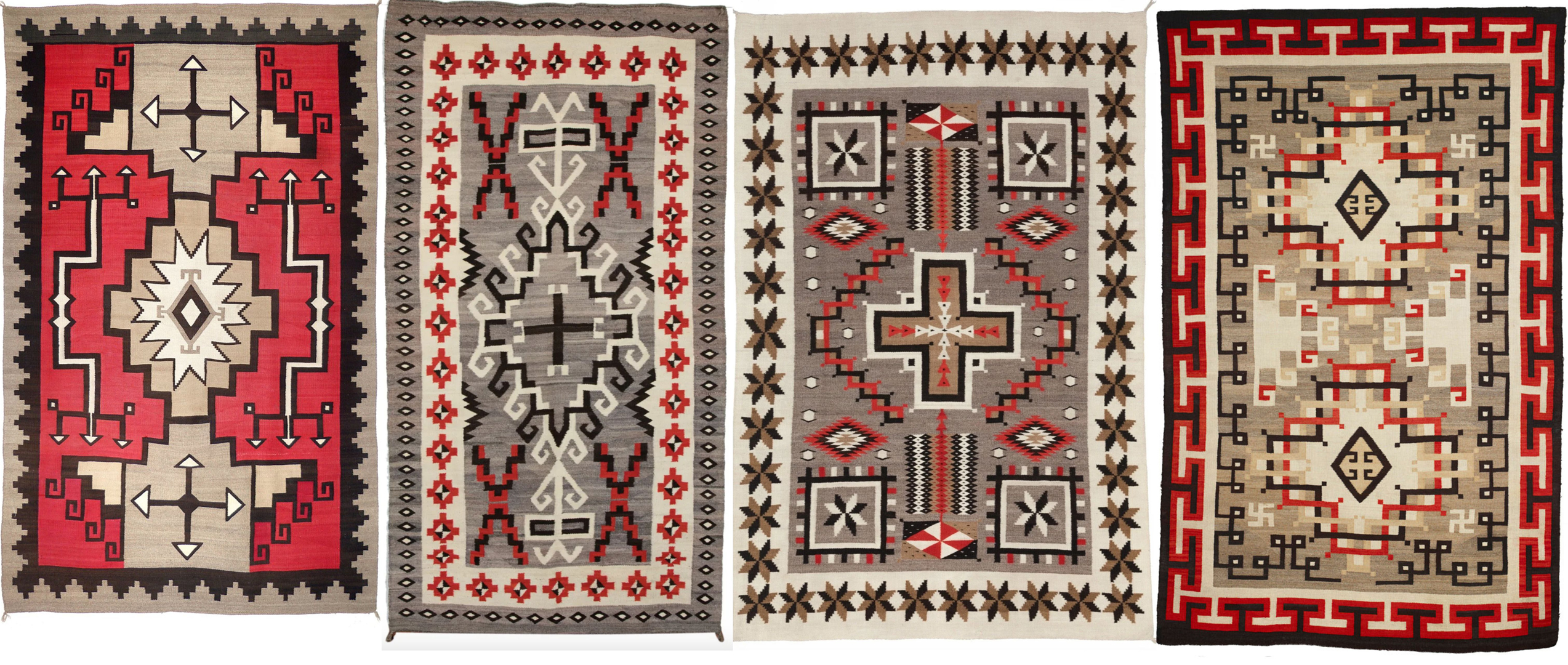
Hooks and Crosses
LEFT TO RIGHT
1. J.B. Moore Crystal Rug woven with handspun wool in natural ivory, beige, dark brown, gray and aniline red. Date: ca. 1911. Dimensions: 87 x 55 in.; 220.98 × 139.70 cm. Shiprock, Santa Fe, NM. The design is modeled after e XXVII of the 1911 Catalog and features an elaborate stepped design in ivory, beige, gray and dark brown on a red background. The central field is bordered by a serrated band of dark brown on a beige-gray background.
2. Crystal JB Moore Navajo Rug, 1915-1920s. Dimensions: 58 x 108 in.; 147.32 × 274.32 cm. Photo courtesy: Gail Getzwiller, owner of Nizhoni Ranch Gallery, Sonoita, Arizona. This rug is similar to the one illustrated in the Plate XXIII in the 1911 Catalog. The master weaver modified the original design by adding beautiful interwoven Xs in each corner. Each plate was used as a guide, and artists added elements to make it their own.used as a guide and the artist would add elements to make it their own.
3. Antique Crystal/ JB Moore Navajo Rug, 1920s. Dimensions: 51 x 78 in.; 129.54 × 198.12 cm. Photo courtesy: Gail Getzwiller, owner of Nizhoni Ranch Gallery, Sonoita, Arizona. This rug was inspired by Plates II, V, VII, and VIII in the 1911 Catalog.
4. Early Crystal style rug, 1900-1920. Medium: wool with aniline and vegetal dyes. Dimensions: 83 x 53 in.; 210.8 x 134.6 cm. Birmingham Museum of Art, Birmingham, AL, USA.
BELOW
Superb Crystal Rug featuring bold diamonds and crosses on a grey field surrounded by an elaborate red, black and white border. Woven from all Navajo Churro handspun, hand-carded and hand-dyed long-staple wools on a wool warp. Date: ca. 1930. Dimensions: 8'4" x 5'2"; 254 × 157.48 cm. Auctioned in 2024; March in Montana, Coeur d’Alene Galleries and The Coeur d'Alene Art Auction.
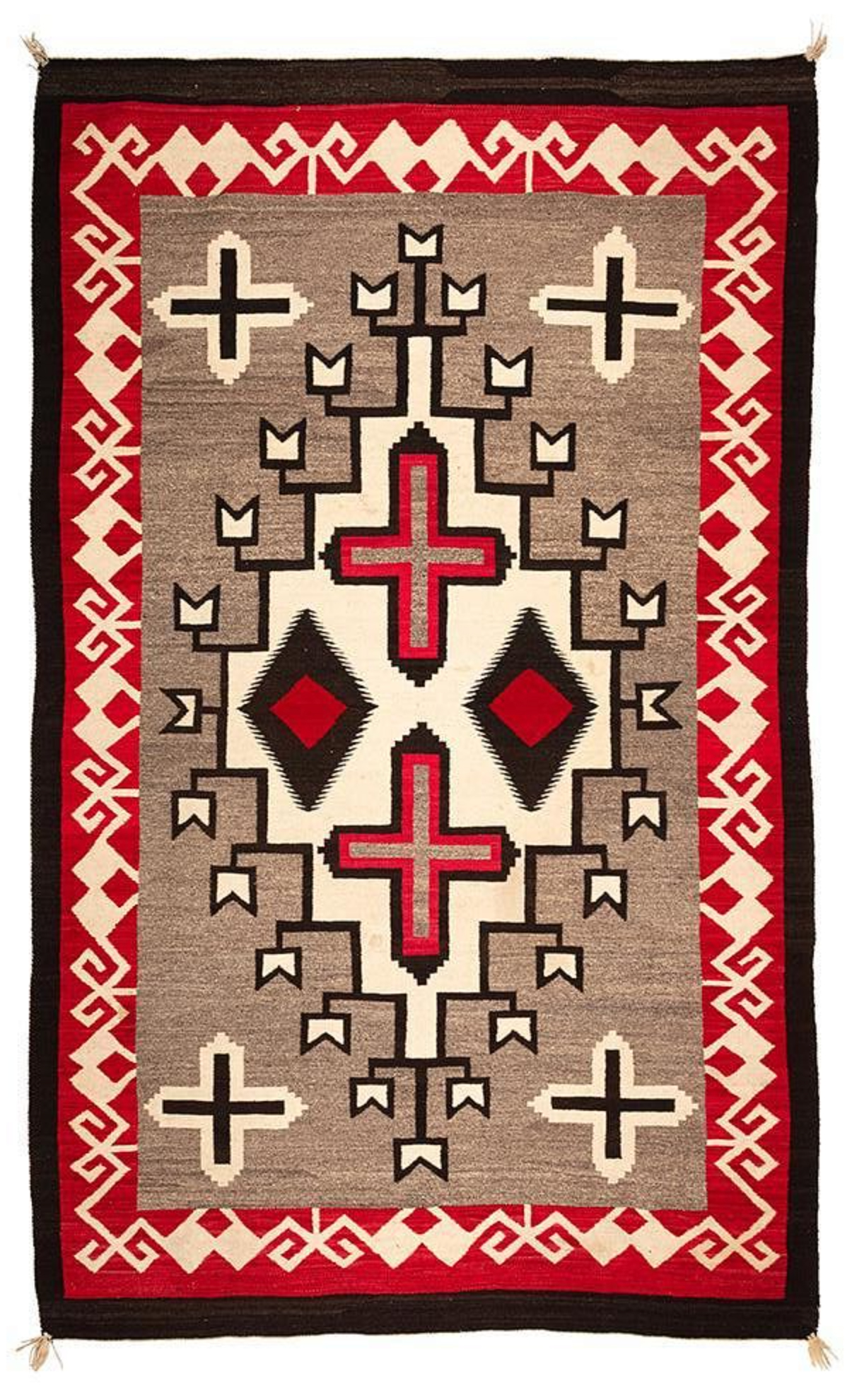

The Triumph of the Hooks 1
LEFT: Crystal J.B. Moore Variant Rug with whirling logs design, 1910s. Dimensions: 81 x 51.5 in.; 205.74 × 130.81 cm. Mark Sublette, Medicine Man Gallery, Tucson, Arizona.
CENTER: Old Time Crystal Navajo rug woven with Merino wool. Has the feel of a blanket. Natural wool colors. Date: 1910 - 1920. Dimensions: 56.5 x 79 in.; 143.51 × 200.66 cm. Photo courtesy: Gail Getzwiller, owner of Nizhoni Ranch Gallery, Sonoita, Arizona.
RIGHT: Beautiful and large Crystal Rug, ca. 1920. Dimensions: Width: 89 x 117 in.; 226.06 x 297.18 cm. On sale on 1stDIBS for over €18,000.
BELOW
Crystal Rug with Valero stars, hooked designs, serrated patterns and meandering T border. Tightly woven. Date: ca. 1930. Dimensions: 6' x 4'4"; 182.88 × 132.08 cm. Auctioned in 2024; March in Montana, Coeur d’Alene Galleries and The Coeur d'Alene Art Auction.
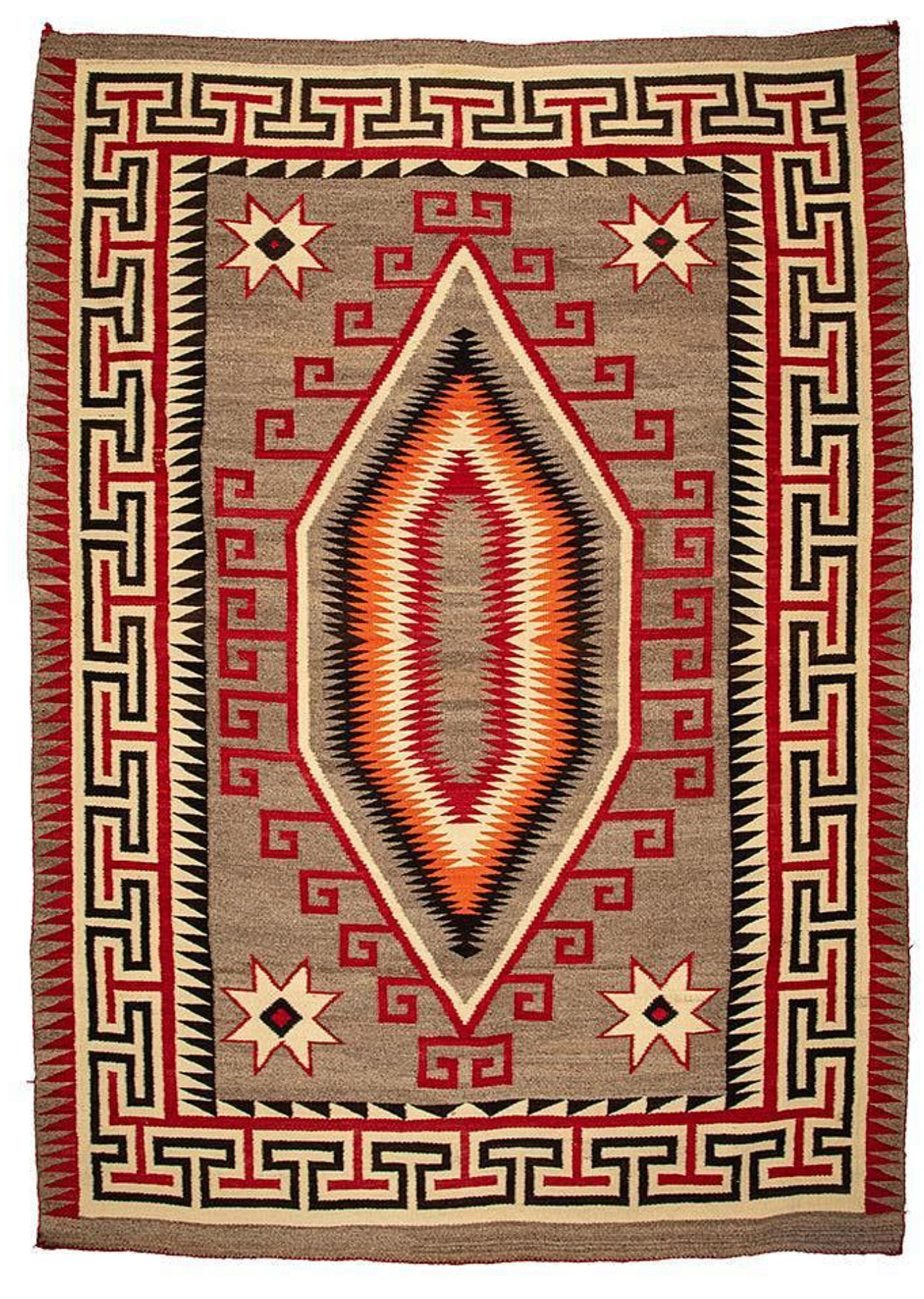
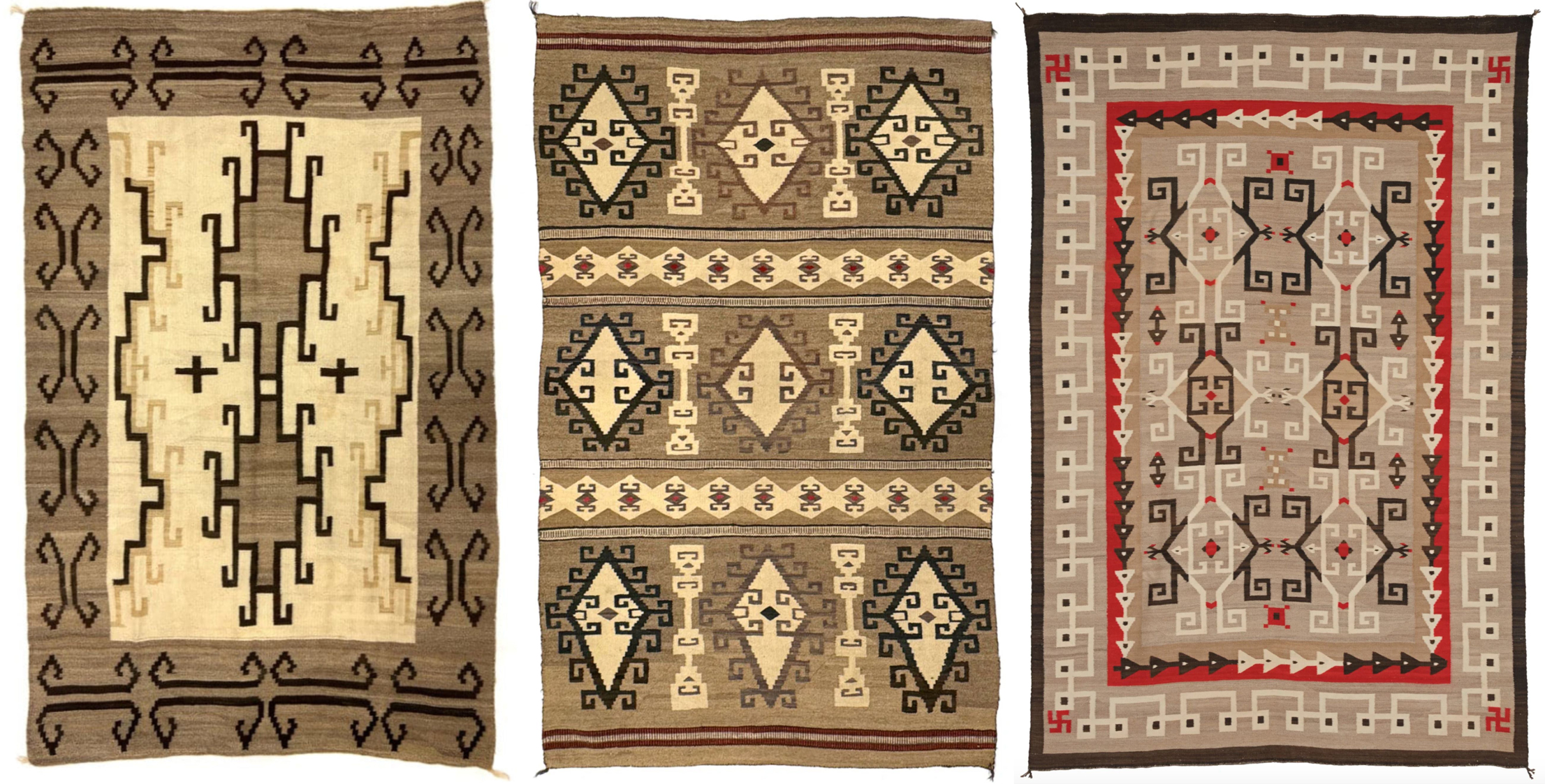
The Triumph of the Hooks 2
LEFT: Crystal Rug, 1910s. Dimensions: 72 x 47 in.; 182.88 x 119.38 cm. Mark Sublette, Medicine Man Gallery, Tucson, Arizona.
CENTER: Crystal Rug, 1900-10s. Dimensions: 66 x 44.5 in.; 167.64 x 113.03 cm. Mark Sublette, Medicine Man Gallery, Tucson, Arizona.
RIGHT: JB Moore Crystal Navajo rug. This Navajo weaving was created using hand carded, hand spun Navajo Churro wool and aniline dyes. Date: 1910-1920s. Dimensions: 62 x 94 in.; 157.48 × 238.76 cm. Photo courtesy: Gail Getzwiller, owner of Nizhoni Ranch Gallery, Sonoita, Arizona. This rug was inspired by several: Plate III for the arrow border; Plate VII for the two rows of diamonds; Plate XXV for the hook element, and Plate XXX for the whirling logs in the corners.
Production Methods and Quality Control
To ensure high-quality textiles, Moore implemented several innovations in the production process. During the winter months, he employed approximately sixteen Navajo weavers to make rugs under his direction. He was meticulous about the quality of the wool, purchasing it locally but sending it east for mechanical cleaning and carding at woolen mills. Some of the wool was also dyed blue or black there. Moore then distributed the wool to his most skilled weavers, along with undyed gray and brown wool.
Significantly departing from traditional Navajo weaving practices, Moore had his weavers repeat the same designs multiple times. This standardization allowed him to create a recognizable "Crystal style" that customers could identify and request through his catalog.
In a 1910 article, Moore noted that many of his best weavers were under twenty years old because older women often suffered from trachoma or other eye problems that prevented them from producing the fine detail work he required. Although he demanded high quality, Moore has been criticized for paying his weavers low wages. He acknowledged that there was no more dismal wage proposition than the remuneration he offered them.
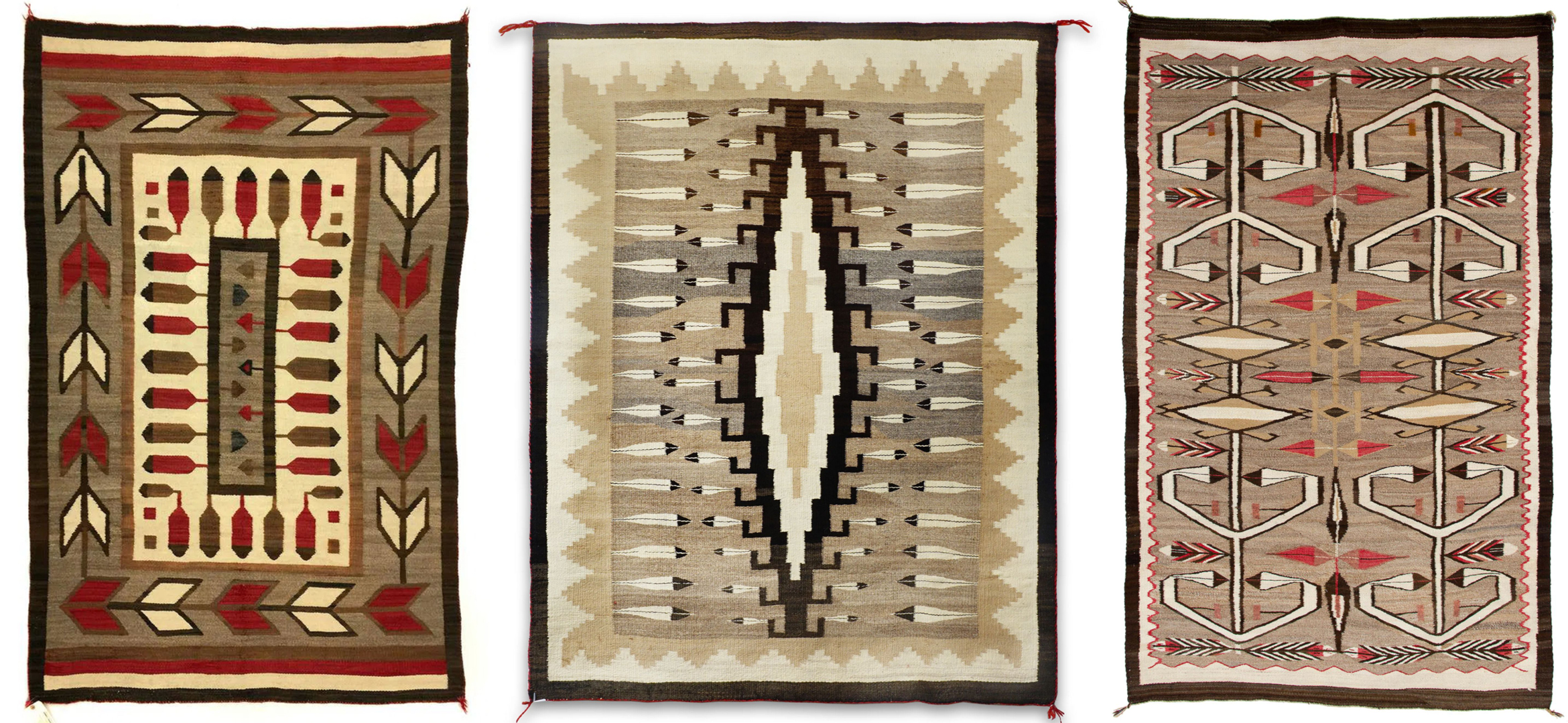
Feathers and arrows
LEFT: Navajo Crystal Rug, ca. 1915. Dimensions: 74 x 49 in.; 187.96 x 124.46 cm. Auctioned in 2021 by Mark Sublette, Medicine Man Gallery, Tucson, Arizona.
CENTER: Fine Crystal Pictorial Rug, ca. 1910-1920. Dimensions: 62 x 47 in.; 157.48 x 119.38 cm. Chimayo Trading del Norte, Ranchos de Taos, NM.
RIGHT: Crystal Rug, 1930s. Pictorial elements include feathers and arrows. It is woven of native, hand-spun wool in the natural colors of the fleece: brown, gray, ivory/white, camel, brown/black, and aniline-dyed red. Dimensions: 50.25 x 80.25 in.; 127.64 x 203.84 cm. On sale on 1st DIBS.
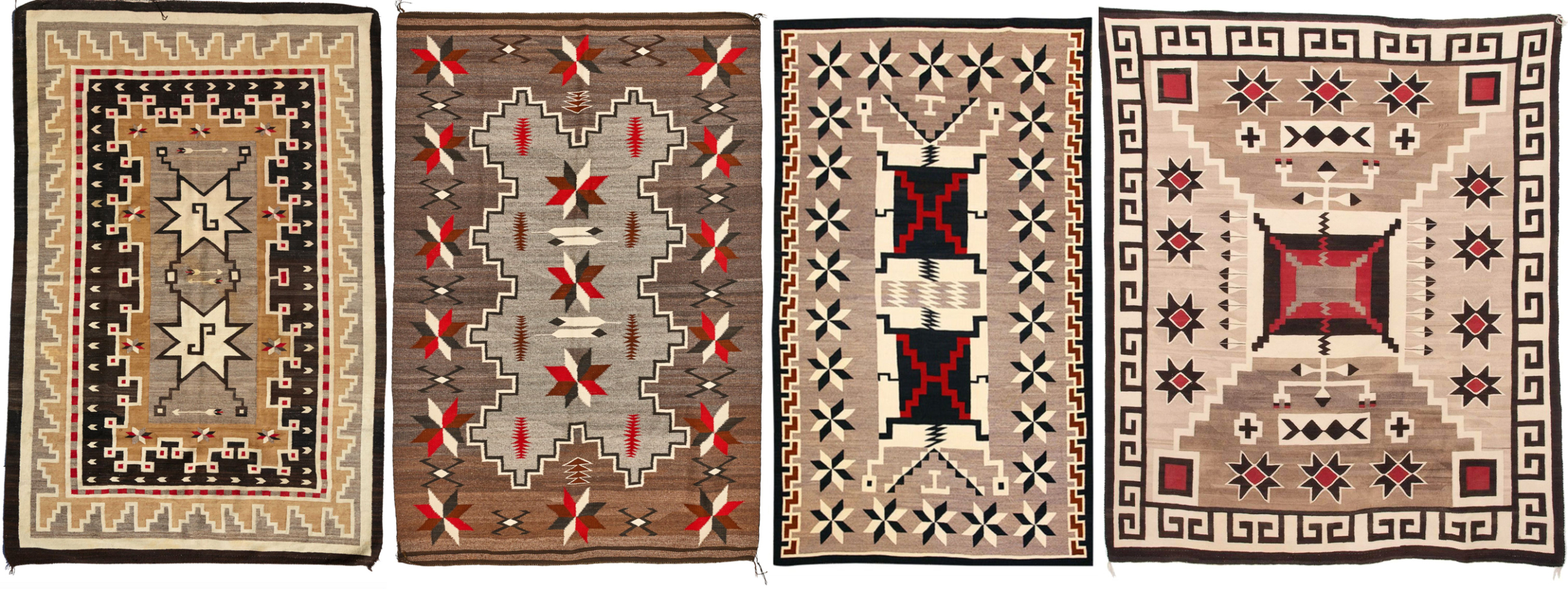
Stars with no stripes!
LEFT TO RIGHT
1. Crystal pictorial rug, first half of the 20th century. Dimensions: 8ft 2in x 5ft 7in.; 248.92 × 170.18 cm. Auctioned in 2017 by Bonham's in San Francisco. The rug's design features a pair of intertwined Valero stars within a series of broad borders incorporating stepped and banded elements, arrows, and small stars as filler motifs.
2. Crystal rug, first half of the 20th century. The stepped center features opposing pairs of feathers, Valero stars, and floating serrates within a wide border containing additional stars and geometric elements. Dimensions: 7ft 3in x 4ft 10in; 220.98 × 147.32 cm. Auctioned by Bonham's in 2023.
3. Tightly woven large Crystal rug from the Crystal Trading Post region. Medium: handspun wool in natural browns and red dye. Date: ca. 1930. Dimensions: 74.5 x 121 in.; 189.23 x 307.34 cm. On sale on 1st DIBS.
4. Amazing Crystal rug, ca. 1925. Dimensions: 72 x 61 in.; 182.88 x 154.94 cm. On sale on 1st DIBS. This is a J. B. Moore Crystal Trading Post rug with a classic storm pattern. This motif represents desert thunderstorms and is characterized by four red squares in the corners of the rug and zigzag lines radiating from the middle. This piece also has pictorial eagle feathers, as well as brown and red morning star designs just inside the border.
The Storm Pattern and its lasting influence
Take another look at the rugs above, especially the last two on the right. They display a pattern that would become famous in the years to come: the Storm Pattern.
The emergence of the Storm Pattern was one of the most significant developments associated with Crystal, and it has become one of the most popular and enduring Navajo rug designs. It is generally defined by a central rectangle connected by zigzag lines to smaller rectangles in each corner.
The precise origin of the Storm Pattern remains somewhat uncertain. Although it is often associated with the Crystal Trading Post, some accounts suggest that it may have originated on the western side of the Navajo Reservation. What is clear is that the pattern was featured in a catalog published between 1903 and 1911, indicating its development during Moore's tenure at Crystal.
The Storm Pattern's distinctive geometric composition features:
- A strong central element (often rectangular);
- Four corner elements connected to the center by diagonal stepped lines;
- Zig-zag lines representing lightning and the power of storms, energy, and transformation. These lines connect the central rectangle to the corner elements.
According to some scholars' interpretations of Navajo mythology, the central element may represent the Lake of Emergence, through which humans and all living things came into this world from the underworld. Other experts say it represents the weaver's home, or hogan. The squares in the four corners often represent the four sacred mountains of the Navajo Nation:
- East: Sierra Blanca (Sis Naajini) in Colorado;
- South: Mt. Taylor (Tsoodzil) in New Mexico;
- West: San Francisco Peaks (Dook' o' oosliid) in Arizona;
- North: Mt. Hesperus (Dib' Nitsaa) in Colorado.
Early versions featured whirling logs, which were similar to swastikas and symbolized protection, good luck, and well-being. However, after the 1930s, this symbol was largely abandoned due to its association with Nazi Germany. Centipedes often flanked the central hoop and replaced the Whirling Logs in later designs.
Another element found in many Storm Pattern rugs is the six-legged water bug, a distinctive and significant motif in Early Crystal Navajo rugs, especially those with Storm Pattern designs. It is shaped like an "X" with a bar through the middle. This creates an insect-like appearance with six legs, where the central bar forms the body and the X forms the legs. In Navajo mythology, the water bug is associated with water, a sacred desert resource. In Storm Pattern rugs, water bug symbols are usually placed at the top and bottom of the rug. They often appear alongside other symbolic motifs, such as the snowflake, which frequently appears just inside the water bug symbol. Some rugs, such as an example from around 1930, have borders composed of "stacked water bug motifs with bars between paired sets." This suggests that the water bug symbol could be used as both a central design element and a repeating border pattern. The waterbug symbol is considered one of the key elements that identify authentic Storm Pattern rugs, along with motifs such as the central rectangle, corner rectangles, zigzag lightning lines, and the whirling logs symbol. The presence of this symbol in Navajo weavings is connected to the influence of J.B. Moore at the Crystal Trading Post. He encouraged weavers to incorporate these distinctive motifs, which eventually became hallmarks of the Crystal regional style.
It's important to note that the symbolic interpretations of the Storm Pattern vary widely. As Mark Soublette points out, «The great variety of interpretations suggests that meanings were assigned by traders and collectors, not by the Navajo themselves.» (In Navajo Rugs, Part 1). This perspective highlights the complex interplay between Navajo weavers and the non-Native market for which they increasingly produced textiles.
The development of the Storm Pattern at Crystal demonstrates how Navajo weavers incorporated external influences while maintaining their distinctive aesthetic sensibilities. Some historians and weavers believe the pattern recounts the Navajo creation and evolution story, depicting their ascent from the underworld to present-day Navajo land.
By the mid-20th century, the Storm Pattern had become one of the most recognizable and commercially successful designs in Navajo rugmaking, which is a testament to the creative adaptation and artistic vision of Navajo weavers during this transformative period.
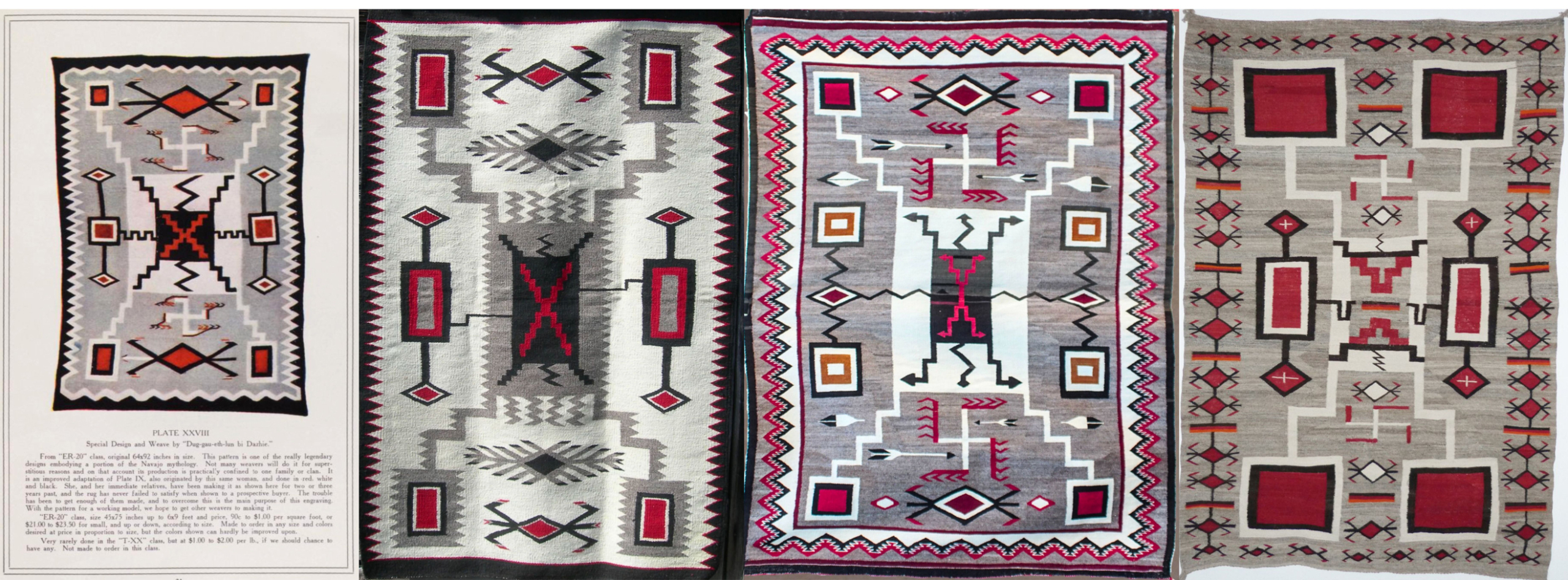
Early Crystal Storm Pattern Rugs
LEFT TO RIGHT
1. Plate XXVIII (28th) from the J.B. Moore 1911 Catalog.
2. J. B. Moore Crystal Storm Pattern. Homespun wool with natural black, carded gray, and off-white yarns, as well as aniline-dyed red elements. Tightly woven. Date: ca. 1911-15. Dimensions: 41 x 61 in.; 104.14 x 154.94 cm. C. Brooks & Co., Fort Worth, TX.
3. J.B. Moore Navajo Storm Pattern Rug, ca. 1920. Dimensions: 76 x 55 in.; 193.04 x 139.7 cm. Nambe Trading Post, High Road to Taos, New Mexico.
4. Navajo Storm Pattern Rug with waterbug motifs, ca.1930. Dimensions: 67 x 45 in.; 170.18 x 114.3 cm. Shiprock, Santa Fe, NM.
«This is an early to mid 20th centuryNavajo textile with a Storm Pattern design, hand woven in native handspun wool in natural ivory, dark brown, hand carded grey, and hand dyed aniline red and orange. The design in the field is typical of the earliest storm pattern textiles and is definitely based on one J.B. Moore plate design. A central box isconnected with stepped lines to box motifs in each of the four corners, with whirling logs and water bugs above and below the central design, and all motifs are on a grey field. The border is composed of stacked waterbug motifs with bars between pairedsets. This textiles is published in The Navajo Weaving Tradition: 1650 to the Present by Alice Kaufman and Christopher Selser.» (Shiprock Art Gallery)
Over time, the Storm Pattern evolved into a more complex and creative interpretation of the original J.B. Moore design, adapting to different regional styles. The rugs in the photos below are all interpretations of the Storm Pattern in styles other than Crystal.

Storm Pattern Navajo Weaving, ca. 1930-1940. Dimensions: 6'5" x 9'4" (77" x 112"); 195.58 cm x 284.48 cm. Photo courtesy: Gail Getzwiller, owner of Nizhoni Ranch Gallery, Sonoita, Arizona.
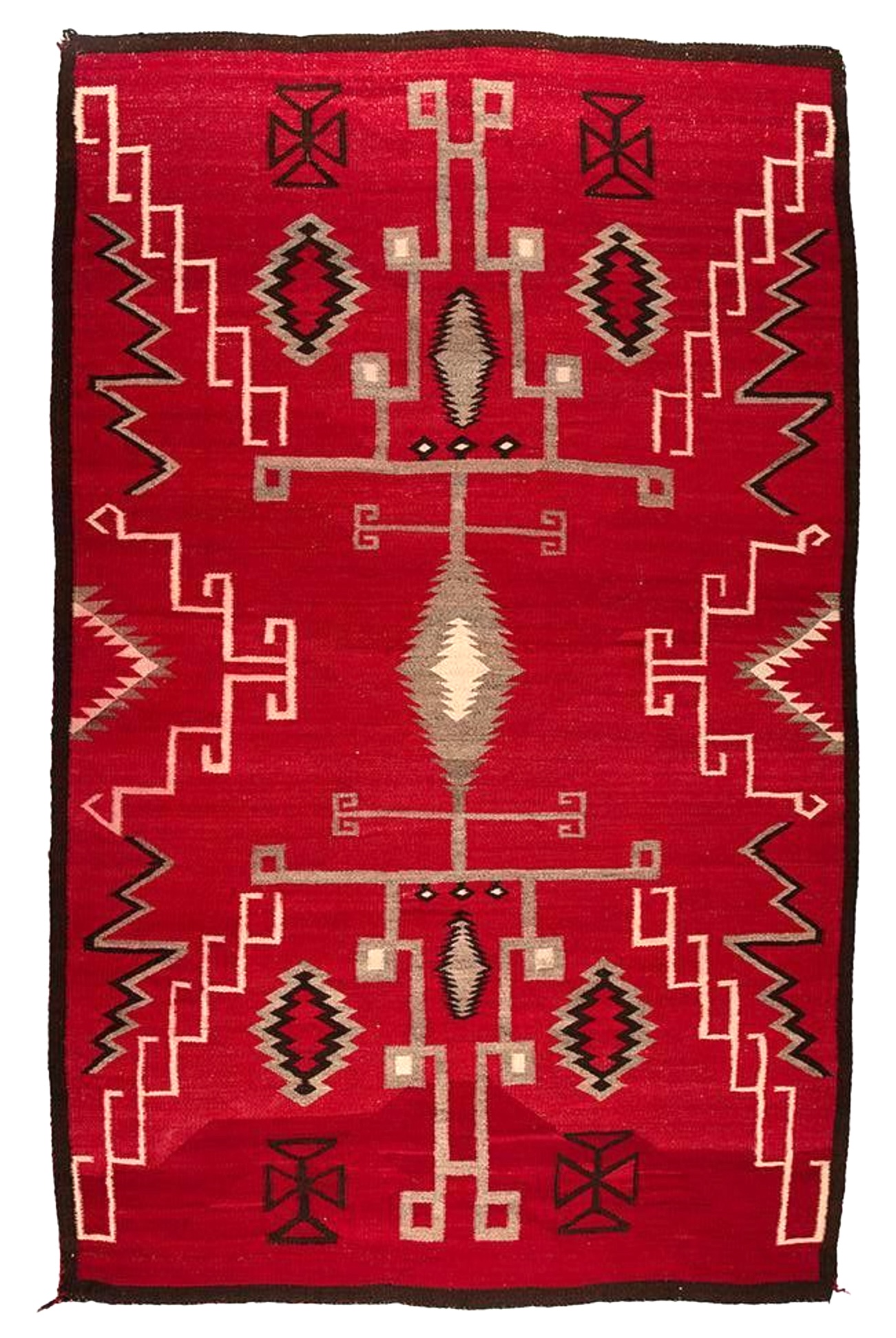
Ganado Storm Pattern rug with a deep red field, grey center serrated diamond with an ivory center, four medium-sized serrated white and brown diamonds surrounding a red center, two smaller serrated brown diamonds with a grey center and six very small brown serrated diamonds with white centers. Four brown geometric symbols, four lightning Mountains and two halfserrated diamonds along two sides. Tightly woven. Data: Early 20th century. Dimensions: 5'9" x 3'6"; 175.26 × 106.68 cm. Auctioned in 2024; March in Montana, Coeur d’Alene Galleries and The Coeur d'Alene Art Auction.

LEFT: Storm Pattern Rug, ca. 1930. Medium: Wool pile on a cotton foundation with natural vegetable dyes. Dimensions: 3’6” x 5’; 106.68 × 152.4 cm. The Persian Knot Gallery, Barrington, IL.
«This finely woven rug was woven by Geraldine Johnson, the esteemed matriarch of the Johnson weaving clan. Handwoven in the1930s, this rug embodies the mastery and spiritual symbolism characteristic of the Storm Pattern, one of the most revered motifs in Navajo weaving traditions. Rendered in a rare and harmonious palette of warm gray, earthy brown, ivory, and soft pink, the composition is both powerful and balanced. The central motif—interpreted as the sacred storm or “warrior” pattern—features dynamic geometric forms and finely articulated water bug symbols, which hold spiritual significance relating to rain, protection, and harmony in the natural world. Crafted from hand-dyed wool on a cotton foundation, the rug exemplifies the precision, rhythm, and narrative depth that have come to define the best of Navajo weaving. Its high knot density and clarity of design speak to Geraldine Johnson’s skill and aesthetic vision, solidifying this piece as a museum-worthy artifact with exceptional provenance.» (The Persian Knot Gallery)
RIGHT: Storm Pattern Rug, early 20th century. Dimensions: 61 x 33-1/2 in.; 154.94 x 85.09 cm. Auctioned in 2022 by New England Auctions - Fred Giampietro, Branford, CT.
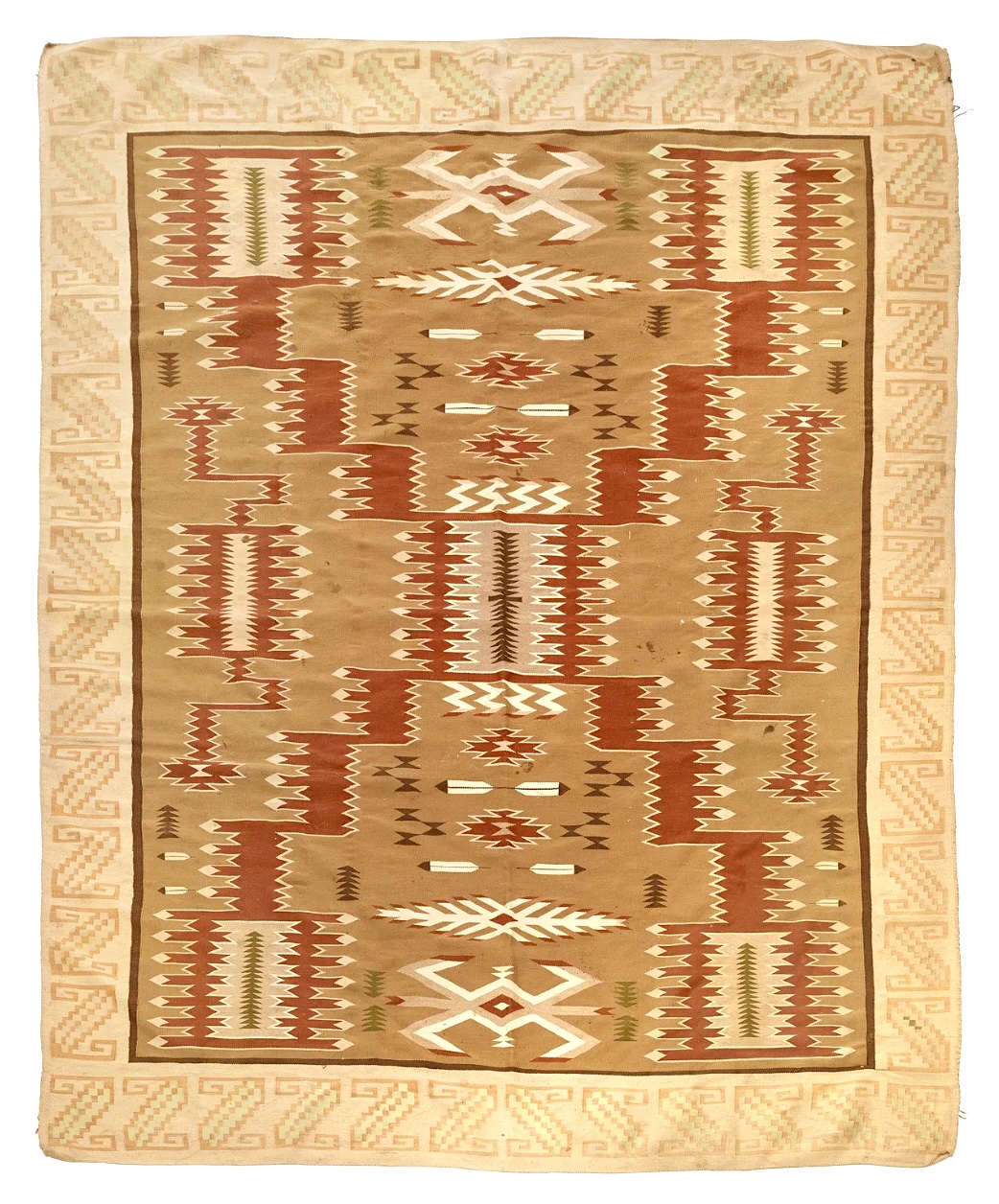
A Storm Pattern rug, finely woven in earth tones. The field is densely decorated with serrates, branching geometric designs, and feathers, within a wide border that encloses scrolled Z-form devices. Second half of the 20th century. Dimensions: 10ft 4 1/2in x 7ft 5in; 316.23 cm × 226.06 cm. Auctioned in 2024 by Bonham's New York.
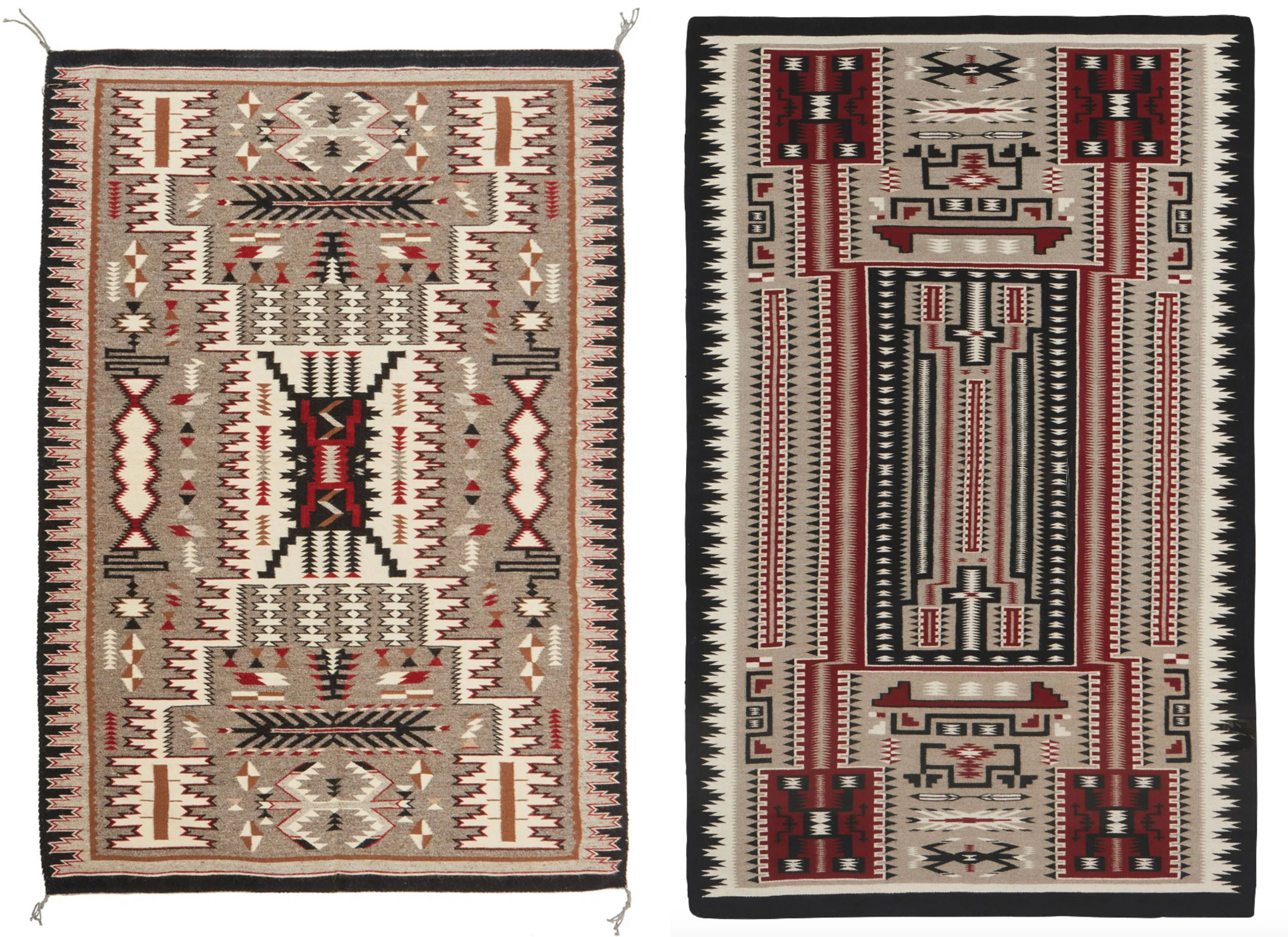
Two Teec Nos Pos style Storm Pattern Rugs
LEFT: A Navajo Teec Nos Pos Storm Pattern rug, made in mid-20th century by Mabel Bighorse. It is woven from handspun wool in shades of gray, cream, brown, red, and black, and features an elaborate storm pattern and a stepped sawtooth border. Dimensions: 74.25 x 50.5 in.; 188.6 cm × 128.27 cm. Auctioned in 2023 by John Moran Auctioneers Inc., Monrovia, CA.
RIGHT: A large framed Teec Nos Pos Storm Pattern rug, woven in red, cream, black, and gray wool. It features an elaborate all-over design with a double storm pattern motif and additional pictographic elements. Date: Mid/late 20th century. Dimensions: 96 x 61 in.; 243.84 cm × 154.94 cm. Auctioned in 2023 by John Moran Auctioneers Inc., Monrovia, CA.
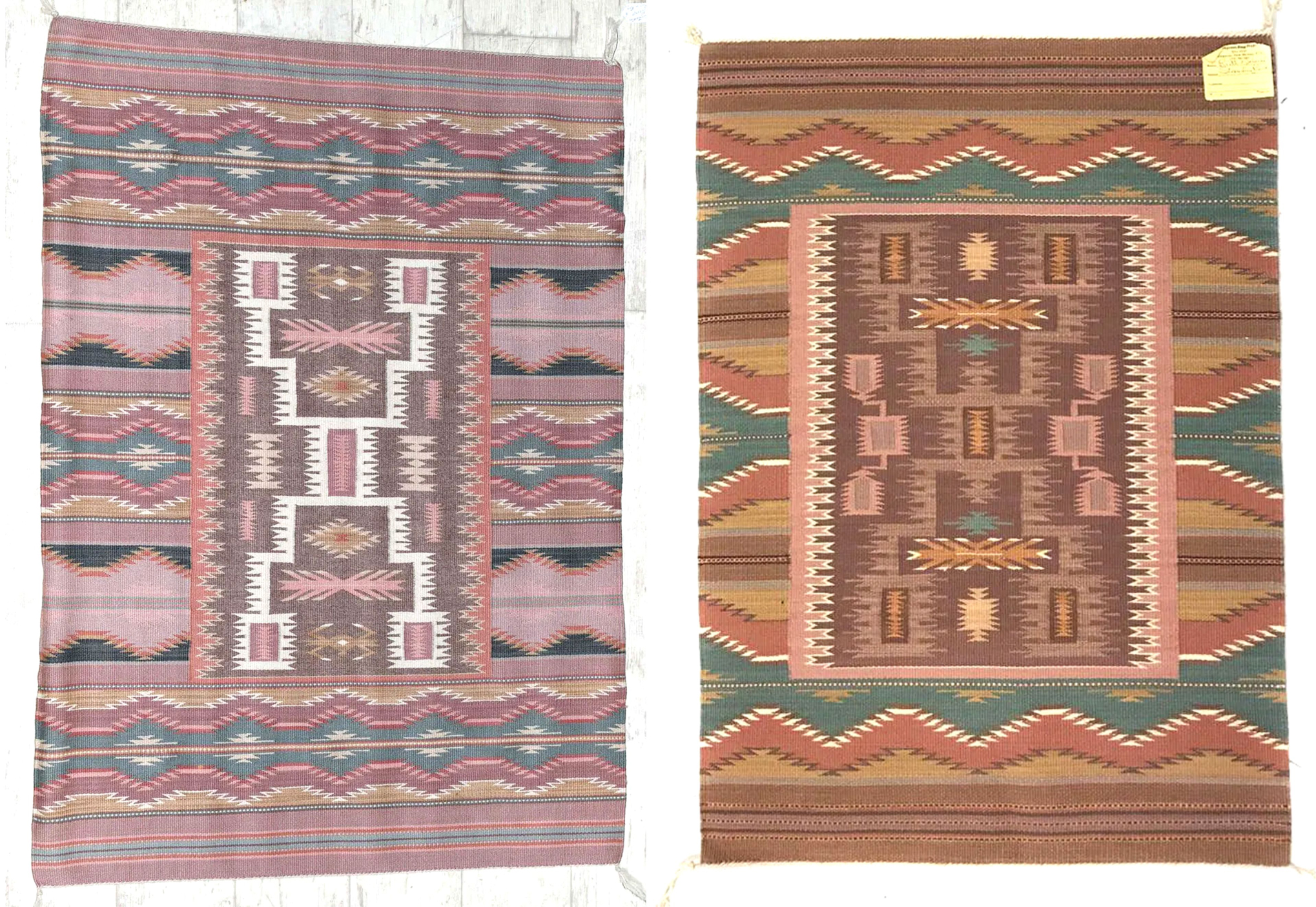
Two Burntwater style Storm Pattern Rugs
LEFT: Burntwater style Storm Pattern Rug by Patricia Nelwood, second half of the 20th century. Dimensions: 47 x 34 in.; 119.38 x 86.36 cm. Auctioned in 2022 by Major Wisconsin Auctions, Cambridge, WI, USA.
RIGHT: Burntwater style Storm Pattern Rug by Ruth Nelwood, 1980s. Dimensions: 37 x 26 in.; 93.98 x 66.04 cm. Mark Sublette Medicine Man Gallery & Auction, Tucson, AZ.
The next chapter will cover the Teec Nos Pos style in depth. (To be pronounced /Tease-nohs-pa:s/).
The Burntwater regional style is one of the most innovative developments in contemporary Navajo weaving. It emerged in the late 1960s as a revolutionary fusion of traditional design elements and natural dye techniques. It originated in the Pine Springs–Burntwater area in the far southeastern corner of the Navajo Indian Reservation, near Sanders, Arizona—hence its name.
In 1968, the style was pioneered by master weaver Mary Goldtooth Smith, her daughter Maggie Price, and her niece Philomena Yazzie, all from the Pine Springs area. These innovative weavers made the groundbreaking artistic decision to combine two weaving traditions that had remained separate for over a century: the traditional border design elements characteristic of Two Grey Hills rugs and the earth-toned vegetal dyes of the Wide Ruins region. Traders Bruce Burnham and Don Jacobs at the Burntwater Trading Post facilitated this synthesis by encouraging local weavers to develop this new aesthetic.
Burntwater rugs are distinguished by their sophisticated use of vegetable-dyed yarns. They feature an extensive palette of pastel and earth tones, including turquoise, aqua, coral, mauve, pink, rose, slate, forest green, and yellow. The most complex examples incorporate up to twenty-four colors to create intricate geometric patterns executed with masterful precision and balance. These textiles often use the raised outline technique, an innovative weaving method developed in the 1950s that creates a three-dimensional effect with "floating" wefts.
The style typically features bordered compositions with increasingly intricate geometric centers that incorporate crosses, triangles, zigzags, and frets. These are all outlined and highlighted with elegant color choices and inner border bands. These designs reflect the influence of Central Diamond and Four Sacred Mountain patterns, which were originally introduced to the region by Oriental rug traders at the turn of the century.
Burntwater weavings were first introduced to collectors in the 1974 Arizona Highways Special Weaving edition. The innovative use of decorative color that characterizes this style began in the 1970s as the latest development in the vegetal-dye movement of contemporary Navajo weaving. Today, these textiles are recognized for their unmatched sophistication, representing the ability of Navajo women to maintain their reputation as some of the finest weavers in the Western Hemisphere.
Now, let's return to the original interpretation of the Crystal style Storm Pattern. Below are some amazing specimens.
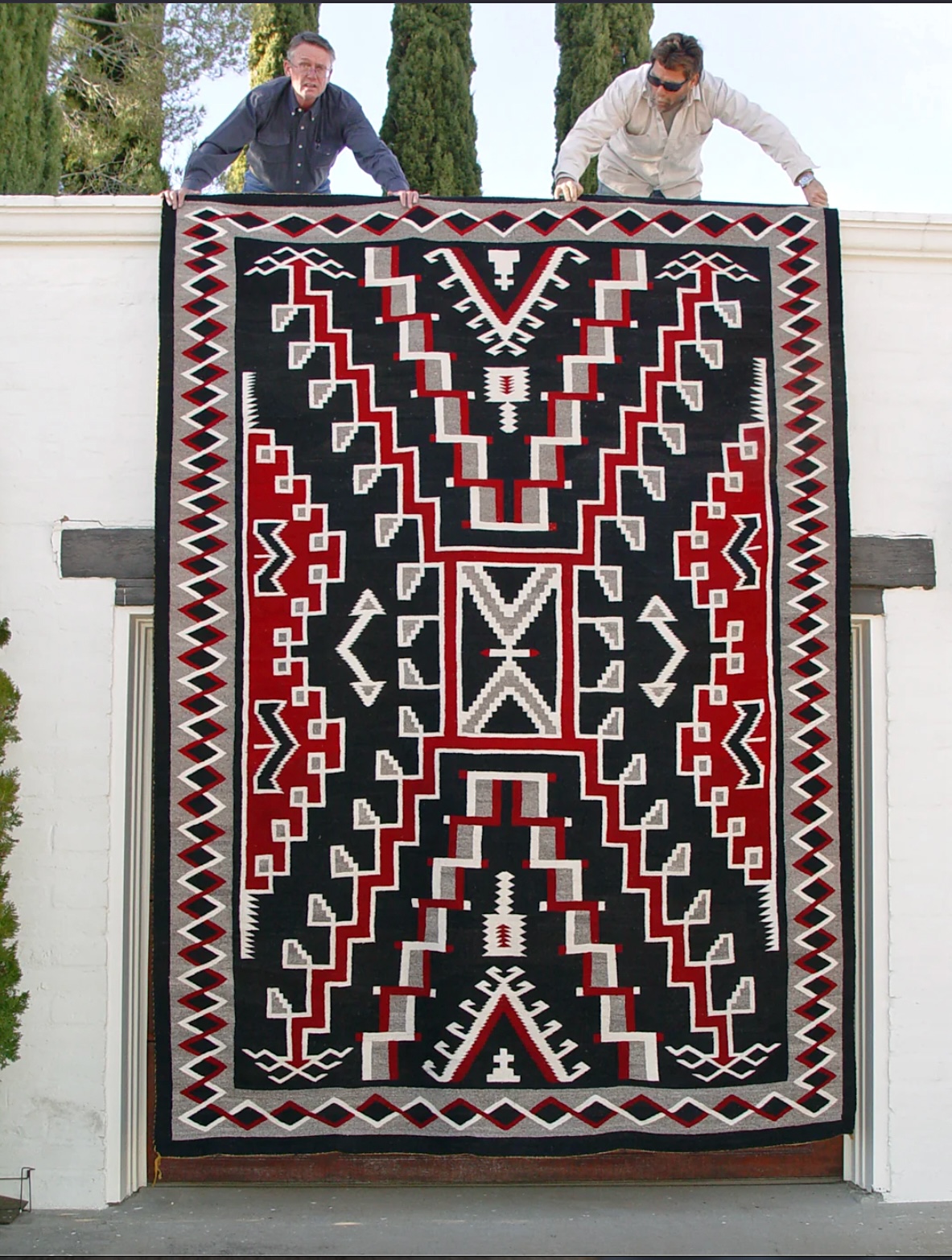
Crystal Storm Pattern Rug, ca. circa 1930-1940. Entirely handspun and hand-dyed. Dimensions: 8′6" x 11'6" - 259.08 cm x 350.52 cm. Stylized gray squash blossoms hold tightly to the four bolts of lightning that extend from the central design. Photo courtesy: Gail Getzwiller, owner of Nizhoni Ranch Gallery, Sonoita, Arizona.
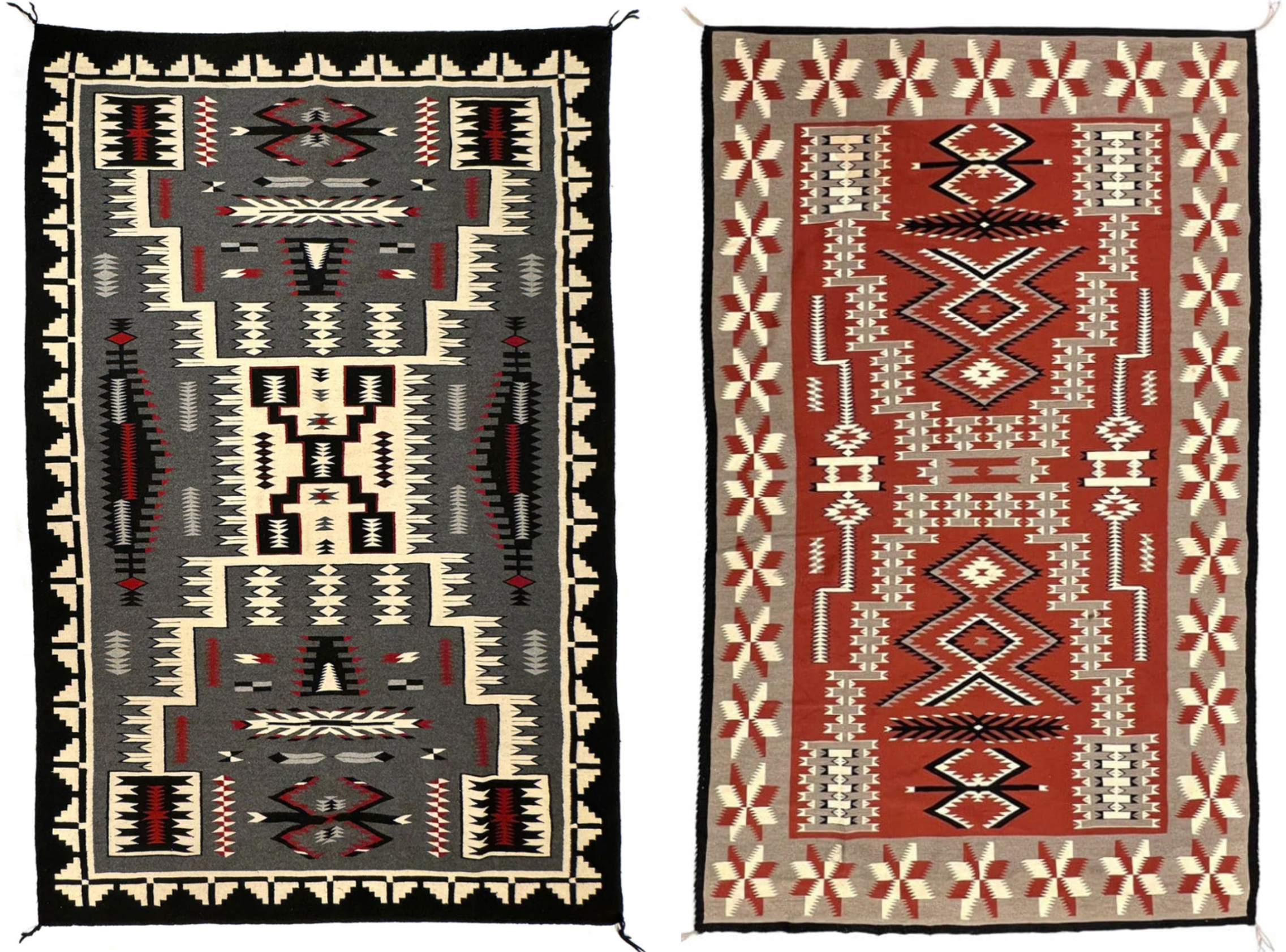
LEFT TO RIGHT
1. Navajo Crystal Storm Pattern Rug with waterbug pictorials, 1970-80s. Dimensions: 103 x 70 in.; 261.62 x 177.8 cm. Mark Sublette, Medicine Man Gallery, Tucson, Arizona.
2. Navajo Crystal Storm Pattern Rug with Valero Stars, 1960s. Dimensions: 114 x 72 in.; 289.56 x 182.88 cm. Mark Sublette, Medicine Man Gallery, Tucson, Arizona.
Legacy and Transition
When Moore sold the trading post in 1911, the Crystal style had already been firmly established as a distinctive and commercially successful form of Navajo weaving. However, the style would undergo significant transformations in the decades following his departure.
By the 1940s, the Crystal rug style had changed dramatically from Moore's original vision, evolving from a central bordered design with bold colors to banded natural colors incorporating two to three different colors, patterns, and "wavy" lines.
The enduring influence of Moore's work at Crystal Trading Post demonstrates his significant impact on the development of Navajo weaving as both an art form and a commercial enterprise. His innovative approach to design, production, and marketing established a foundation that would influence Navajo textile arts for generations to come.
2. Evolution and Transformation in the Post-Moore Era (1911-1940s)
The evolution of the Crystal style in Navajo weaving during the post-Moore era (1911-1940s) saw significant transformations in design elements and the diffusion of the iconic Storm Pattern.
After J.B. Moore left the Crystal Trading Post in 1911, his partner Jesse Molohon continued the business and maintained the styles that Moore and his best weavers had developed.
The early Crystal rugs typically featured aniline red with natural whites, browns, and greys, while rugs made from the 1920s onward relied even more heavily on a wide range of natural wool colors. This period represents a continuation of Moore's legacy, with his innovative approach to Navajo weaving persisting long after his departure.
A significant shift occurred around 1940 when Crystal weavers embraced the vegetal revival style. This transformation was encouraged by Mary Cabot Wheelwright, a Boston philanthropist and amateur anthropologist who worked with trader Cozy McSparron to promote softer colors derived from native dye plants. Initial experiments produced shades of gold and green, but weavers soon expanded their palette to include an extraordinary range of colors not previously seen in older weaving.
This vegetal revival at Crystal marked a distinct departure from Moore's original designs. As noted by Canyon Road Arts, «About the time of World War II, Crystal-area weavers developed their own banded revival rugs bearing no resemblance to Moore's early designs.» This transformation represents the dynamic nature of Navajo weaving traditions, constantly evolving while maintaining cultural significance.
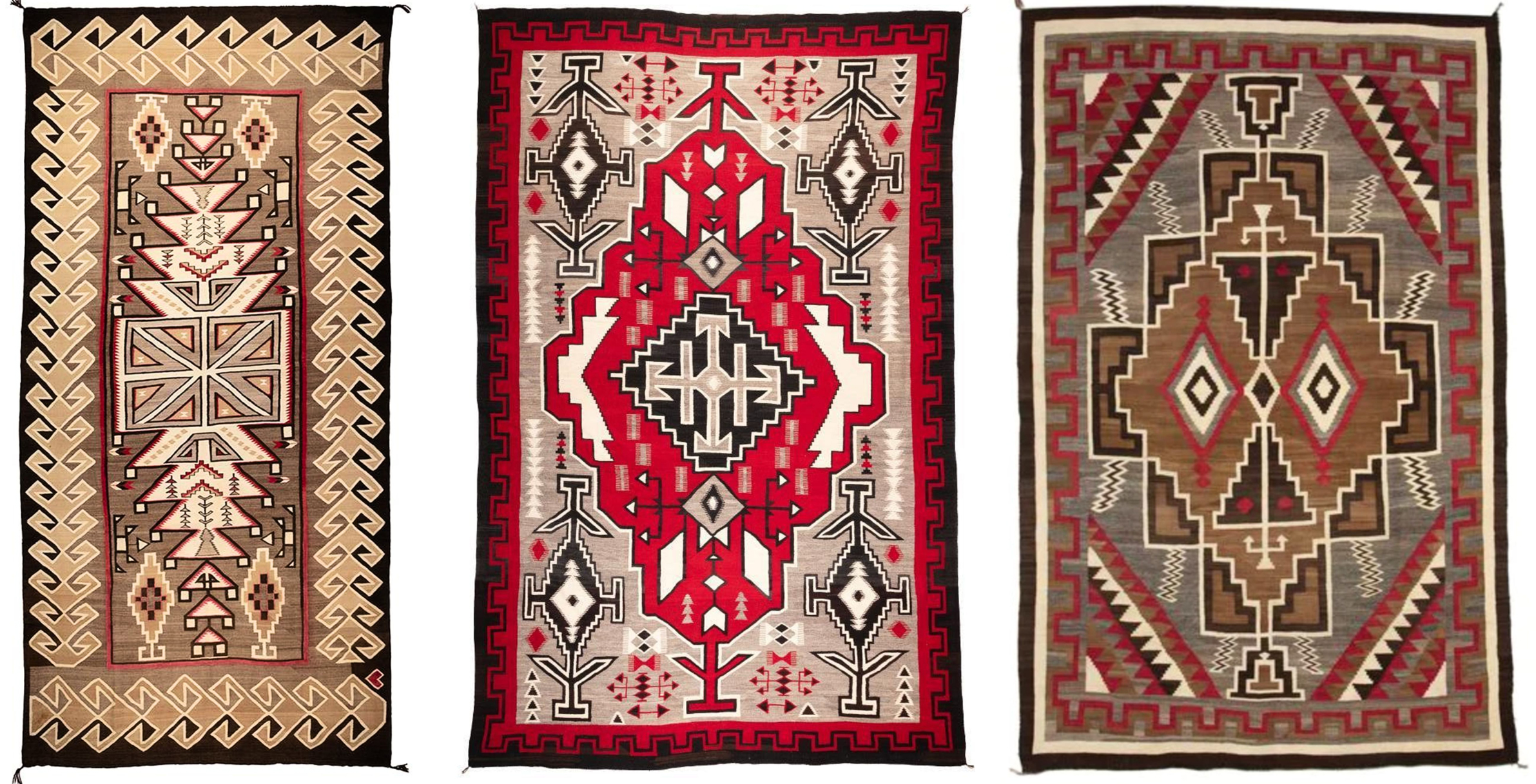
Crystal complex designs
LEFT: Crystal area weaving in brown, red, tan and ivory yarn with feather designs, a central square and pyramid motif along with stepped diamond and a double hooked border. Ca 1930. Dimensions: 12'6" x 6'; 381 × 182.88 cm. Auctioned in 2024; March in Montana, Coeur d’Alene Galleries and The Coeur d'Alene Art Auction.
CENTER: Large and highly valued Crystal Rug, ca. 1920. Dimensions: 13’7” x 8’8”; 414.02 × 264.16 cm. Auctioned in 2023; March in Montana, Coeur d’Alene Galleries and The Coeur d'Alene Art Auction.
RIGHT: Crystal Rug with Hero Twin design, 1930s. Medium: hand carded, hand-dyed, hand-spun native wool. Dimensions: 72 x 108 in.; 182.88 x 274.32 cm. Photo courtesy: Gail Getzwiller, owner of Nizhoni Ranch Gallery, Sonoita, Arizona.
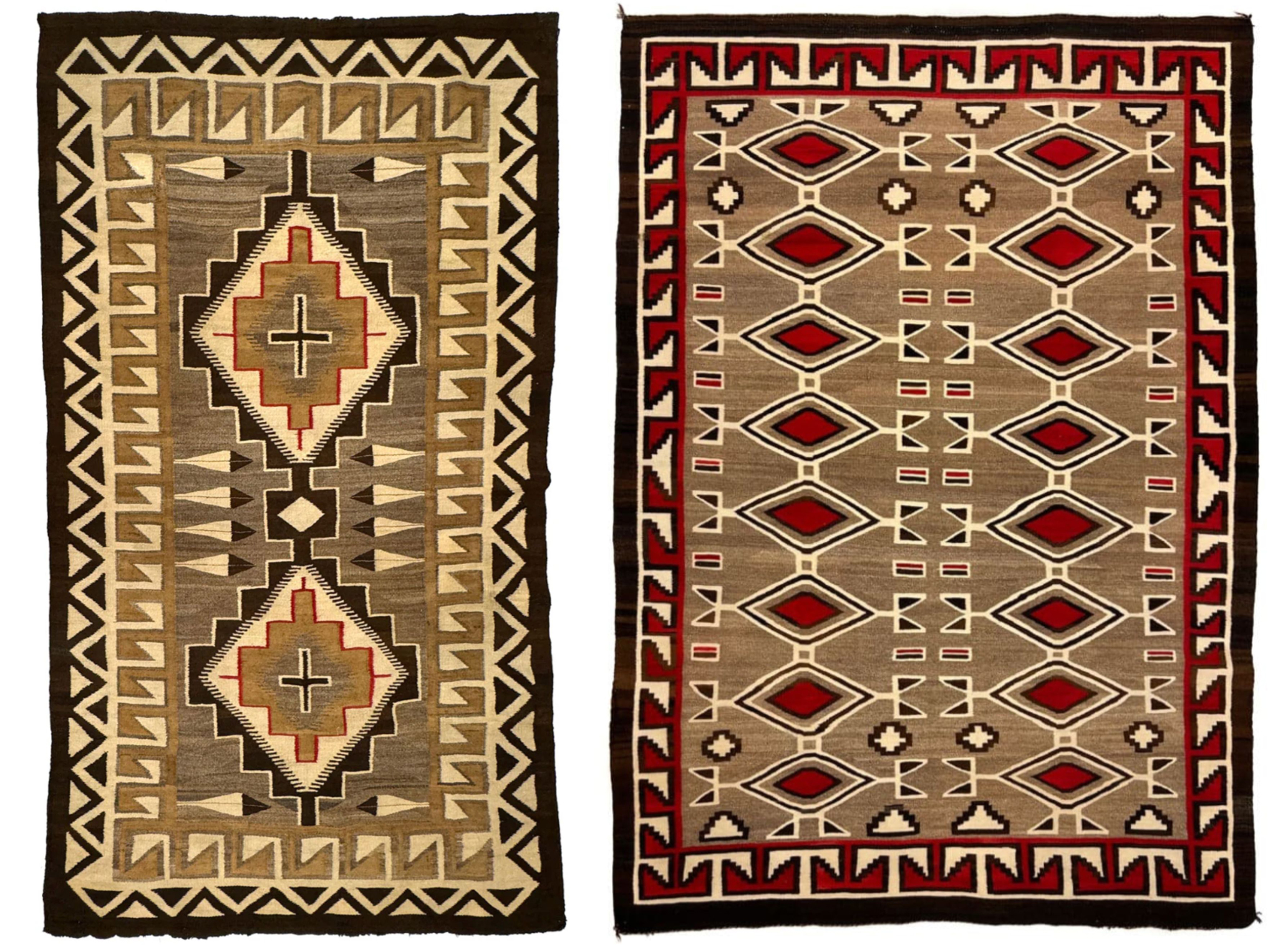
Crystal double symmetry and harmony
LEFT: Early Crystal Rug with feather and cross designs, 1910s. Dimensions: 84.25 x 49 in.; 214.00 × 124.46 cm. Mark Sublette, Medicine Man Gallery, Tucson, Arizona.
RIGHT: Navajo Crystal Rug, 1930s. Dimensions: 87 x 62 in.; 220.98 x 157.48 cm. Mark Sublette, Medicine Man Gallery, Tucson, Arizona.
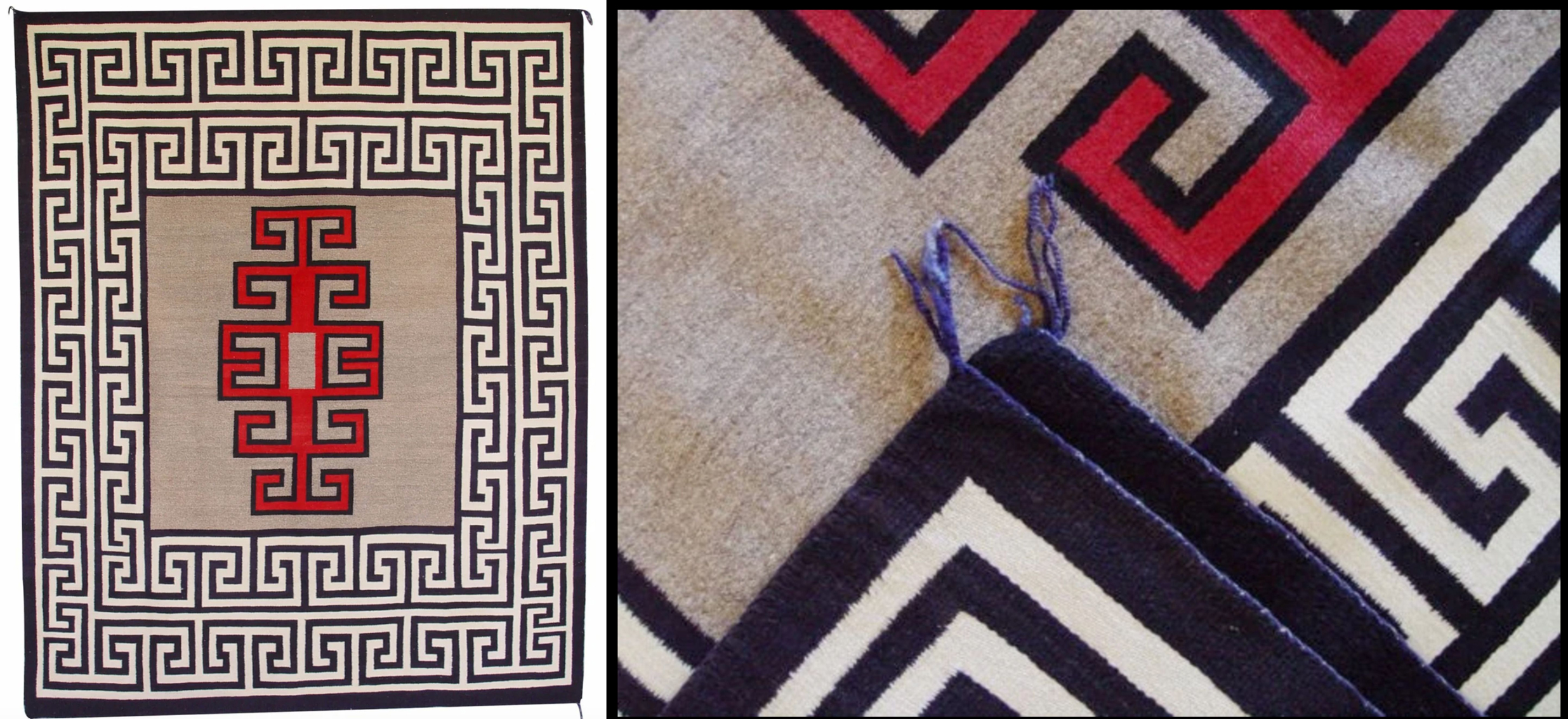
The influence of Art Deco
Crystal Rug from the 1920s. Dimensions: 58 x 72 in.; 147.32 × 182.88 cm. Photo courtesy: Gail Getzwiller, owner of Nizhoni Ranch Gallery, Sonoita, Arizona.
This rug has been masterfully woven, as you can see in the enlarged photo. «The large outer border is done in interlocking hooks in black and white and surrounds a quiet pool of natural brown and then we have a refined explosion of bright red. Then, as if it needed anything else, the edge and tassels were done in navy blue wool.» (Nizhoni Ranch Gallery). This magnificent piece was displayed at a 2017 exhibition at the Tucson Desert Art Museum.
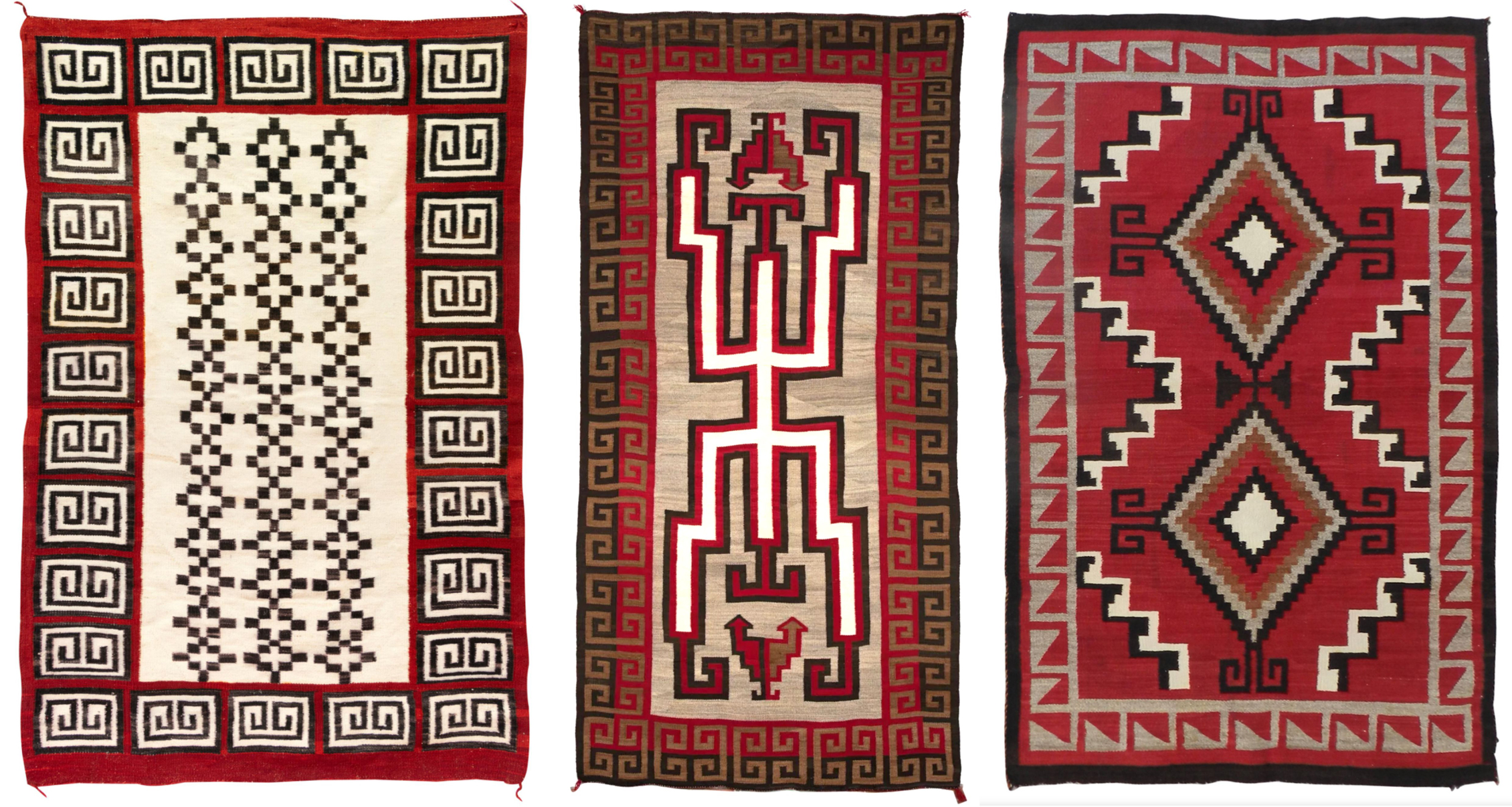
Order and double symmetry
-
Crystal rug with cream center having multiple cross design and border in bright red. Date: ca. 1930. Dimensions: 37 x 56 in.; 93.98 x 142.24 cm. On sale on 1st DIBS.
-
Crystal Hero Twin Storm Pattern Navajo Rug.Woven with hand-carded, hand-spun, and hand-dyed Navajo Churro wool. Date: 1920s. Dimensions: 54 x 108 in.; 137.16 × 274.32 cm. Photo courtesy: Gail Getzwiller, owner of Nizhoni Ranch Gallery, Sonoita, Arizona. This beautiful piece was featured in the Navajo Textiles as Modern Art exhibit held at Nizhoni Ranch Gallery March 11 - June 30 2017. You can find this weaving in the catalog Navajo Textiles As Modern Art on page 16.
-
Crystal Trading Post Rug, ca. 1930. Woven with merino wool and a nice tight weave. Dimensions: 3'8" x 5'11"; 111.76 × 180.34 cm. On sale on 1st DIBS.
3. Modern Crystal Period (1940s-Present)
The modern Crystal style represents one of the most significant transformations in Navajo weaving history, marking a complete departure from its early 20th-century predecessor. This evolution, which began in the 1940s, created what is now recognized as one of the most distinctive and aesthetically pleasing regional styles on the Navajo reservation.
The dramatic shift in Crystal style occurred when Don Jensen purchased the Crystal Trading Post in 1944, recognizing the growing popularity of vegetal dyes from native plants pioneered at other trading posts. Jensen was specifically influenced by the successful work of Cozy McSparron at Chinle and the Lippincotts at Wide Ruins, who had been promoting vegetal dyes and blanket revival designs since the 1920s and 1930s.
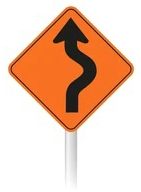
Leon Hugh “Cozy” McSparron was born in 1894 in Gallup, New Mexico. Raised near the Navajo Reservation, he became fluent in Navajo at an early age—a skill that would shape his life’s work. He arrived in Chinle, Arizona, at the encouragement of Hartley Seymour, then-owner of Thunderbird Ranch, who had initially invited McSparron to train him in boxing. Cozy soon began working at the trading post and, in the 1920s, purchased it from Seymour. Situated just 400 meters south of the entrance to Canyon de Chelly, Thunderbird Ranch—now known as Thunderbird Lodge—became both his business and his home.
Alongside his wife, Inja, Cozy McSparron played a crucial role in encouraging Navajo weavers to return to traditional vegetal dyes. The couple also promoted higher standards in rug weaving, helping to shape what would become the Chinle style. Their efforts contributed to a resurgence of traditional techniques at a time when commercial influences threatened to erode them.
The Chinle weaving style that emerged near Canyon de Chelly is widely credited to the collaboration between Cozy and Inja McSparron and Mary Cabot Wheelwright, a Boston philanthropist and scholar. Wheelwright, who would later found the Wheelwright Museum of Navajo Ceremonial Art in Santa Fe, provided financial backing and moral support for weavers experimenting with vegetal dyes.
In the summer of 1938, two recent anthropology graduates from the University of Chicago arrived at Canyon de Chelly as seasonal park rangers. Cozy and Inja befriended them, sharing their love for the land and its people. Disenchanted with government work but captivated by the culture, the young couple, Sallie Wagner and Bill Lippincott, took the McSparrons’ advice to heart and purchased the Wide Ruins Trading Post, about 18 miles north of Chambers, Arizona, and developed a similarly distinctive style of vegetal-dyed, banded rugs.There, they continued the work of supporting Navajo weavers, building on the aesthetic and ethical foundation laid in Chinle.
Cozy McSparron retired in 1956, selling Thunderbird Ranch to the Navajo Tribe. He passed away on November 1, 1959, leaving behind a legacy woven into the cultural and artistic revival of Navajo weaving in the 20th century.
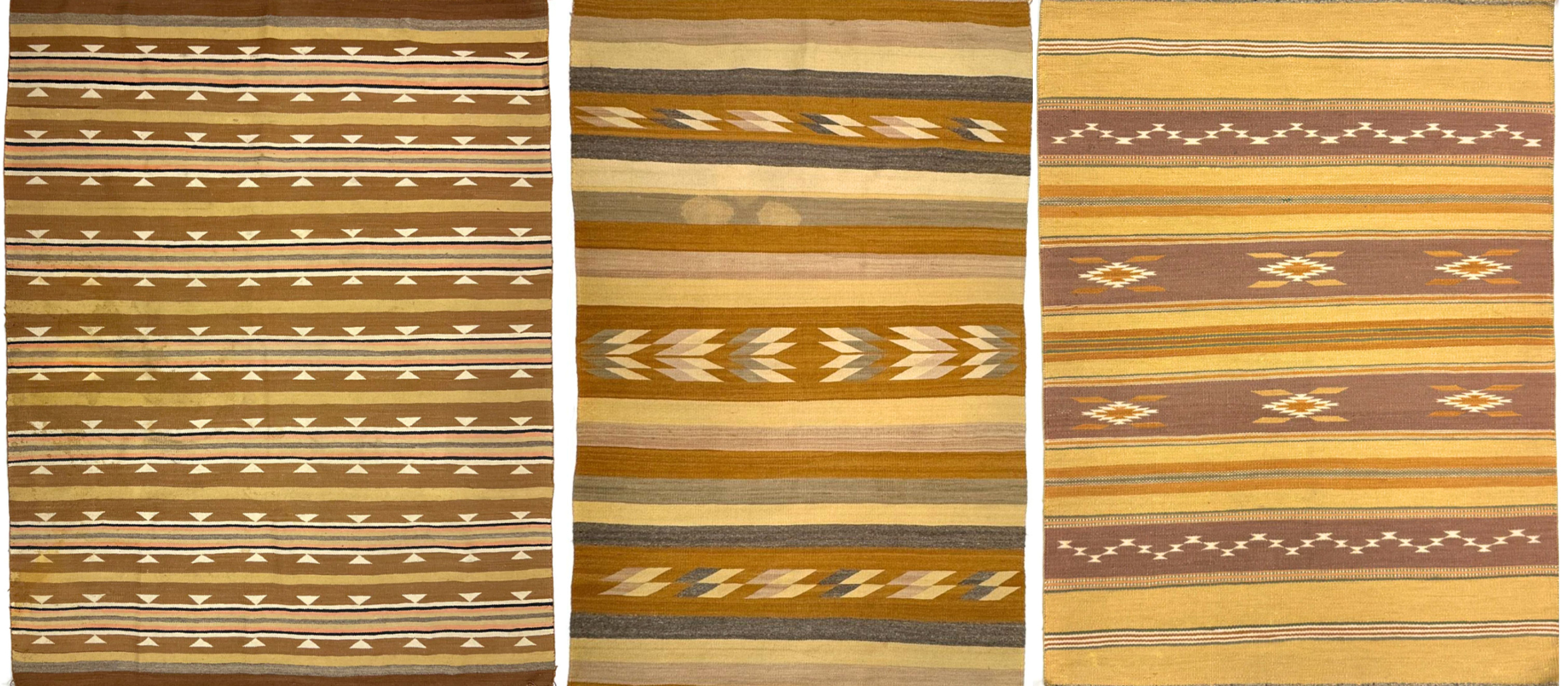
Early Chinle weaving style
LEFT: Chinle Rug, 1940s. Dimensions: 83 × 69 in.; 175.26 × 210.82 cm. Photo courtesy: Mark Sublette, Medicine Man Gallery, Tucson, Arizona.
CENTER: Chinle Rug, 1950-60. Dimensions: 67.5 × 43 in.; 171.45 × 109.22 cm. Sold at auction in 2024 by Mark Sublette. Medicine Man Gallery & Auction Tucson, Arizona.
RIGHT : Chinle Rug, 1940s. Dimensions: 44.25 × 34.25 in.; 112.4 × 87.0 cm. Photo courtesy: Mark Sublette, Medicine Man Gallery, Tucson, Arizona.
BELOW
Chinle patterns - 20th century
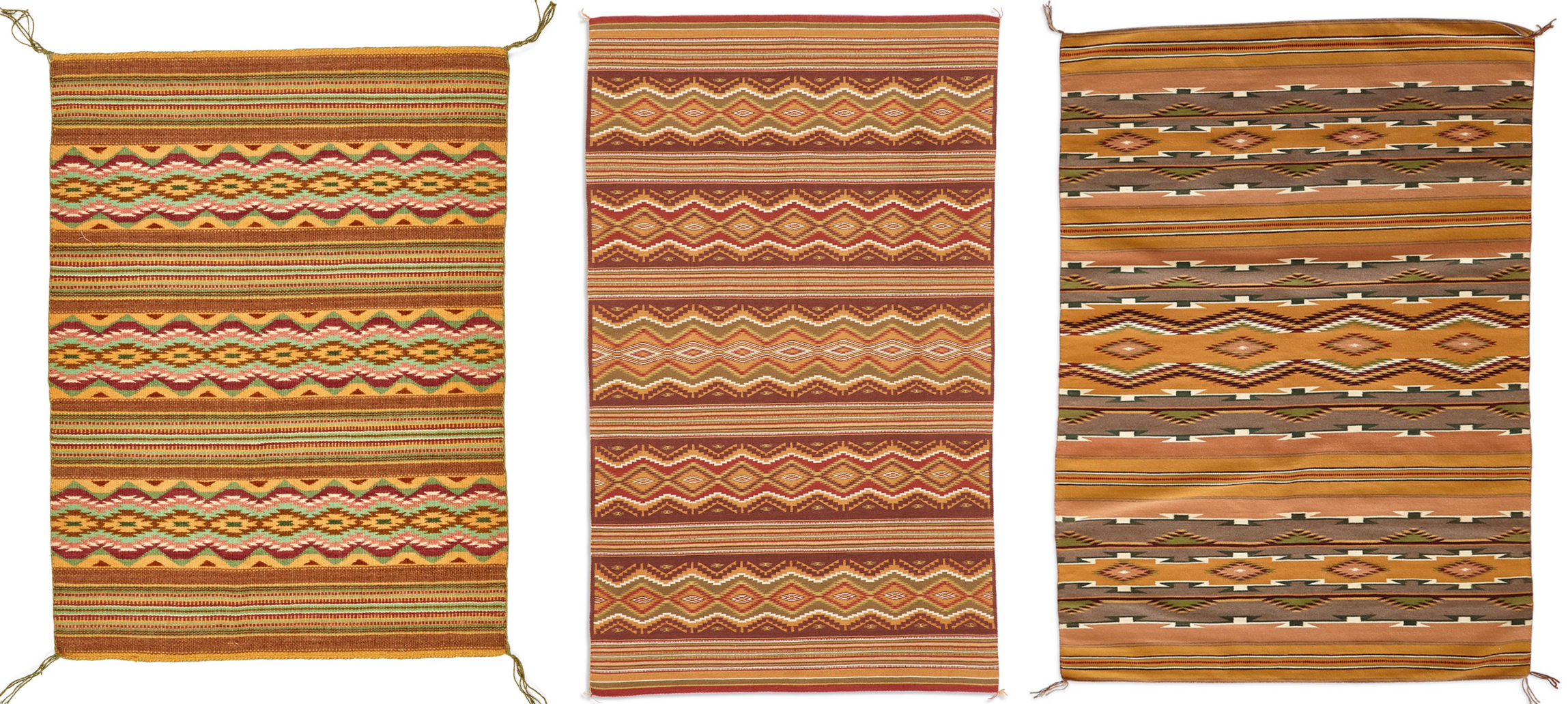
Contemporary Wide Ruins Weaving
LEFT: A finely woven saddle blanket/throw in a banded Wide Ruins pattern by Geraldine Dale Begay. Second half of the 20th century. Dimensions: 2ft 3in x 1ft 8in; 68.58 x 50.80 cm. Auctioned in 2021 by Bonham's, Los Angeles.
CENTER: Wide Ruins rug by Jennie Thomas, early 1980s. Designed with thick concentric bands of serrated and stepped diamonds separated by thin geometric and solid bands. First Prize winner, Museum of Northern Arizona Flagstaff, 1988. Dimensions: 5ft 11 1/2in x 3ft 10in; 181.61 x 116.84 cm. Auctioned in 2021 by Bonham's, Los Angeles.
RIGHT: Wide Ruins rug by Faye Murphy. Second half of the 20th century. Dimensions: 5ft 8in x 3ft 11in.; 172.72 x 119.38 cm. Auctioned in 2020 by Bonham's, Los Angeles.
BELOW
Wide Ruins Patterns - 20h century
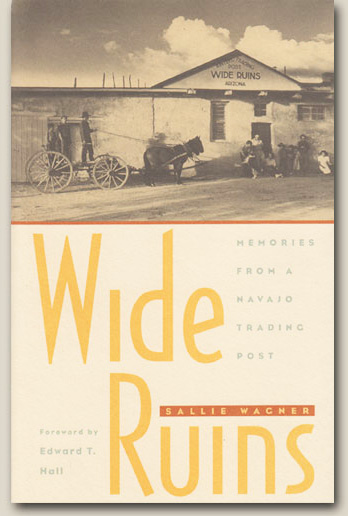
To learn more: WIDE RUINS - Memories from a Navajo Trading Post, by Sallie Wagner, 1997 (1st edition), published in cooperation with The Albuquerque Museum by University of New Mexico Press.

The influence of Chinle and Wide Ruins styles marked a complete departure both from the earlier J.B. Moore Crystal period (1897-1911) and the pre-war period (WWII of course).
The new Crystal style is immediately recognizable by its borderless composition, a stark contrast to their predecessors. It belongs to the broader category of banded rugs, which includes Chinle and Wide Ruins styles. The structural organization of contemporary Crystal rugs follows a specific banding system where there are typically three bands of wavy lines or solid color between one or two more complex patterned bands. The more complex bands feature traditional Navajo motifs such as squash blossoms, arrows, stars, crosses, and triangles. This creates a rhythmic visual flow that distinguishes Crystal rugs from other banded styles like Chinle and Wide Ruins. The new Crystal style shares also similarities with Burntwater rugs in terms of vegetal dye usage and earth tone palettes, though Burntwater rugs typically maintain more geometric spiral designs and may include borders.
The use of vegetal dyes produces the characteristic soft earth and pastel tones. The typical color palette includes rich browns, golds, oranges, and beiges, often accented with subtle touches of green, gray, and maroon. These muted earthen colors such as rust, gray, and rich brown are frequently complemented by pastel greens, pinks, or yellows. The vegetal dyeing process allows for more extensive use of natural wool colors, creating a soft, harmonious palette.
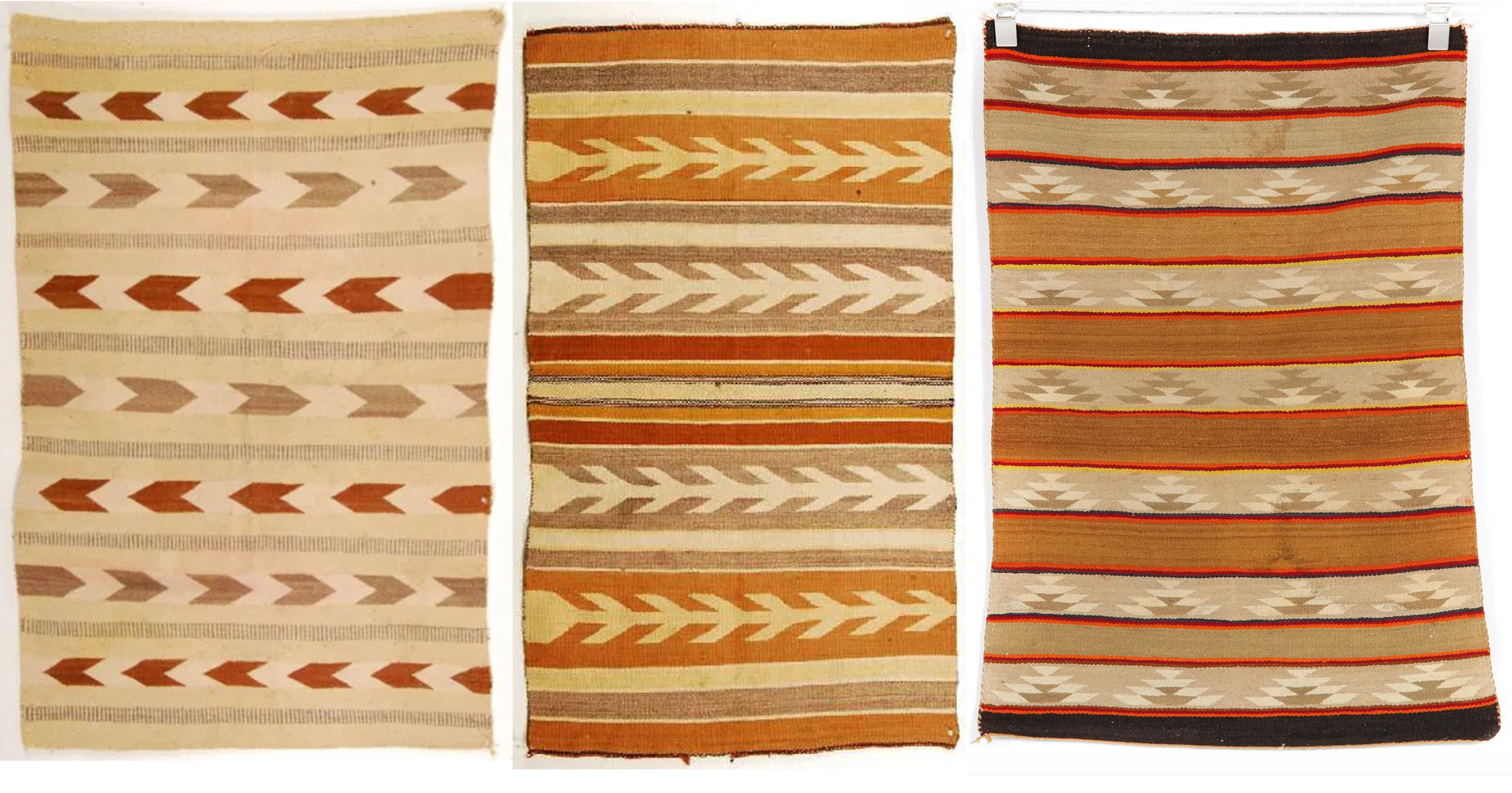
LEFT: Banded Crystal rug, 1950s. Dimensions: 53-3/4 x 36 in.; 139.7 x 81.28 cm. Auctioned in 2010 by BURLEY AUCTION GROUP, New Braunfels, TX.
CENTER: Banded Crystal rug, 1950s. Dimensions: 55 × 32 in.; 136.53 x 91.44 cm. Auctioned in 2010 by BURLEY AUCTION GROUP, New Braunfels, TX.
RIGHT: Chinle Crystal woven rug in shades of gold, red, cream, orange, red and black, mid-20th century. Dimension: 28 x 44 in.; 71.12 x 111.76 cm. Auctioned in 2021 by RIPLEY AUCTIONS, Indianapolis, IN.
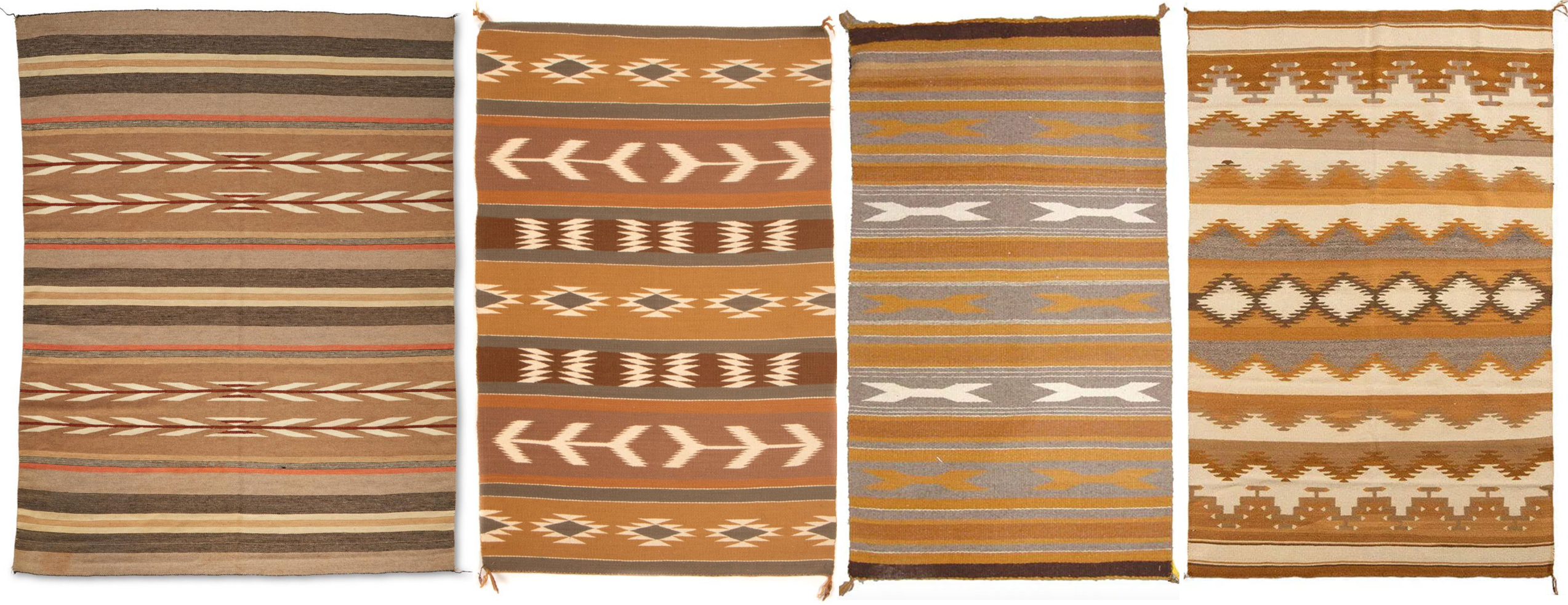
LEFT TO RIGHT
1. Crystal Rug woven in brown, grey, orange, pale yellow, mustard, and black wool with alternating striped bands and bands with geometric arrow motifs, mid-20th century. Dimensions: 84 x 65.5 in.; 213.36 x 166.37 cm. Auctioned in 2023 by John Moran Auctioneers, Monrovia, CA.
2. Crystal Rug made by Annie Apache with handspun wool, natural and vegetal dyes, ca. 1960. Dimensions: 47 x 30 in.; 119.38 x 76.20 cm. Auctioned in 2022 by Santa Fe Art Auction, Santa Fe, NM.
3. Beautiful banded Crystal rug done in natural wools, purchased at Canyon De Chelly Trading Post in the 1970s. By Ella Mae Brown. Dimensions: 24 x 47 in.; 60.96 x 119.38 cm. Auctioned in 2014 by ALLARD AUCTIONS Inc., St. Ignatius, MT.
4. Crystal Rugs, handwoven with handspun wool in natural colors, second half of the 20th century. Dimensions 75-1/2 × 48 in.; 191.77 x 121.92 cm. Auctioned in 2024 by FREEMAN'S | HINDMAN, Chicago, IL.
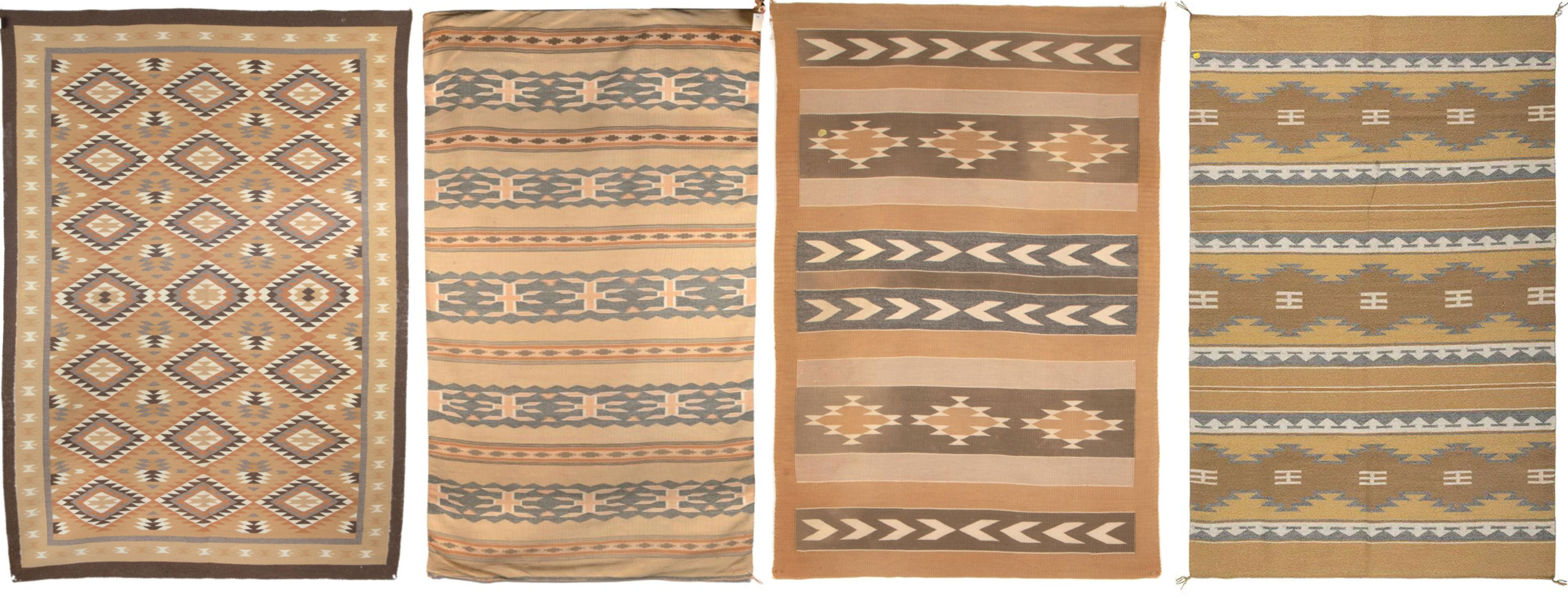
LEFT TO RIGHT
1. Crystal Rug, 1960s. Dimensions: 82 x 57 1/2 in.; 208.28 x 146.05 cm. Auctioned in 2022 by Santa Fe Art Auction, Santa Fe, NM.
2. Crystal Rug. made with handspun wool yarns and natural dyes, ca. 1960. Dimensions: 86 x 51 in.; 218.4 × 129.5 cm. Auctioned in 2023 by Santa Fe Art Auction, Santa Fe, NM.
3. Crystal Rug made with handspun wool, natural and vegetal dyes, ca. 1960. Dimensions: 40 x 59 3/4 in.; 101.60 x 151.77 cm. Auctioned in 2021 by Santa Fe Art Auction, Santa Fe, NM.
4. Crystal Rug by Mary Johnson with of handspun wool in natural colors of gold, gray, and cream, mid-20th century. Dimensions: 69-1/2 × 49-1/2 in.; 176.53 x 125.73 cm. Auctioned in 2024 by FREEMAN'S | HINDMAN, Chicago, IL.
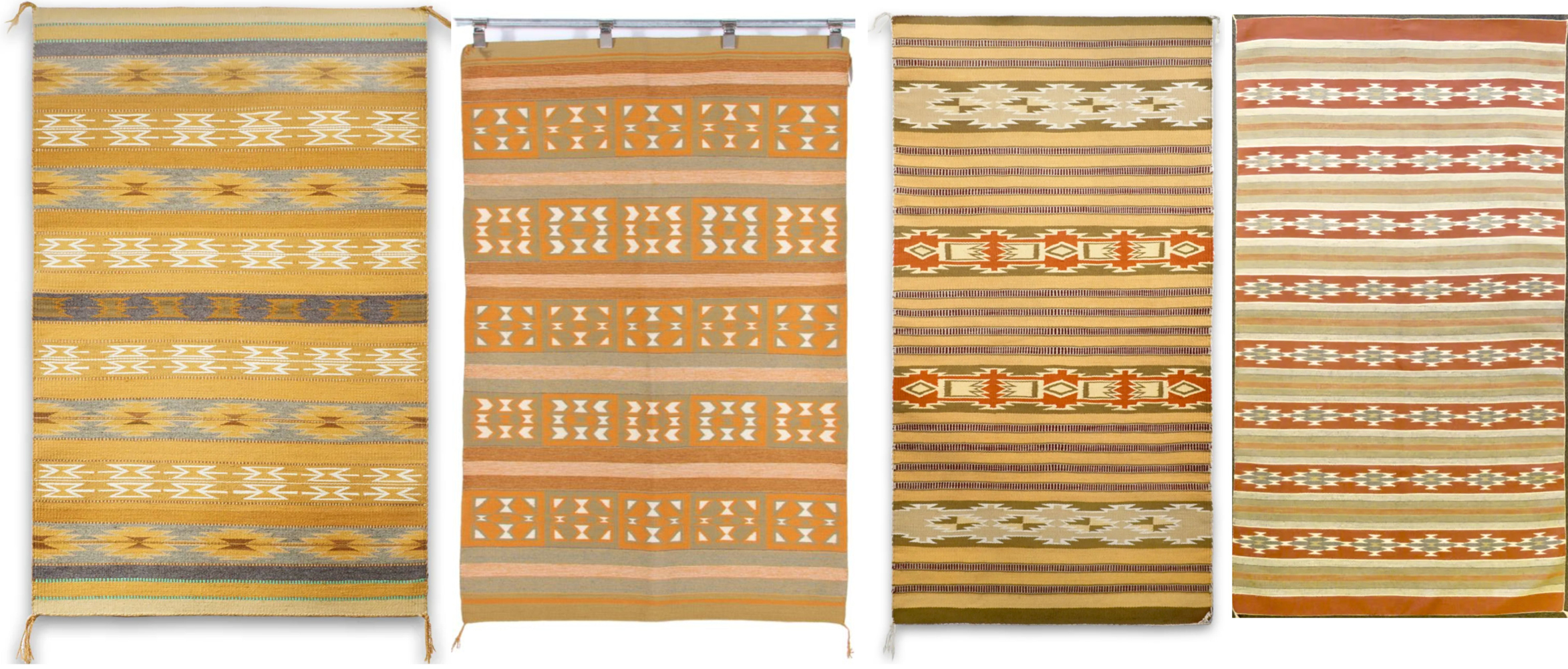
LEFT TO RIGHT
1. Crystal Rug made with vegetal dyes, second half of the 20th century. Dimensions: 47 x 30 in.; 119.38 x 76.2 cm. Chimayo Trading del Norte, Ranchos de Taos, NM.
2. Fine weave banded Crystal Rug by Glenna Bah Hardy, ca. 1970. Dimensions: 41 1/2 x 61 in.; 105.41 x 154.94 cm. Auctioned in 2023 by Sold: Ripley Auctions, Indianapolis, IN.
3. Crystal Rug made by using vegetal dyes only, second half of the 20th century. Dimensions: 128 x 53 in.; 325.12 x 134.62 cm. Chimayo Trading del Norte, Ranchos de Taos, NM.
4. Crystal Rug hand woven by Nonabath Harrison, ca. 1982. Dimensions: 45 x 79 in.; 114.3 x 200.66 cm. Toh-Atin Gallery, Durango, Colorado.
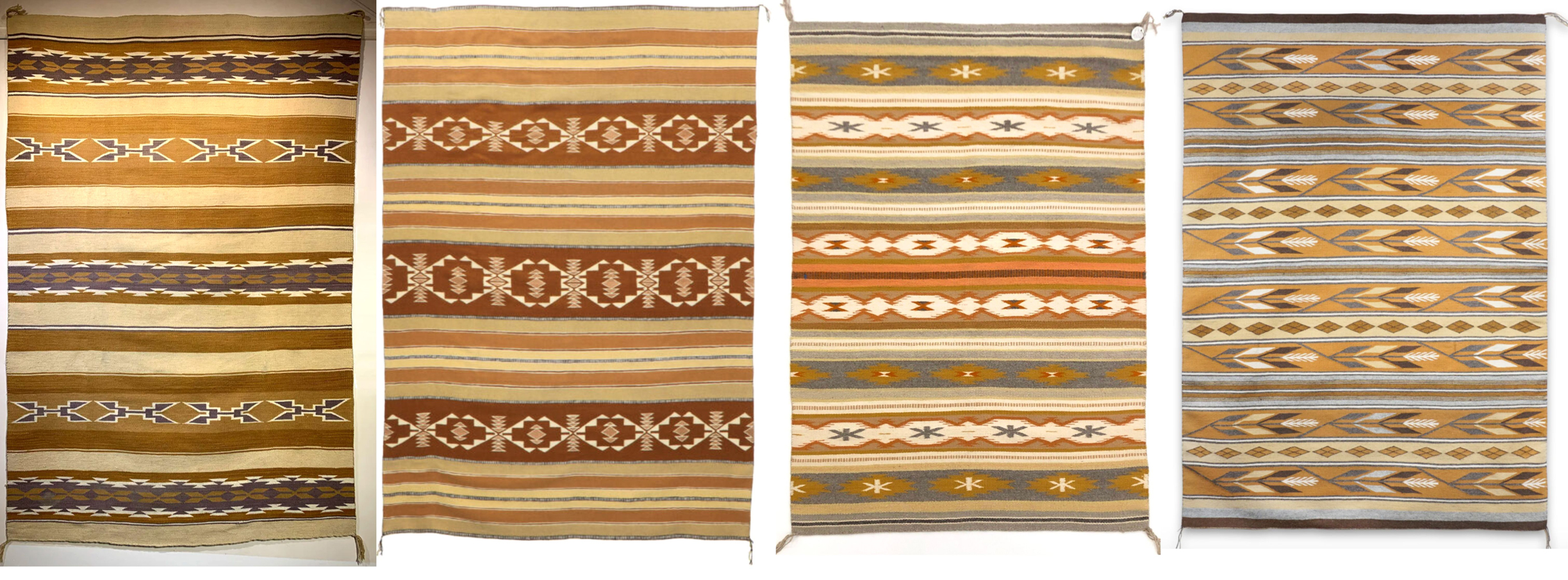
LEFT TO RIGHT
1. Crystal Rug woven with hand spun wool, treated with natural colors, and aniline dyes; ca. 1950. Dimensions: 73 x 48 in.; 185.42 x 121.92 cm. Chimayo Trading del Norte, Ranchos de Taos, NM.
2. Crystal rug made with vegetal dyed wool by Ella Rose, 1970s. Dimensions: 79 x 55 in.; 200.66 x 139.7 cm. Historic Cameron Trading Post since 1916, Cameron, Arizona.
3. Crystal Rug with beautiful coordinating colors, featuring many two-tone rows of running stitches which is very time-consuming to weave, 1950s. Dimensions: 52 x 36 in.; 132.08 x 91.44 cm. Auctioned in 2023 by Bradford's, Sun City, AZ.
4. Very fine Crystal Rug made with vegetal dyes and handspun wool, second half of the 20th century. Dimensions: 64 × 46 in.; 162.56 x 116.84 cm. Chimayo Trading del Norte, Ranchos de Taos, NM.
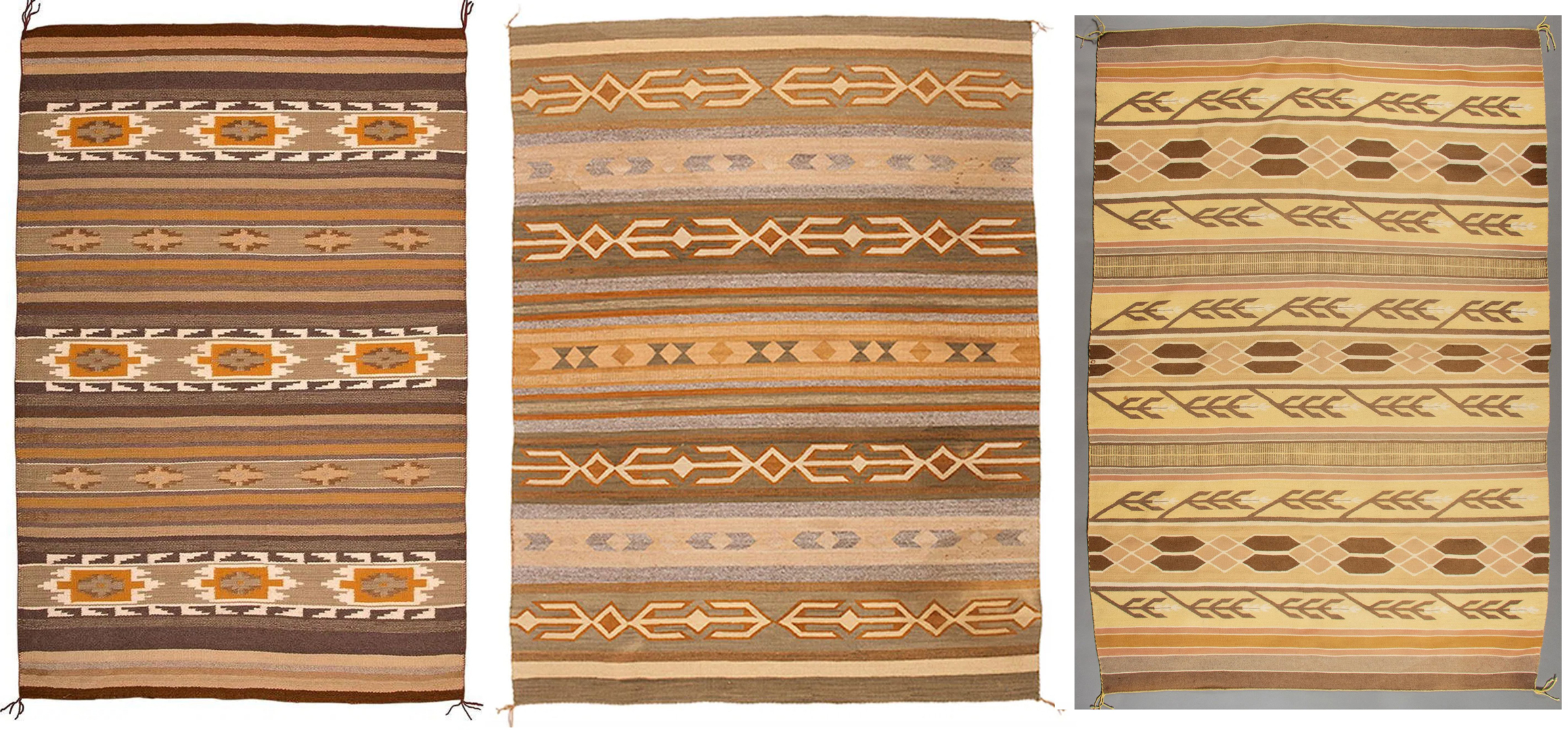
LEFT: Crystal Area Woven Rug by Timothy Livingston, nephew of well-known Navajo weaver Agnes Johnston. Dimensions: 5'. x 3'4"; 152.4 x 101.6 cm. Auctioned in 2023 by FREEMAN'S | HINDMAN, Chicago, IL.
CENTER: Crystal Rug woven in colors of gold, gray, and green; with bands of tuning forks and chevrons, mid-20th century. Dimensions: 76 x 58 in.; 193.04 x 147.32 cm. Auctioned in 2014 by Cowan's Auctions, Cincinnati, Ohio.
RIGHT: Super soft Crystal rug/blanket made with vegital dyes, 1950s. Dimensions: 82 × 57 in.; 208.28 x 144.78 cm. Auctioned in 2024 by LUSHER FINE ART & AUCTIONS, Santa Fe, New Mexico.
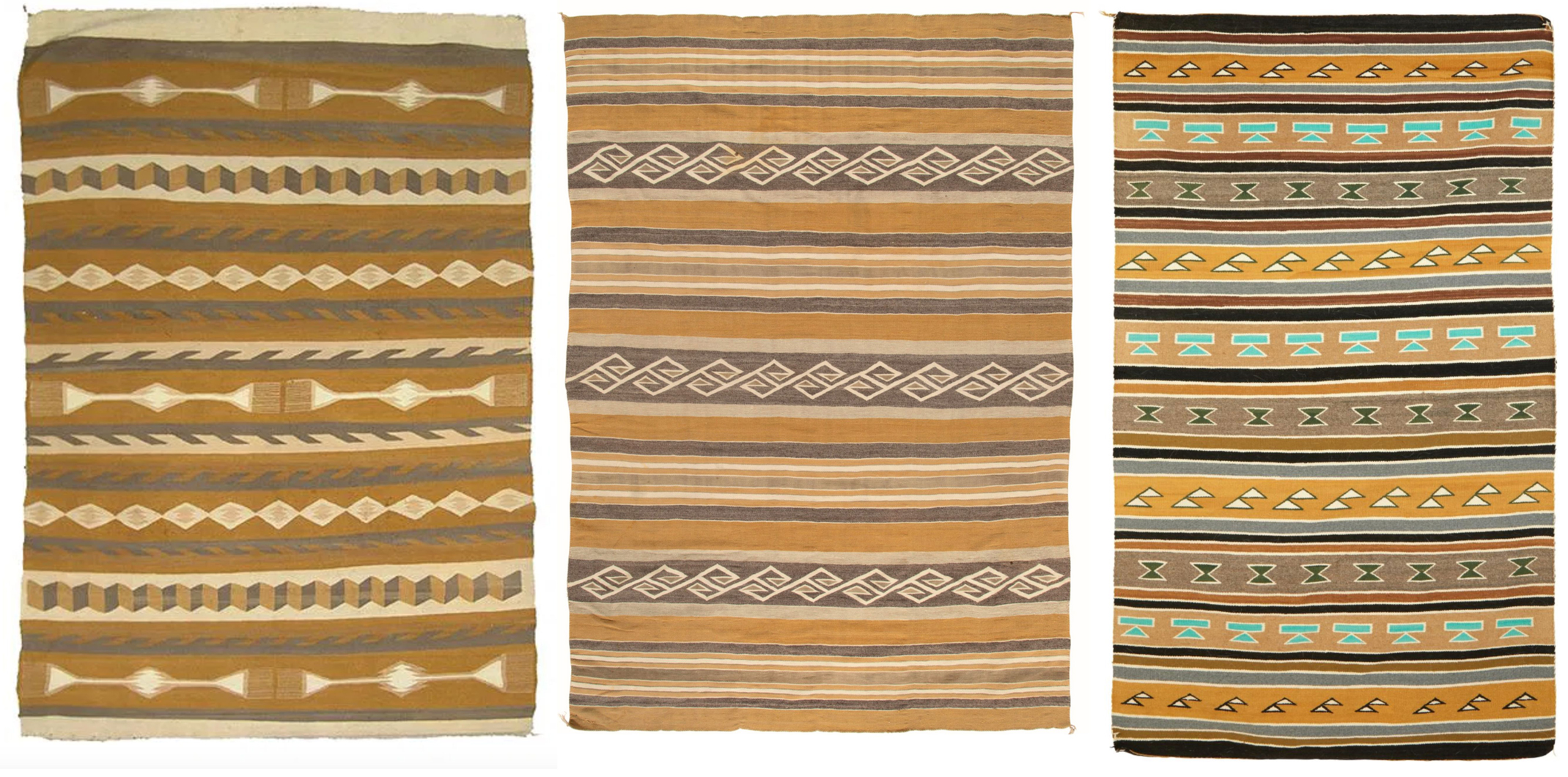
LEFT: Very nice, banded earth tone Crystal rug with optical elements and fine comb-like figures, 1940-1950s, Dimensions: 72 x 46 in.; 182.88 x 116.84 cm. Auctioned in 2014 by ALLARD AUCTIONS Inc., St. Ignatius, MT.
CENTER: Crystal Rug made with Navajo Churro handspun wool, vegetal and aniline dyes, сa. 1960. Dimensions: 103 x 71 in.; 261.62 x 180.34 cm. Auctioned in 2023 by Santa Fe Art Auction, Santa Fe, NM.
RIGHT: Crystal Rug, 1960s. Dimensions: 73 1/2 x 43 in.; 186.69 x 109.22 cm. Auctioned in 2022 by Santa Fe Art Auction, Santa Fe, NM.
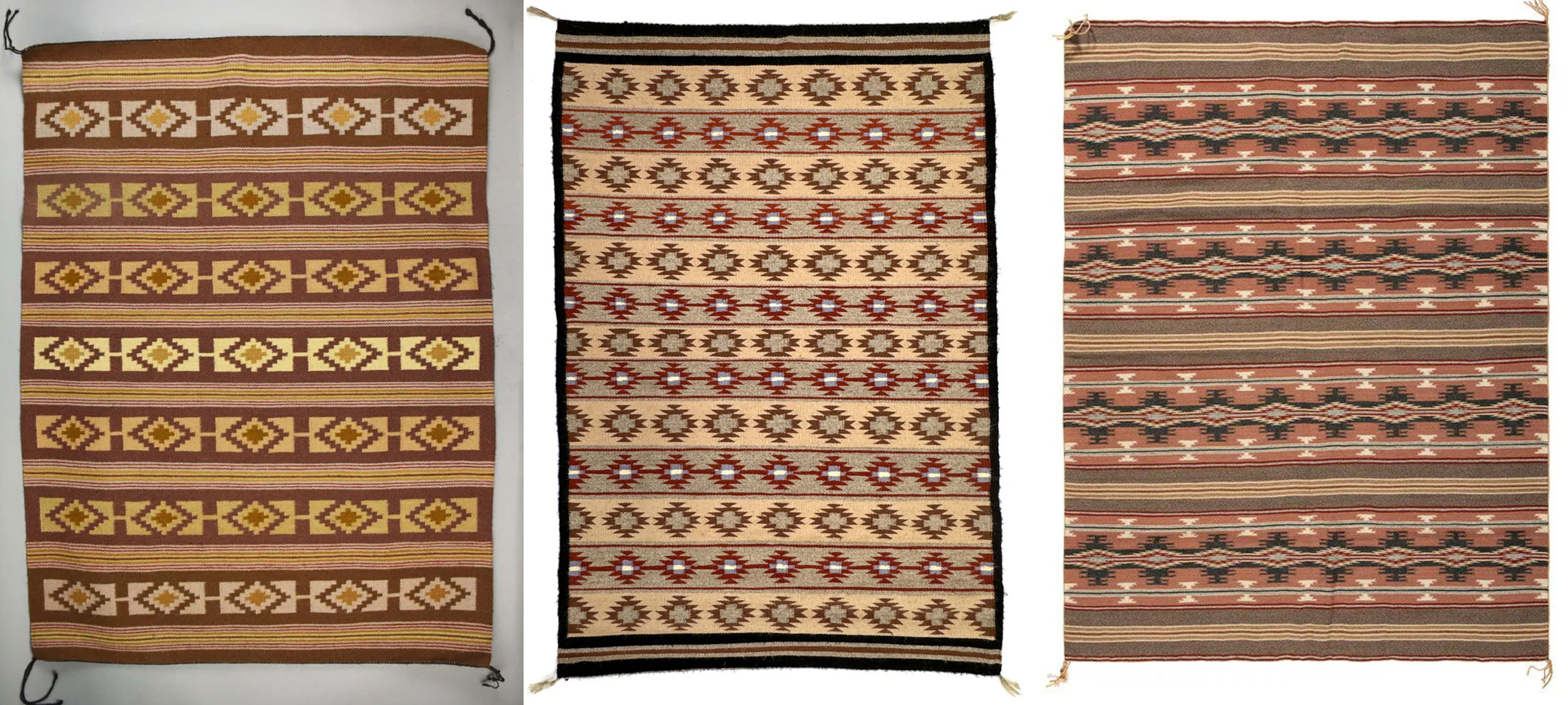
LEFT: Crystal Rug handwoven with home spun wool. Dimensions: 31 x 42 in.; 78.74 x 106.68 cm. Auctioned in 2023 by GOLDEN SUN AUCTIONS, Fullerton, CA.
CENTER: Crystal Rug, 1980s. Dimensions: 50.5 x 35 in.; 128.27 x 88.9 cm. Photo courtesy: Mark Sublette, Medicine Man Gallery, Tucson, Arizona.
RIGHT: Crystal Rug finely woven by Mary Johnson with handspun wool; mid-20th century. Dimensions: 59-1/2 × 49 in.; 151.13 x 124.46 cm. Auctioned in 2024 by FREEMAN'S | HINDMAN, Chicago, IL.
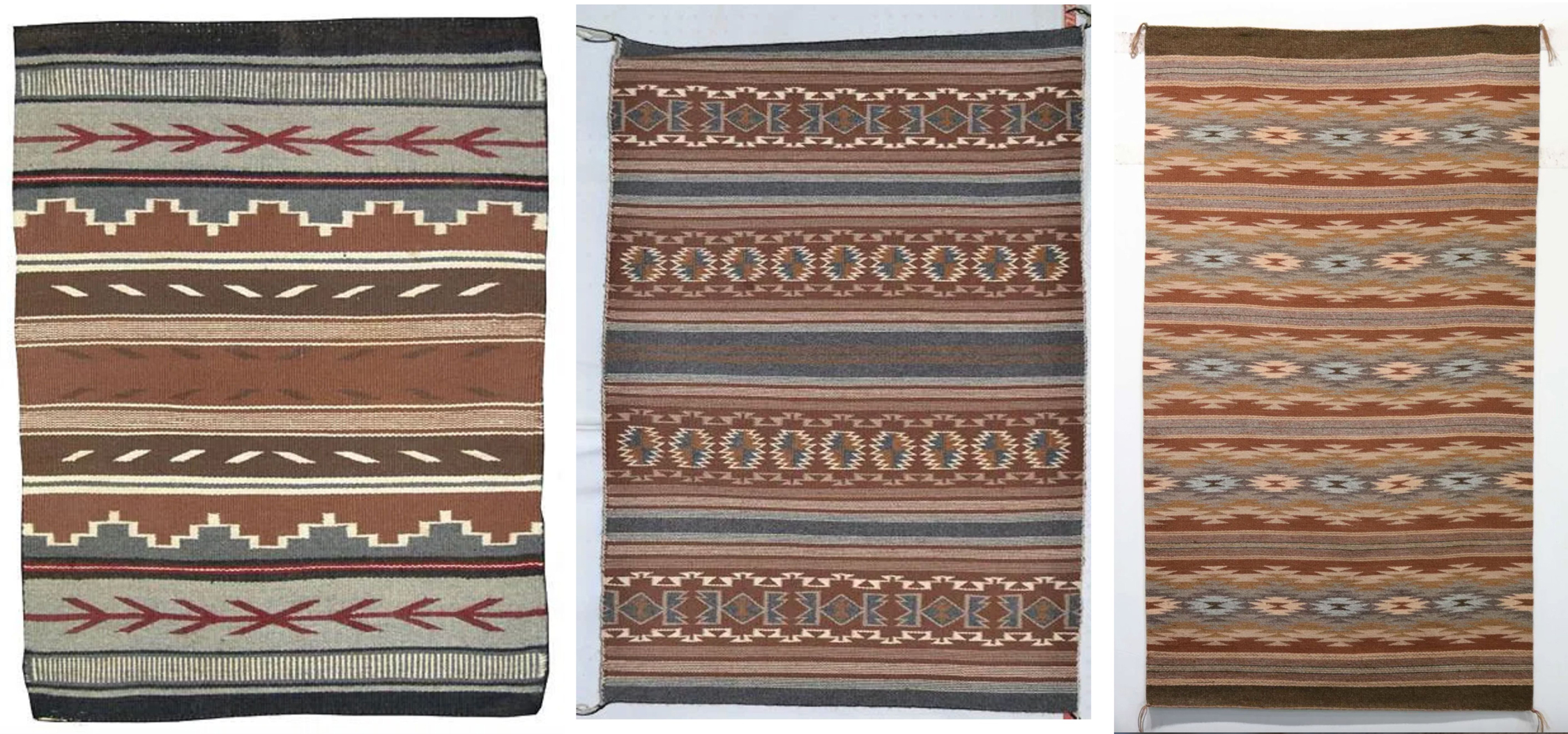
LEFT: Superfine banded Crystal Rug by Marietta Begay, 1970s. Auctioned in 2015 by Last Chance, CA.
CENTER: Navajo banded Crystal weaving rug with vegetal dyes in shades of brown, gray, cream, and gold, 1970s. Dimensions: 45 x 31 in., 114.3 x 78.74 cm. Auctioned in 2023 by RIPLEY AUCTIONS, Indianapolis, IN.
RIGHT: Crystal Rug made with natural wool yarns and vegetal dyes including black walnut dye by Lorraine T. Harrison, second half of the 20th century Dimensions: 37 x 65 in.; 93.98 x 165.1 cm. Garland's, Sedona, Arizona.
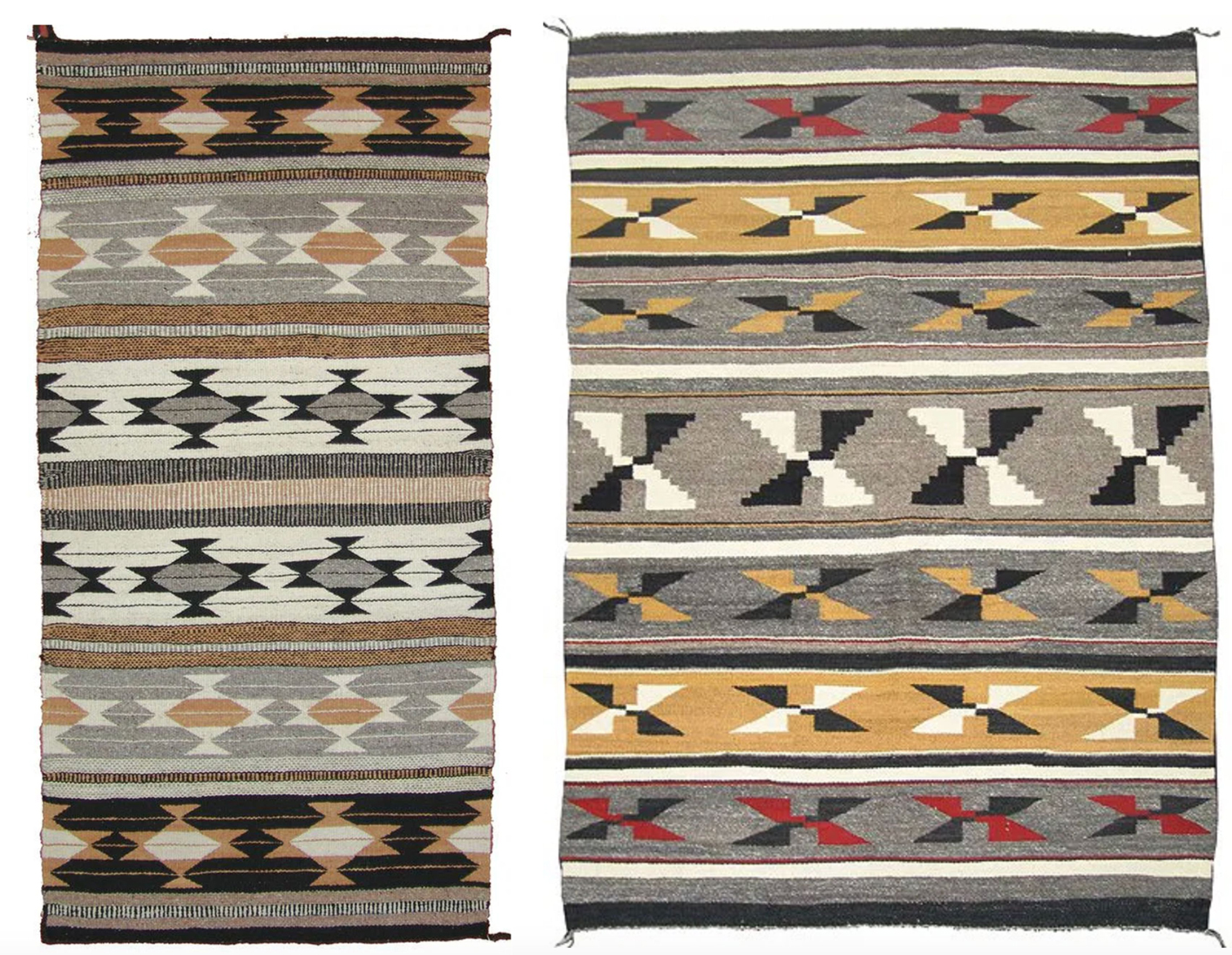
LEFT: Striking, banded Crystal rug with serrated forms and double weave bars, made from homespun wools in the 1970s. Dimensions: 63 x 31 in.; 160.02 x 78.74 cm. Auctioned in 2019 by ALLARD AUCTIONS Inc., St. Ignatius, MT.
RIGHT: Beautiful tight weave banded crystal rug with striking geometric symbols, mid 1900s. Dimensions: 63 x 43 in.; 160.02 x 109.22 cm. Auctioned in 2012 by ALLARD AUCTIONS Inc., St. Ignatius, MT.
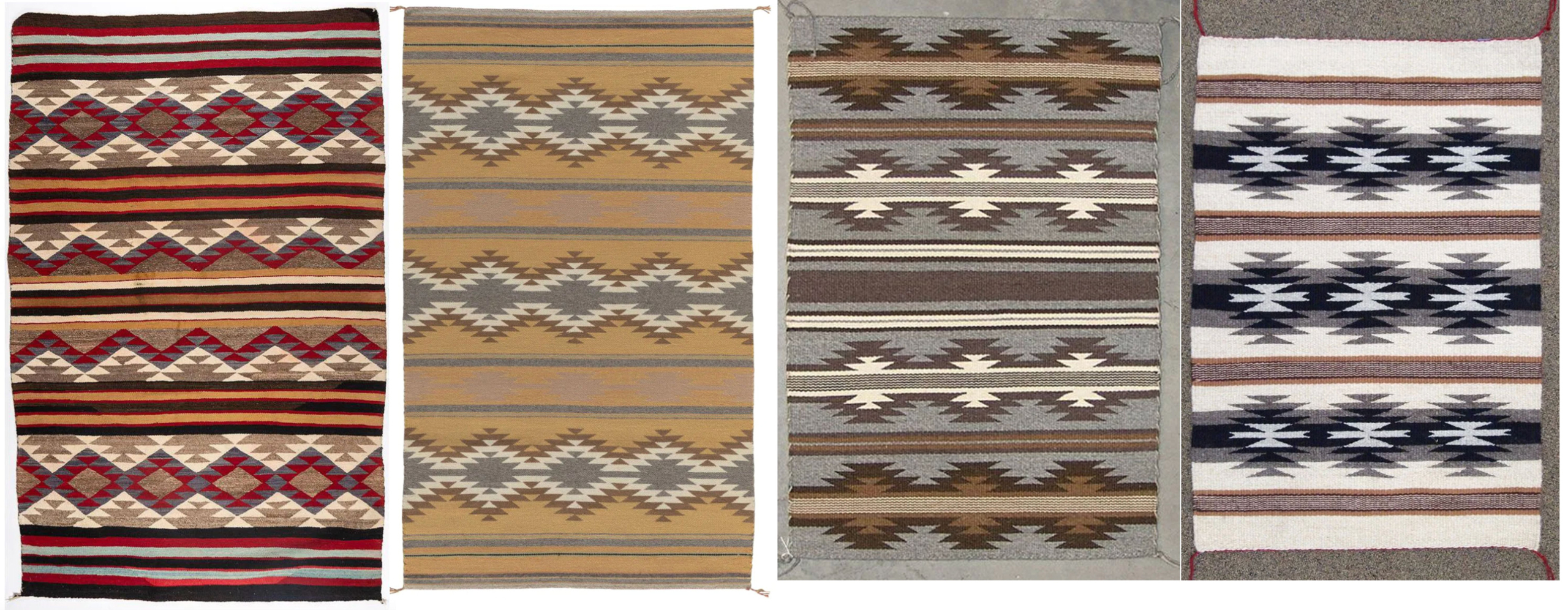
LEFT TO RIGHT
1. Crystal rug, woven in colors of dark yellow, red, grey, black, brown, cream, light blue, and dark blue; mid-20th century. Dimensions: 75.25 × 49.5 in.; 191.14 x 125.73 cm. Auctioned in 2020 by COWAN'S AUCTIONS, Cincinnati, Ohio.
2. Crystal rug made with Navajo Churro handspun and natural wool and aniline dyes, first half of the 20th century. Dimensions: 60 ½ x 36 ¾ in.; 153.67 x 93.35 cm. © 2022 Heritage Auctions, Dallas, Texas.
3. Extra fine weave small banded Crystal weaving with serrated elements and wavy lines, ca. 1980. Dimensions: 18 x 26 in.; 45.72 x 66.04 cm. Auctioned in 2014 by ALLARD AUCTIONS Inc., St. Ignatius, MT.
4. Black & Tan Crystal Rug by Alyssa Harrison. Dimensions: 29-1/2 x 20 in.; 74.93 x 50.8 cm. Auctioned in 2012 by Santa Fe Gallery, Santa Fe, NM.
Contemporary Production and Legacy
Modern weavers continue to draw inspiration from both the historical J.B. Moore patterns and the 1940s vegetal-dyed innovations, creating new banded iterations that honor the Crystal tradition while expressing individual creativity. The enduring popularity of the Crystal style, which has remained virtually unchanged since the 1940s transformation, testifies to the successful integration of vegetal dye techniques with the distinctive banded, borderless design that defines contemporary Crystal weaving.
«Again today there is a Crystal-type regional rug, but it is radically different from the old Moore style. In the newer pieces there are no borders. Designs are edge-to-edge bands of earth colors, which seem extracted from a painted desert landscape. In a single weaving there may be rusty red, chocolate, natural gray, milky green, and a pastel vegetal pink. Within some bands are simple, geometric, repeated designs such as flat triangles, rhomboids, arrows, and stars. In wavy-line bands an illusion of motion is effected by alternating two or three wefts of contrasting colors. Of all contemporary weaves, the Crystal type fits most quietly into mainstream home decor. Some present-day Crystal rugs are nearly square, but most are rectangular. The yarn is homespun, giving a nubby feel to the finished fabric.» (Don Dedera, Navajo Rugs: The Essential Guide, 3rd Edition 1996, Northland Publishing, Flagstaff, AZ)
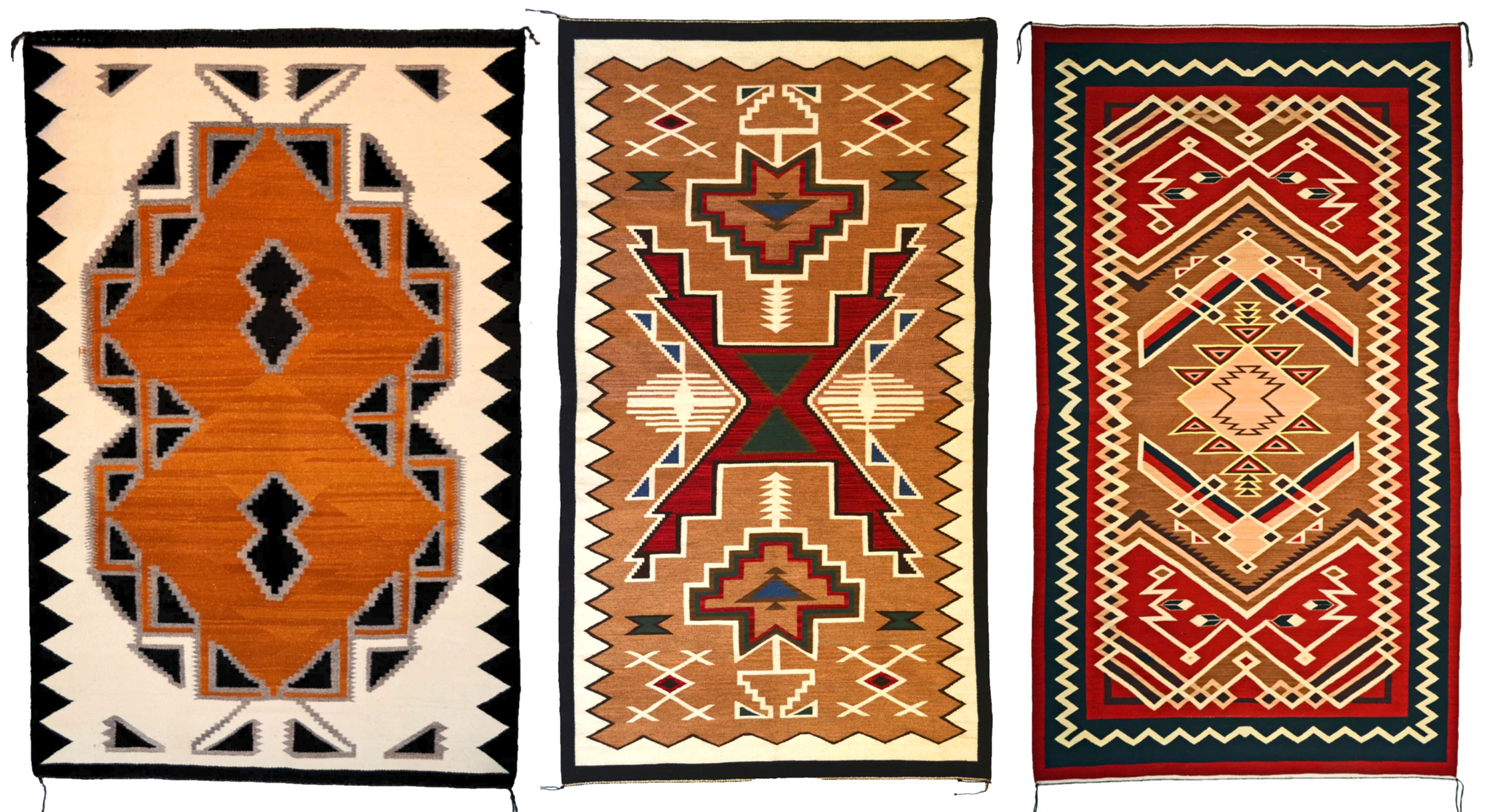
LEFT: Crystal Rug made with hand-spun Navajo Churro wool; heavy and durable weave from the 1980s. Its unique design incorporates traditional Navajo craftsmanship into modern design. Dimensions: 39 x 59.5 in.; 99.06 x 151.13 cm. Photo courtesy: Gail Getzwiller, owner of Nizhoni Ranch Gallery, Sonoita, Arizona.
CENTER: Amazing Crystal style Rug woven by Master Weaver Geraldine Phillips with 100% custom spun, hand dyed Navajo Churro wool. 2023. 1st Place (150) 2023 Gallup Inter-Tribal Indian Ceremonial. Dimensions: 43 x 73 in.; 109.22 x 185.42 cm. Photo courtesy: Gail Getzwiller, owner of Nizhoni Ranch Gallery, Sonoita, Arizona.
RIGHT: Contemporary hand woven Crystal Rug woven by Master weaver Geraldine Phillips in 2019 (one year on the loom). This intricate American Indian weaving incorporates the chain link element introduced to the Crystal area by J.B. Moore. Made with Navajo Churro wool. Dimensions: 49 x 86 in.; 124.46 x 218.44 cm. Photo courtesy: Gail Getzwiller, owner of Nizhoni Ranch Gallery, Sonoita, Arizona.
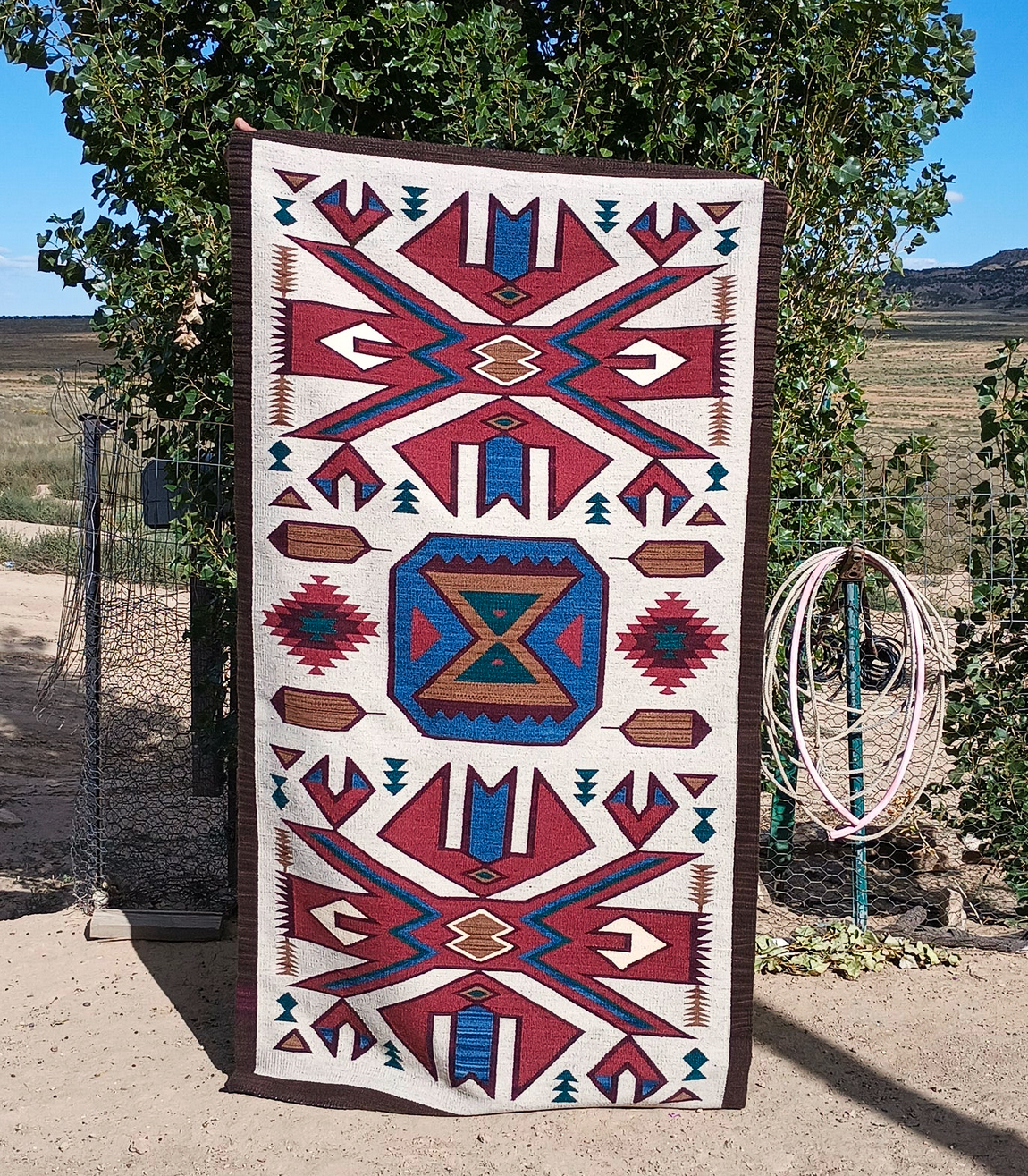
Innovative Navajo rug by Ervin Phillips (son of Geraldine Phillips), 2023, hand woven with 100% custom spun, hand dyed Navajo Churro wool. Dimensions: 42 x 76 in.; 106.68 x 193.04 cm. Photo courtesy: Gail Getzwiller, owner of Nizhoni Ranch Gallery, Sonoita, Arizona.
The contemporary Crystal banded and borderless style rugs rework the models that emerged in the second half of the century, experimenting with new patterns and new colors. The quality is often high and the precision of the design truly admirable—but this is something that can only be appreciated by seeing and touching a carpet in person.
BELOW
Contemporary new Crystal patterns
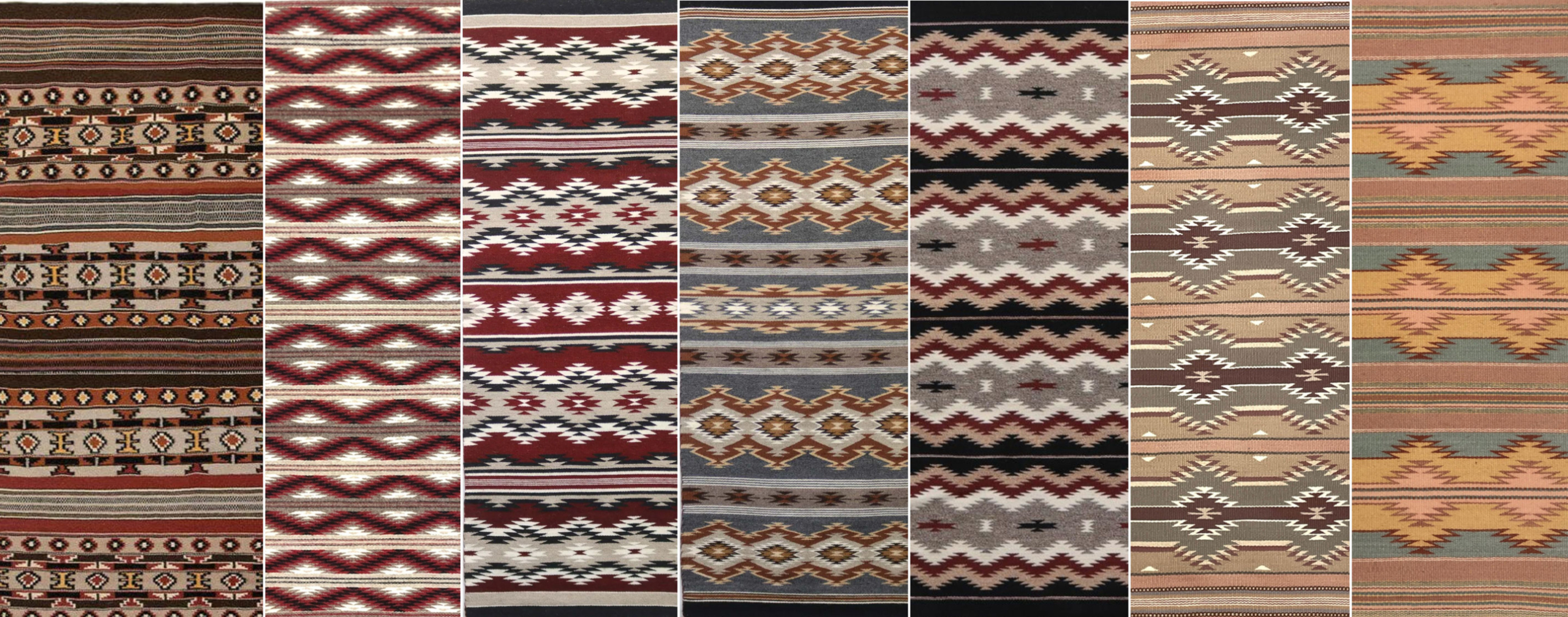
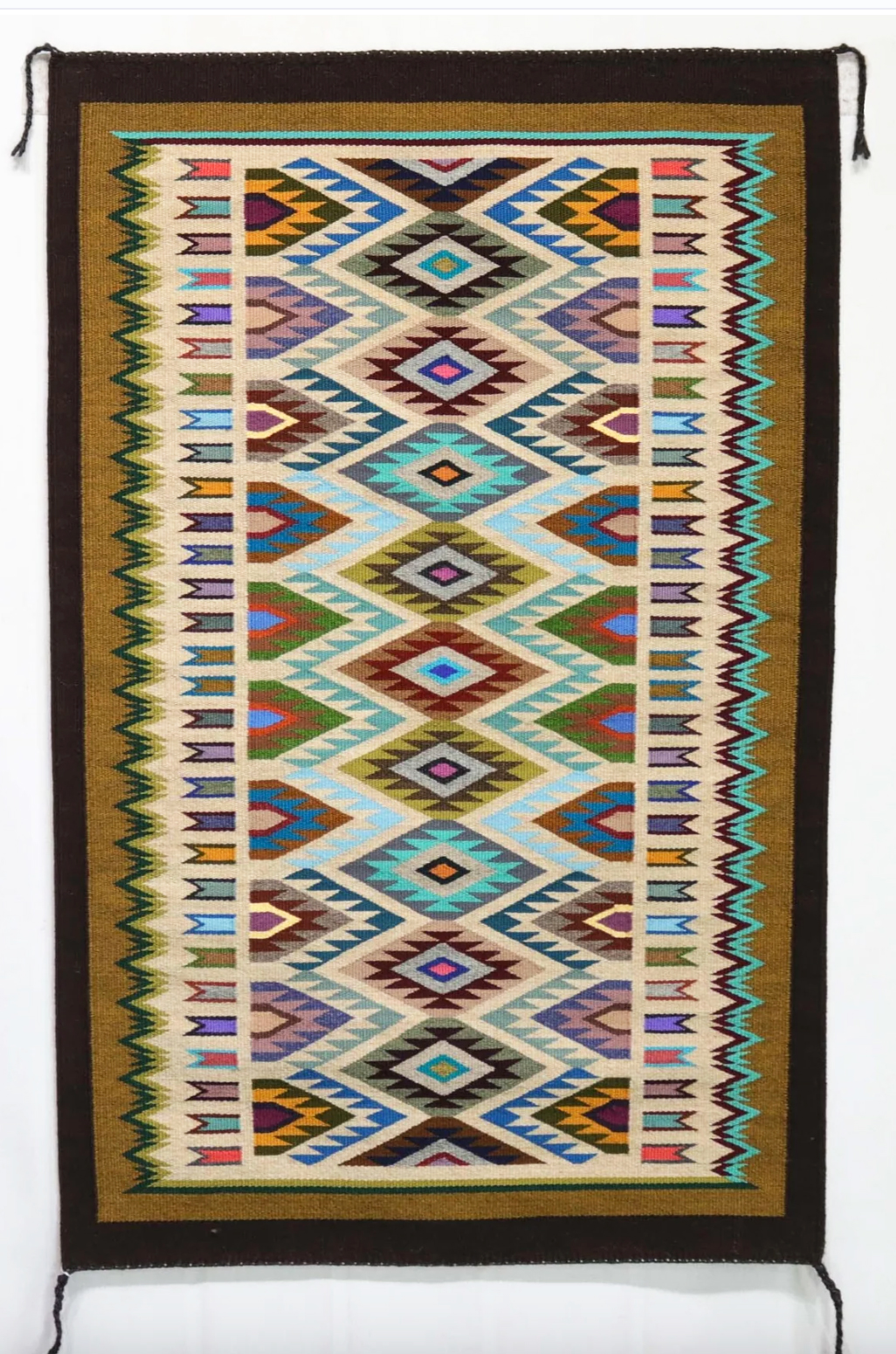
Navajo Weaving in a bright multicolored Crystal regional design, featuring a tea dyed border. Woven by Bessie Littleben. Dimensions: 26 x 41 in.; 66.04 x 104.14 cm. Garland's, Sedona, AZ.
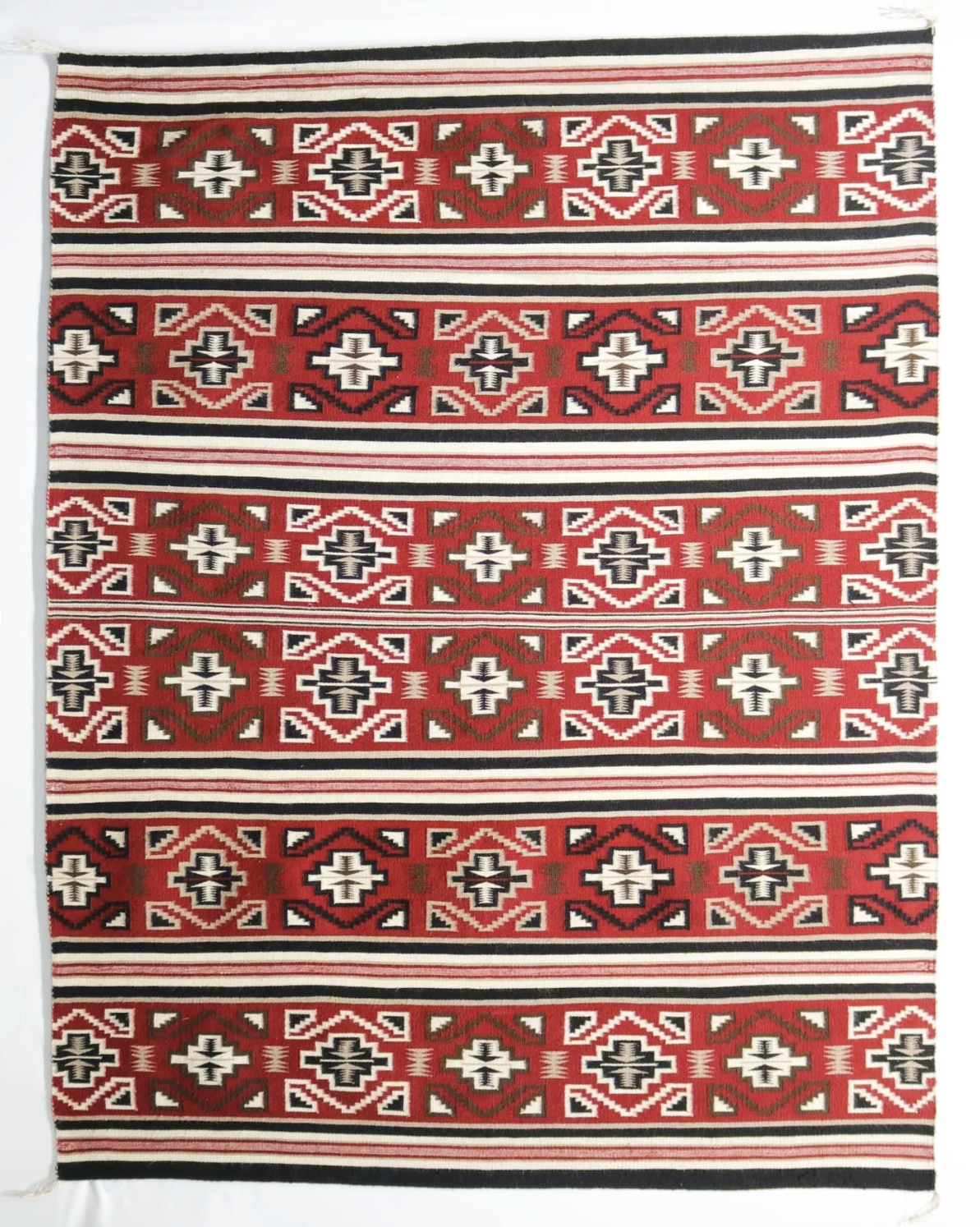
Banded Crystal Rug by Evelyn Begay, 1980s. Dimensions: 61.5 x 80 in.; 156.21 x 203.2 cm. Garland's, Sedona, AZ.
Master Weavers of the Crystal Style
Based on documented sources, several master weavers have distinguished themselves in the Crystal style from the 1970s to today, though the tradition has faced significant challenges due to economic and social changes.
«Two fine Crystal weavers of the 1970s were Mary Arthur and Faye C. George. Rivaling their work twenty years later are Priscilla Begay, Marjorie Hardy, Nanabah Harrison, Irene Clark, Sarah Begay, and Marie Brown.» (Don Dedera, Navajo Rugs: The Essential Guide)
Very few weavers maintain the traditional Crystal style, making the work of master weavers like Irene Hardy Clark and Alyssa Harrison even more significant in preserving this important cultural tradition.
Irene Hardy Clark stands as one of the most prominent Crystal style master weavers of the 20th century. Born in 1934 in Crystal, New Mexico, she belongs to the matrilineal clan Tábąąhá ("Water's Edge") and the patrilineal clan Honágháahnii ("One who walks around"). She's the daughter of master weaver Glenabah Hardy and continues the family tradition by weaving in the same Crystal style as her mother and grandmother. Irene learned through observation rather than formal instruction, watching her mother weave when she returned from herding sheep. Her mastery is evident in the fact that she sold her first rug for $400, demonstrating the exceptional quality of her work. She follows traditional methods, preparing her own materials, washing, carding, spinning the wool and collecting plants for dyeing. She also incorporates traditional Navajo weaving songs and prayers into every step of her process. Her works have been exhibited in several museums and art galleries of the Southwest.
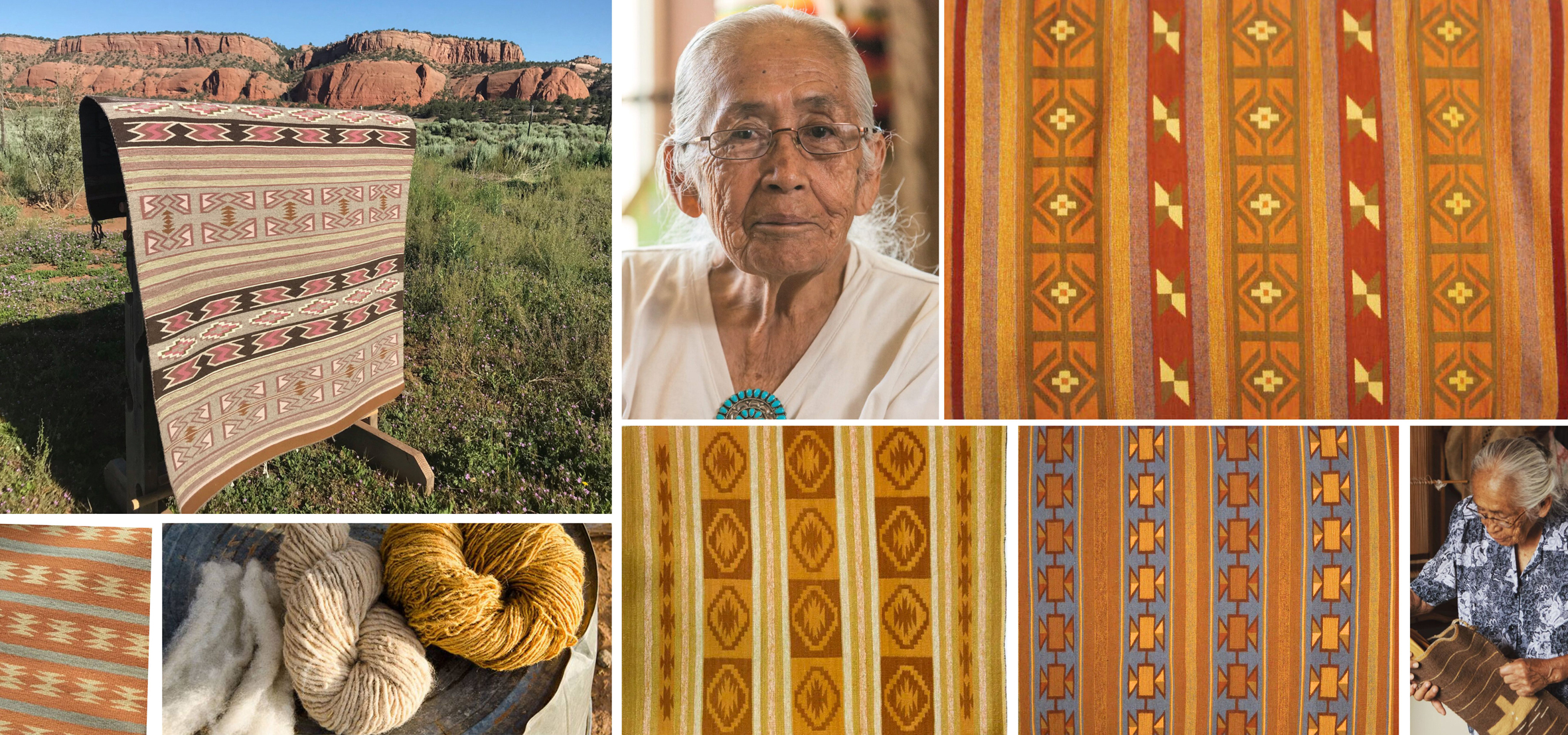
«I do my blessing before each rug. I thank Mother Earth for the plants that give color to my wool, for the sky above me, the air I breathe, for mother earth for grounding me. All this gives me a good feeling to weave. Everything is in the weaving, it’s in your hands, it’s in your weaving tools, and it’s in your mind. Design and dyeing are related to how you think of yourself, and it will show in how you weave your rug. Good thoughts, prayers, songs are what you need.» Irene Hardy Clark.
Alyssa Harrison is a contemporary Navajo weaver who learned the traditional art of weaving from her mother, Glorilene Harrison. This mother-daughter teaching relationship exemplifies the traditional matrilineal transmission of weaving knowledge in Navajo culture. Still today, Alyssa frequently collaborates with her mother on weaving projects, creating pieces that blend their combined expertise.
Alyssa works in multiple traditional Navajo weaving styles – Crystal, Wide Ruins, Chinle. She uses natural color palettes punctuated by contrasting colors like black and red yarns. Her work demonstrates exceptional technical skill, with her pieces featuring approximately 32-40 wefts per inch, creating very tight, well-made weaves. Her rugs typically measure around 49-70 inches and feature traditional finishing touches like red twisted tassels at the corners.
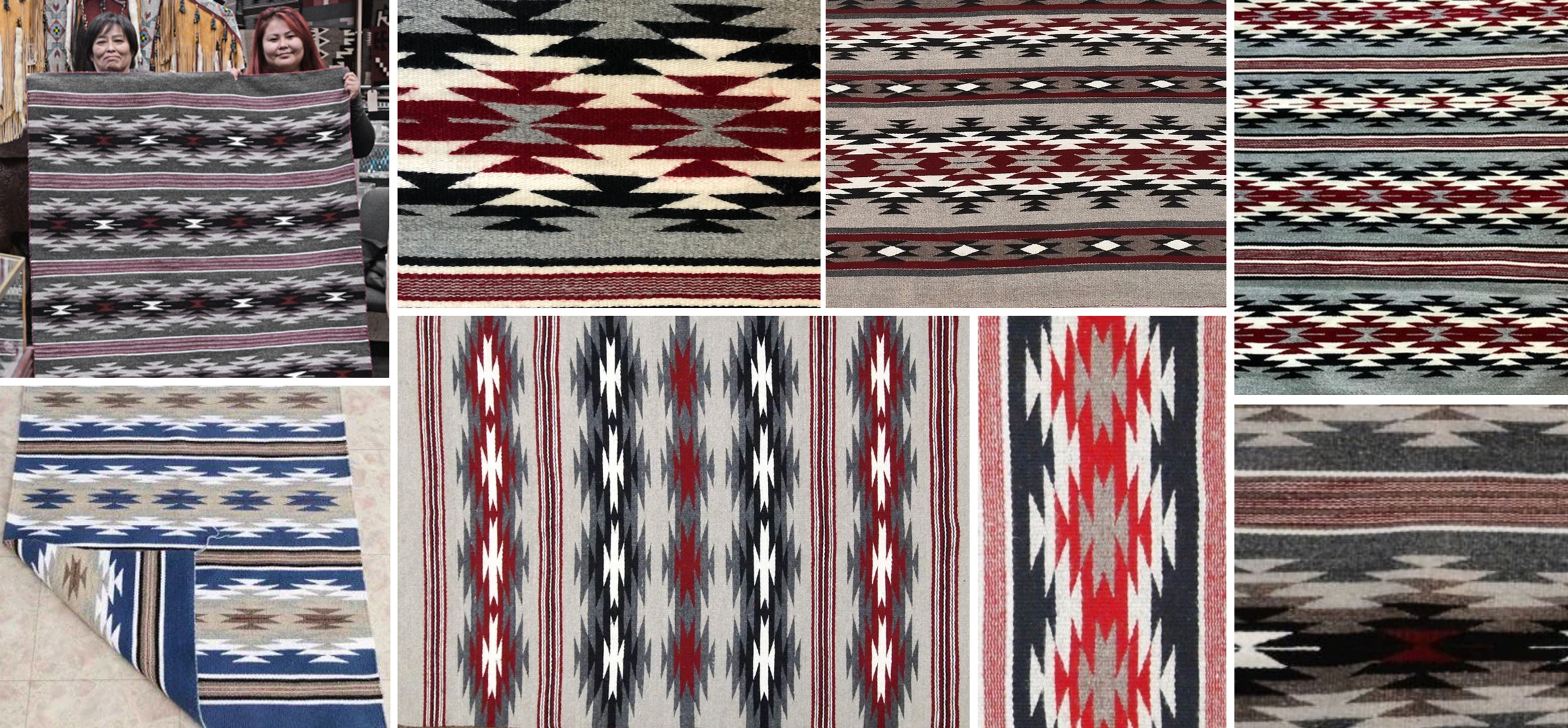
On top left, Alyssa Harrisone and her mother Glorilene.
Frances Begay (b. 1966) started weaving in 1982 at age 26, taught by her grandmother Mary Begay. Her Aunt Sara Begay specifically taught her the Crystal design. Frances has achieved significant recognition, winning many awards from the All Indian Inter-Tribal Ceremonial in Gallup, including the prestigious Joe Ben Wheat Award for Exceptional Design. She has created more than 109 pieces for the Navajo Churro Collection and describes her work spiritually: "Weaving makes me think of tradition and spirit. I always think of my late grandmother and Aunt when I weave".
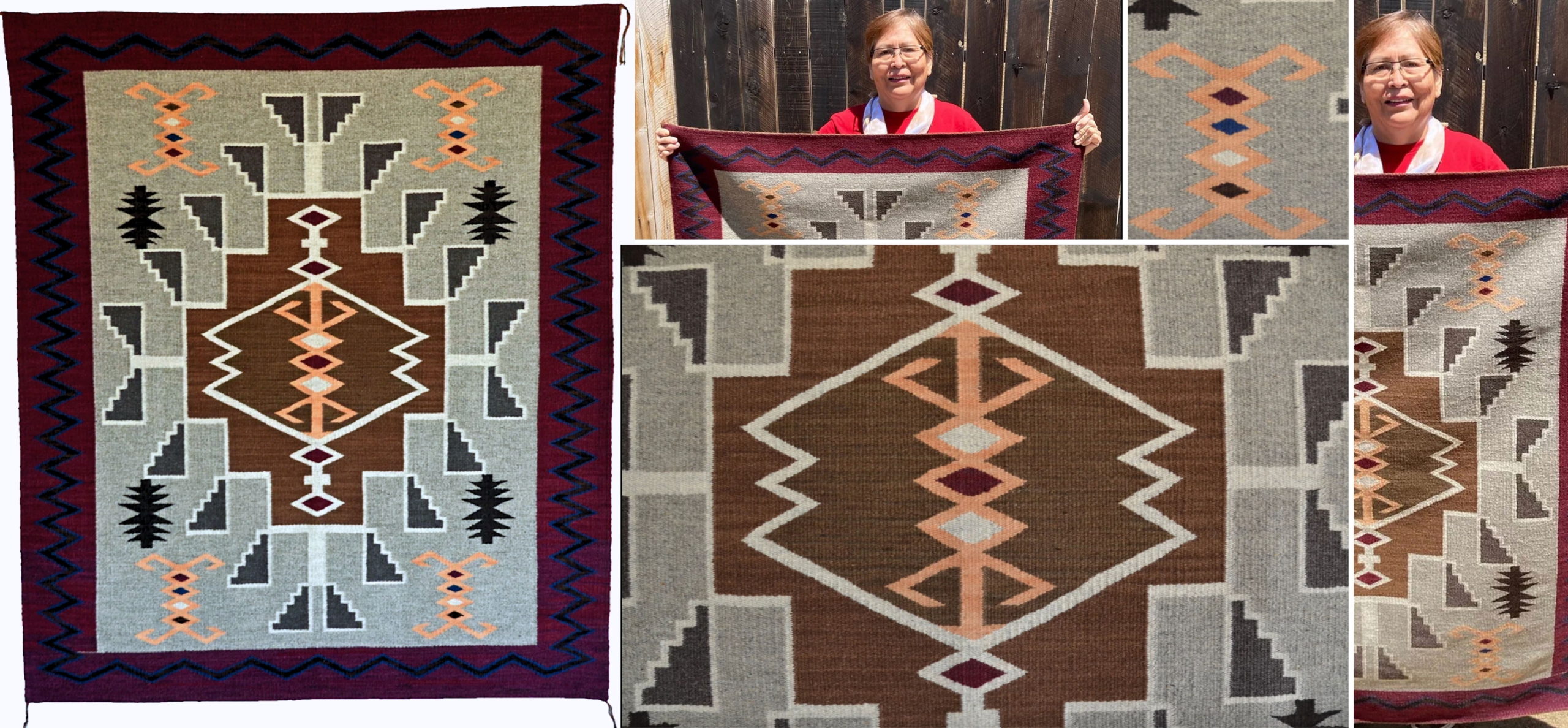
PLEASE NOTE: The Navajo weaver Frances Begay should bot be confused with Frances M. Begay, a jewelry designer and a silversmith who creates traditional Navajo jewelry featuring turquoise and sterling silver. This artist appears to specialize in petit point, cluster work, and other traditional Navajo jewelry styles. Below one of her amazing creations.
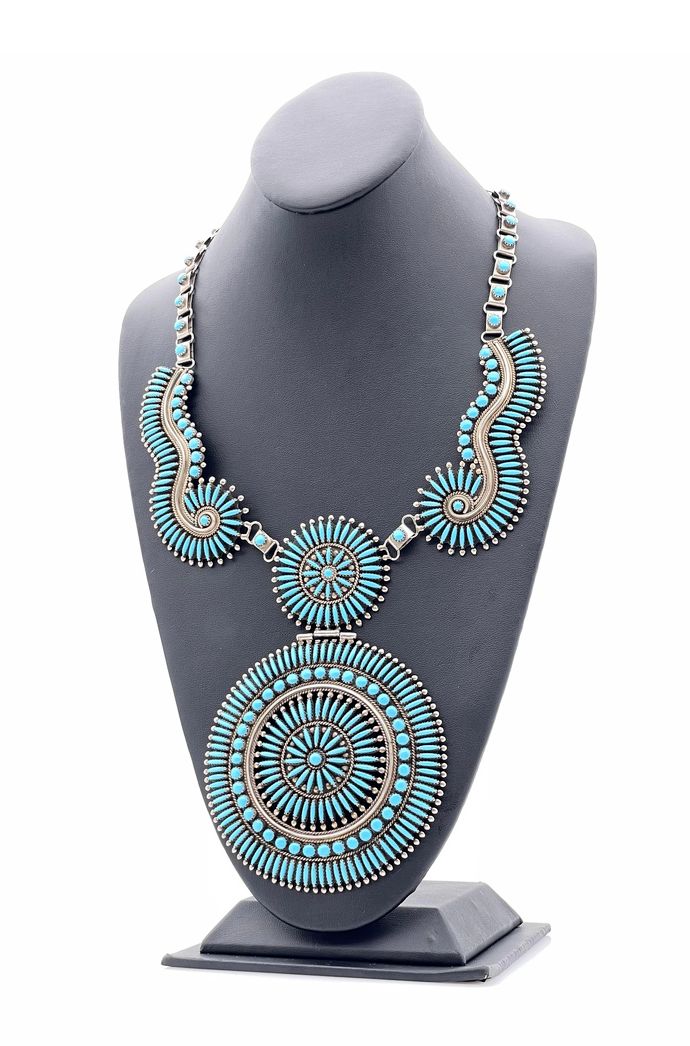
Navajo Sterling Silver Needlepoint Turquoise Necklace by Frances M. Begay. This piece is set with over 350 individual pieces of turquoise. The total length of the necklace is 24", with the diameter of the central pendant is 4". Net Weight: 169 g. Auctioned in 2022 for almost US$3,000 by Bradford's Auction Gallery, Sun City, Arizona.
Mona Laughing (b. 1945 is a distinguished Navajo weaver from Crystal, New Mexico, who represents the modern evolution of the Crystal weaving tradition. She learned to weave from her great-grandmother Elsie Mark in the early 1970s, establishing a direct lineage to traditional Navajo weaving knowledge, and has become a matriarch of contemporary Navajo weaving and exemplifies the modern Crystal style that emerged in the 1940s.
Her works feature vegetal dyes and banded designs without borders. She is particularly bold with color while maintaining the principle that "the colors must not clash. They must be harmonious". Her weaving incorporates the characteristic soft earth tones and pastels achieved through plant dyes, including onion skins for yellows, sage and yellow lichen for various hues, wild carrots and rabbitbrush for other colors, and red wine for specific tones.
Mona is a SWAIA fellowship winner and has been featured in prominent publications including "Native People," "Navajo Times," and "Native Art" magazines. Her exceptional skill and artistry have earned her recognition as an award-winning weaver whose textiles are held in museums and private collections worldwide.
As the matriarch of a weaving family, Mona has successfully passed on her knowledge to the next generation. She raised six children on the Crystal Reservation, supporting her family and sending all her children to college with proceeds from her weaving. Her daughters Charlene and Michele Laughing have both become accomplished weavers in their own right, with Charlene creating contemporary renditions of Crystal designs and Michele exploring Revival and Storm Patterns.
Remarkably, Mona has also taught the craft to her two sons, and her grandson Dwight Laughing Williams represents one of the few male weavers in the tradition.
A crucial aspect of Mona's work is her commitment to superior wool quality. She and her family maintain a flock of 31 churro and merino sheep, each with individual names, that they have bred over generations to produce the finest quality wool. This dedication to controlling the entire process from sheep to finished textile allows them to use only the finest parts of the wool for their weavings, contributing significantly to the exceptional quality of their work.

Mona Laughing. Photo courtesy: Garland's, Sedona, AZ
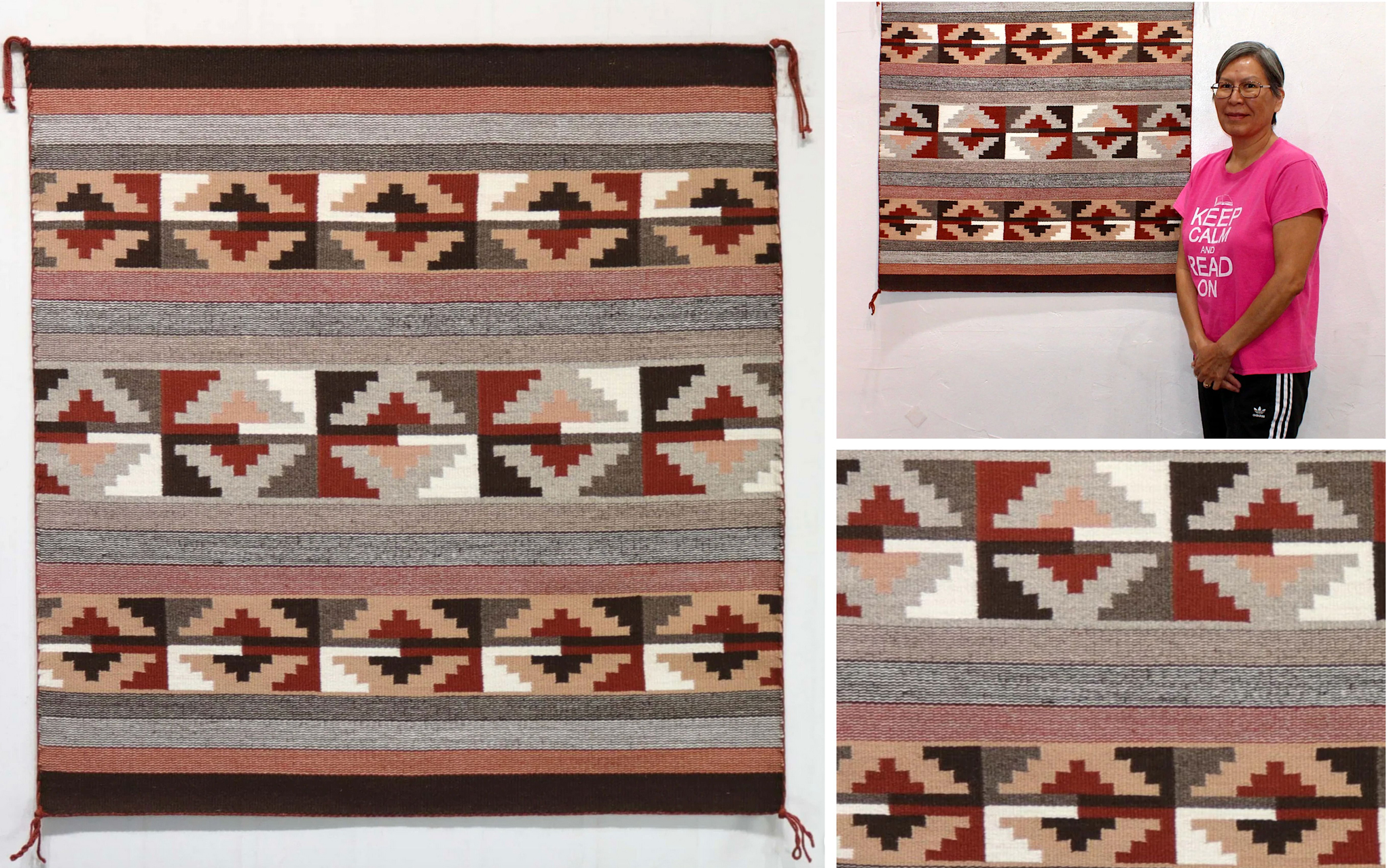
Michele Laughing. Photo courtesy: Garland's, Sedona, AZ
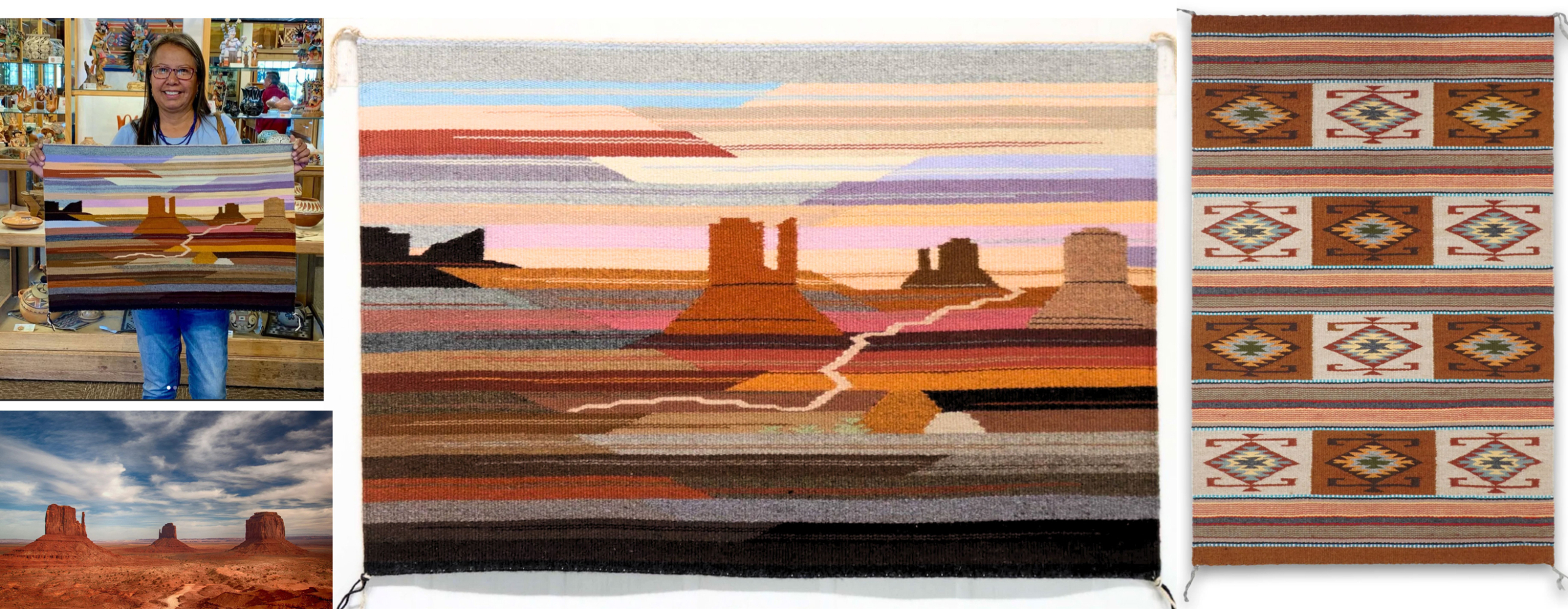
Charlene Laughing. Photo courtesy: Garland's, Sedona, AZ; Chimayo Trading del Norte, Ranchos de Taos, NM.
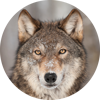
Alyx Becerra
OUR SERVICES
DO YOU NEED ANY HELP?
Did you inherit from your aunt a tribal mask, a stool, a vase, a rug, an ethnic item you don’t know what it is?
Did you find in a trunk an ethnic mysterious item you don’t even know how to describe?
Would you like to know if it’s worth something or is a worthless souvenir?
Would you like to know what it is exactly and if / how / where you might sell it?
